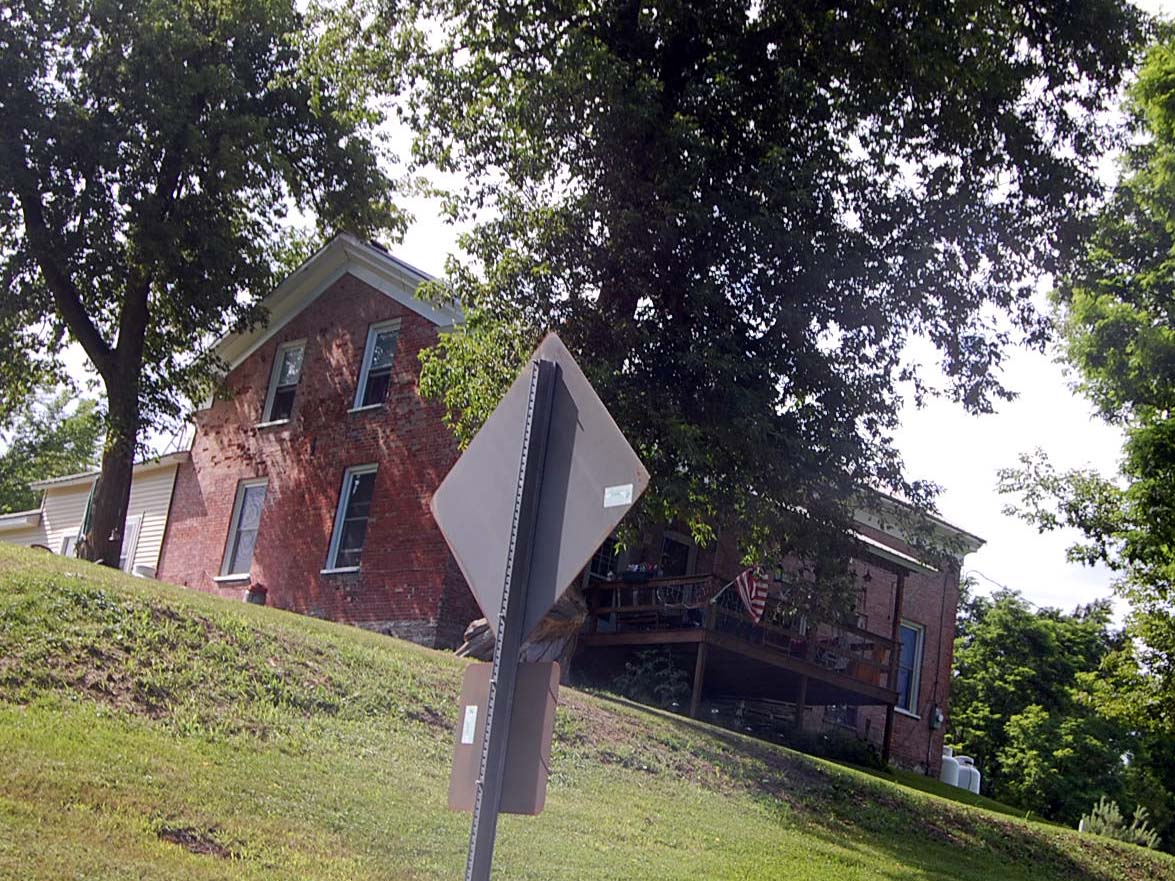|
STONE HOUSES, MANSIONS AND OTHER
OLD HOUSES |
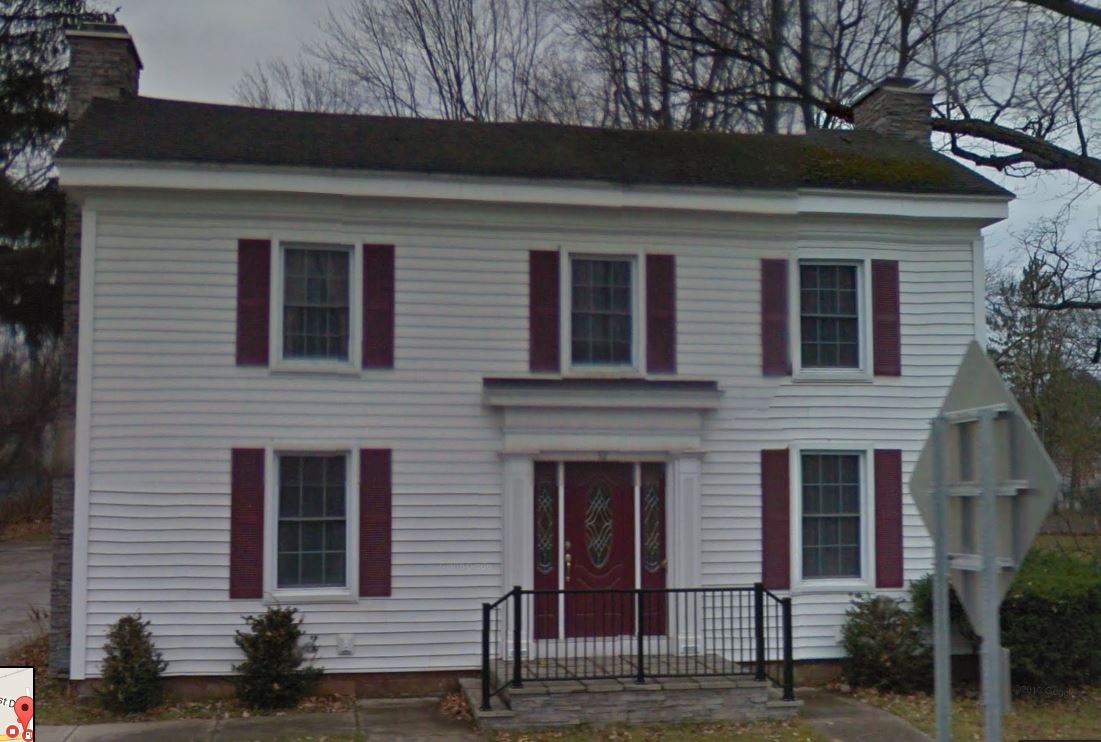
Three people of note lived in this house on the south side of East Main Street, Canton, while they were students in St. Lawrence university, including John Langdon Heaton, author and distinguished editorial writer of Joseph Pulitzer's New York World; his sister, Dr Lucia E Heaton, physician, north country feminist leader and close friend of Susan B Anthony, and Louis Heaton Pink, outstanding social leader, lawyer and humanitarian. The lot, upon which this beautiful old Georgian house stands, was once a part of the farm of Dr William Noble, Canton's first physician, and on November 13 1829 he sold the lot to Jairus Fenton for $75. On October 20 1839 Fenton disposed of it to Joseph F Blood for $80 and September 14 1841 Blood conveyed it to Theodore B Marvin for $125.
It is likely that Marvin built the house shortly after that, for on March 5 1844 he sold it to Theodore Caldwell for $800. On April 5 1848 Caldwell disposed of it to Mary Ann Cahoon and Sarah Clark for the same price. Sarah Clark inherited Mary Ann Cahoon's interest and August 12 1856 sold the place to Matthew A Whipple, John F Elmer, William Olin, Benjamin Olin Jr, George S Olin, Russell S Pond, Egbert Brainard, Aaron B Herrick, Asa M Eastman and Austin for $1,000 and on December 25 1858 they formally conveyed it to the trustees of the First Baptist Evangelical society for use as a Baptist parsonage, the grantees having bought it for that purpose.
On April 1 1871 the trustees sold it to Asa M Eastman for $1,500. On October 2 1871 Eastman sold to Maryette Smith for $1,700. Smith sold to Louisa C Olin November 23 1871 for $2,000 and she sold it to Ira Willmarth Heaton on August 9 1875 for $1,875. Ira W and Lucinda Langdon Heaton, children of the town of Canton's John Heaton and Peter Langdon, pioneer settlers on the Pierrepont road, bought this house and moved into Canton village from the Heaton homestead farm at Heaton hill that their children might be handy by the university.
Lucia Elizabeth entered that fall. In the fall of 1876 her brother, John Langdon, entered. Later entered Evelyn D, another sister, who later became the wife of Professor Bernard J Pink who came to Canton in the early 1880's to serve seven years as professor of French and German in St. Lawrence university. In the fall of 1900 his son, Louis Heaton Pink, matriculated and was graduated with honors in 1904.
Ira Willmarth Heaton died November 19 1894 leaving his widow a life-use of the house and then absolutely to his daughter, Lucia, who retained possession until her death October 16 1944 at the age of 88. She willed it to her nephew, Louis Heaton Pink, the present owner. Dr Lucia E Heaton, born June 18 1856 at the Heaton homestead farm, was graduated from SLU in 1879 taught school for a time, was g. iduated from the Woman's Medical college of the New York Infirmary for Women and Children in 1892 took a post-graduate course at the New York Polytechnic hospital and practiced medicine in Canton for several years, during which she was a member of the extension staff of Cornell and for many years was medical examiner of women students at SLU Friend of Susan B Anthony and Mary A Livermore, noted feminist leaders, Dr Heaton was an active worker for woman suffrage and for temperance. She was prominent in the League of Women Voters and the W C T U, a member of the Association of University Women, of Kappa Kappa Gamma and Phi Beta Kappa. She was the first woman member of the Canton board of education and for 31 years, prior to her death was a trustee of SLU
John Langdon Heaton, who spent much time in this house, was born at Heaton Hill January 29 1860 was graduated from SLU in 1880 taught school for a year, went to Brooklyn in July 1881 worked in the news and editorial department of The Brooklyn Daily Eagle for some years and in 1888 joined the editorial staff of The New York World under Joseph Pulitzer. There he remained until The World suspended February 27 1931 later going to The Vanguard Press. On The World John Langdon Heaton was associated with such notables as David Graham Phillips, George Cary Eggleston, E W Osborn, Frank I Cobb, Sam Moffett, J W Clark, Allen Nevins, Claude Bowers, Walter Lippmann and Charles Merz. He was married to Eliza Osborn Putnam, newspaper and syndicate writer, was the father of two children, and the author of "The Story of Vermont," "The Quilting Bee," and "The Story of a Page," which was a history of The New York World. Louis Heaton Pink, nephew of Dr Lucia E Heaton and of John Langdon Heaton, was born in Wausau, Wisconsin, December 14 1882 son of Professor Bernard J and Evelyn Heaton Pink. When Louis was born his father was district attorney of Marathon county, Wisconsin. A native of Germany, the elder Pink was a graduate of the University of Berlin.
After leaving Canton the Pinks established in Brooklyn, where Louis was graduated from the Erasmus Hall High school in 1900 and entered St. Lawrence university, where he was a member of Beta Theta Pi, an excellent scholar and star basketball player. After graduation in 1904 he was engaged in social work in Brooklyn, was admitted to the bar in 1907 was married to Miss Hazel Kelley of Gouverneur in 1908 was head worker of the United Neighborhood Guild in Brooklyn in 1909 appointed by Governor Smith to the state housing board in 1927 was made state superintendent of insurance by Governor Lehman in May, 1935 resigned in December, 1942 to become president of the Associated Hospital Service of New York, was elected a trustee of the New York Savings bank in June 1943 made a life trustee of SLU in 1940 appointed director of the New York Defense Rental area in November, 1943 and chairman of the Citizens Conference on International Union in 1945. He is the author of a life of Mayor William J Gaynor and the father of Austin K Pink and Lucia Millham.
Gothic in type, and said to be the only one of this type in Canton, this house on the east side of Court Street has had an interesting history. For over 84 years of its existence it has been owned by the Conkey family, first by Dr Jdhas S Conkey, prominent Canton physician and citizen; later by his son, George Sheldon Conkey, 20 years treasurer of St. Lawrence university, and now by George S Conkey's son, Dr Ogden Fethers Conkey. All three Conkeys, father, son and grandson, have had close identification with St. Lawrence university.
It was probably about 1847 that the house was constructed, and by Barzillai Hodskin, a leading Canton citizen actively engaged in promoting the industrial, mercantile and residential growth of the community. Except for recent front entrance alterations the house is most attractive in appearance with its diamond-paned windows. June 11 1827 David C Judson, another wealthy village promoter, sold the lot upon which this dwelling stands to the children of Medad Moody, one of whom, Horace, acquired the interests of the others for $150 on October 16 1843. On October 21 1846 Horace Moody disposed of it to Barzillai Hodskin for $300. A house was undoubtedly erected upon it by Hodskin and sold by him to George W Goodrich May 16 1864. Three years later, September 23 1867 George W and Mary A Goodrich sold it to Dr Jonas S Conkey for $4,000.
Dr Conkey died May 16 1883 willing it to his children, George S Conkey, Mrs Ogden Hoffman Fethers and Mrs Mary Adelaide-Fry. The-latter two conveyed their interests to George S Conkey, who died May 31 1929 giving life-use to his son, Dr Ogden Fethers Conkey, and then to latter's children. One of the early settlers of the town of Canton was Jacob Conkey, father of Dr Jonas Conkey, and one of the members of the Canton Universalis! society when it was formed in 1829.
In 1842 Jonas S Conkey located in Antwerp, got his MD from Geneva Medical college in 1845 and practiced over a score of years in Antwerp. There he was elected supervisor in 1852 a trustee and president of the village when it was incorporated in 1853 was one of the original trustees of Antwerp Liberal Literary Institute chartered February 1 1856 and became president of the board. After removing to Canton he joined with Dr R R Sherman in the pharmacy firm of Conkey & Sherman on Main Street, became a St. Lawrence university trustee in 1867 and president of the board in 1871 serving until his death, was village president in 1872 member of the village board of education and treasurer of St. Lawrence Lodge, No. 111, F & A M
His son, George Sheldon Conkey, born in Antwerp in 1863 got his BA
from SLU in 1883 succeeded his father in the ownership of the pharmacy,
was married to Miss Annette Homer of. Antwerp, became a trustee of St.
Lawrence university in 1895 serving until his death at 66 May 31 1929 was treasurer of the university from 1899 to 1920 vice president of the
board 1924- 1929 trustee of Clinton Liberal Institute 1901-1920 director
of the First National Bank 1903-1929 and president of the bank board 1926-1929.
His wife died April 29 1928 at 65 and in their
last years they traveled extensively in the Orient collecting rare laces
and objects of art, which they exhibited in their home.
Mrs Frances Conkey Fethers, who acquired this house November 21 1911 and lived in it until her death August 19 1917 was a sister of George S Conkey. She had choice Oriental rugs, Italian vases, paintings, pitchers, teapots, lustre ware, Chinese and Japanese china. Her husband, Ogden Hoffman Fethers, prominent Zanesville, Ohio, lawyer and one time head of the Knights of Pythias, was given an LLD, by SLU in 1896 and died in 1911. Under the will of Mrs Fethers, George S Conkey and his son, Dr Ogden Fethers Conkey, received $61,043.66 each. Born in Canton, Dr Ogden F Conkey attended the local schools and was graduated '08 at SLU where he belonged to Beta Theta Pi.
In 1912 he received his MD from Columbia Medical college, was instructor in obstetrics at New York university 1919-1922 and at Cornell Medical school 1922-1925
Later he was on the Bellevue hospital staff and resided in Jackson Heights.
He is now retired and resides in this house in Canton. It is said that
John Pickens, who had been a prominent Heuvelton merchant, came to Canton
when the Bank of Canton was formed in 1862 to be connected with it, and
resided in this house. His twin daughters, Bessie and Jessie possessed
beautiful voices, sang in the choir in Heuvelton, later went into vaudeville
and then moved to the operatic stage. Bessie attracted the attention of
the great Jean de Reszke and studied under him in Paris before joining
the
Metropolitan opera under the name Bessie Abott. In the summer of 1912
she married T Waldo Story, noted sculptor. Her sister, Jessie, engaged
in teaching music, married Colonel Henry Hamilton M Lyle, noted surgeon,
April 16 1919 he becoming professor of clinical surgery at Cornell and
dying March 11 1947. Mrs Frances J Pickens, mother of Bessie and Jessie,
died August 4 1928 at 87.
She was a grand-niece of Dr Benson, archbishop of Canterbury. Her husband, of distinguished South Carolina ancestry, was descended from Brigadier General Andrew Pickens of Revolutionary fame and of Gov. Andrew Pickens of South Carolina, who was a colonel in the War of 1812.
Hammond Tour Brochure:
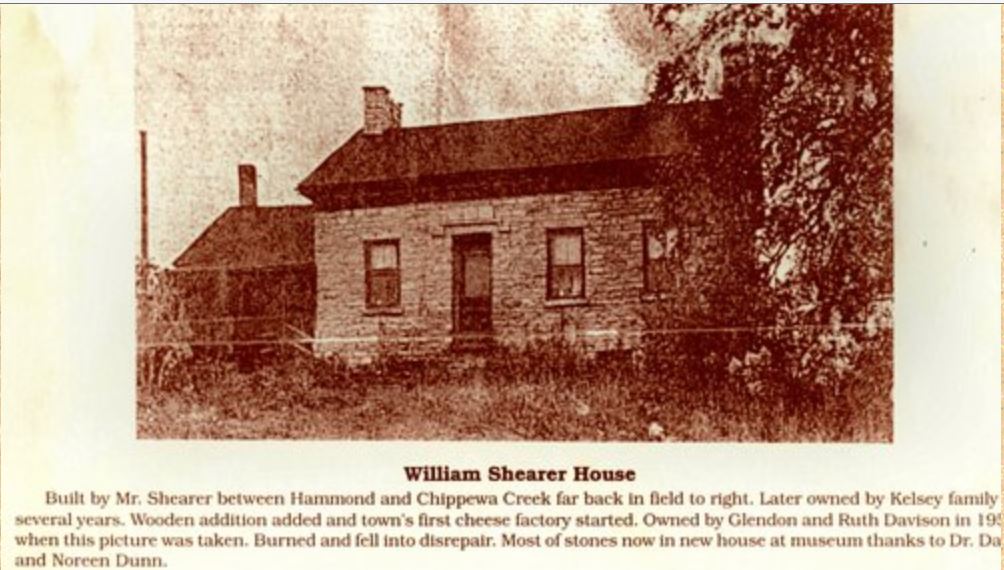
Fell into ruins, and was reclaimed and next door is the Hammond Museum.
Unpretentious though this native sandstone house is, it has a substantial history, a history of almost three quarters of a century ownership by the historic Kelsey family.
It is located on the Oak Point road in the town of Hammond, St. Lawrence
county, and is believed to have been built by William Shearer shortly
after he purchased 55.5 acres on the east side of the road from George
Parish, land-owner and North Country promoter. Elias Kelsey, descendant
of William Kelsey who was one of the founders of Hartford, Connecticut,
had previously
bought 134.55 acres of adjoining land from Andrew P Wilson on March 18 1862 and on March 27 1868 acquired another 40 acres on the other side
of the road from Bezaleel W Smith. Later he got about 45 more acres and
sold off some small lots. Mr Kelsey, who was a cheesemaker as well as
a farmer, added to this house a kitchen, pantry, bedroom, shed and room
for making and curing cheese, piping water into the house from a spring
about half a mile away.
When Mr Kelsey conveyed the property to his son, Earl J Kelsey, retired school principal, June 21 1897 the farm contained 281.01 acres. The son installed a furnace, hardwood floors and other improvements, and upon his death November 22 1932 he willed it to his wife, Ella J Wiggins Kelsey. She died January 13 1939 leaving the place to her nephew John W Kilborn, who sold it December 10,1945 to Loudon K Daniels and on April 22 1946 he disposed of it to Glendon Murray Davidson, the present owner. Mrs Davidson is the former Miss Ruth E Palmer, daughter of Mr and Mrs Henry Palmer, town of Oswegatchie, and was married to Mr Davidson March 21 1935 at Ogdensburg.
Elias Kelsey, prominent Hammond farmer, was born at Harrisburg, Lewis county, February 19 1826 son of Oliver and Polly Flanders Kelsey. On March 2 1854 he was married at Malone to Miss Clarissa Ann Hildreth, daughter of Walter and Clarissa R Hildreth, and resided in Harrisburg until he removed to Hammond about 1866. There he made cheese about 20 years and devoted the rest of his time to farming. He died February 10 1914. Of his six children, Eva, Ethelinda, Harmon E, Earl J, Carlton Ray and Bertha Ruth, wife of John Patterson, all are deceased but the latter, who resides with her husband near Ogdensburg and is prominent in music and social activities.
Oliver Kelsey, father of Elias Kelsey, was born at Newport, New Hampshire, in 1780 or 1871 son of Roswell and Hepzibah Bellows Kelsey. Married to Polly Flanders they made their way by oxcart through the wilderness to Harrisburg in 1803 where Oliver died May 17 1840 on his farm, his wife dying February 25 1851. They were parents of ten children.
Roswell Kelsey, father of Oliver, was born at Killingworth, Connecticut, March 13 1743-4 son of Benjamin and Ruth Wilcox Kelsey. On July 18 1771 Roswell married Hepzibah Bellows at Newport, New Hampshire, where he had moved from Killingworth in 1765. He was the father of twelve children and in 1760 served with his brother Absalom in Captain Peleg Redfield's company in the French and Indian war.
Benjamin Kelsey, father of Roswell, was born at Killingworth January 20 1710-11 son of Stephen and Concurrence Hayden Kelsey, and was a twin brother of Joseph Kelsey. On April 29 1741 Benjamin married Ruth Wilcox at North Killingworth. He died December 15 1752 father of six children.
Stephen Kelsey, father of Benjamin, was born March or May 17 1682 at Killingworth, son of Lieutenant John and Hanna Disborough Kelsey. On January 12 1704-5 he married Concurrence Hayden, was the father of eight children, and died April 23,1728.
Lieutenant John Kelsey, son of William and Bethia Kelsey, was born about 1636 probably at Cambridge, Massachusetts, where his father, native of England, had come with Reverend Thomas Hooker in the Braintree or Hooker company. Shortly after his birth John removed with his parents and the Hooker company a hundred miles through t he trackless forest to Connecticut where his father became one of the founders of Hartford. In 1664 Lieutenant John and family moved to Killingworth, where he became one of the original proprietors and died July 22 1709. His wife died October 23 1718. They were parents of nine children. His youth was spent in Hartford where he was made freeman May 20 1658 and October 14 1686 was made ensign of the Killingworth train band. Later he was promoted to lieutenant. William Kelsey, born about 1600 in England, left there about 1632 when Reverend Thomas Hooker, non-conformist clergyman, was compelled to flee to Holland with practically his entire group of parishioners. They planned to settle at Mt. Wollaston south of Boston, but on account of the Massachusetts Bay Colony policy of concentration were compelled to locate at Cambridge, but they liked not the location and moved on to Connecticut in June 1636 with permission of the colony.
There they founded New Towne, which name was changed to Hartford February 21 1637. Upon the Founders' monument in the old cemetery of the First Congregational church of Hartford may be seen the name of William Kelsey along with that of Reverend Thomas Hooker and the others. But, having been worsted in a religious dispute with the group William Kelsey and 26 others moved to Killingworth in March 1663. To him most of the many northern New York Kelsey families trace their descent, one of those descendants having been Eber Kelsey, born at Killingworth in 1763 founder of Kelsey's Mills, now Port Leyden, Lewis county in 1797. From thence he moved to Cape Vincent, where he made the first 50-acre clearing for LeRay , built a small wharf, erected a blockhouse, dwelling, barn and tavern, a stone structure known as Kelsey's hotel on Market Street, built the stone Deer Lick farmhouse now owned by J Reginald Newton on the Pleasant Valley road and died at the age of 80.
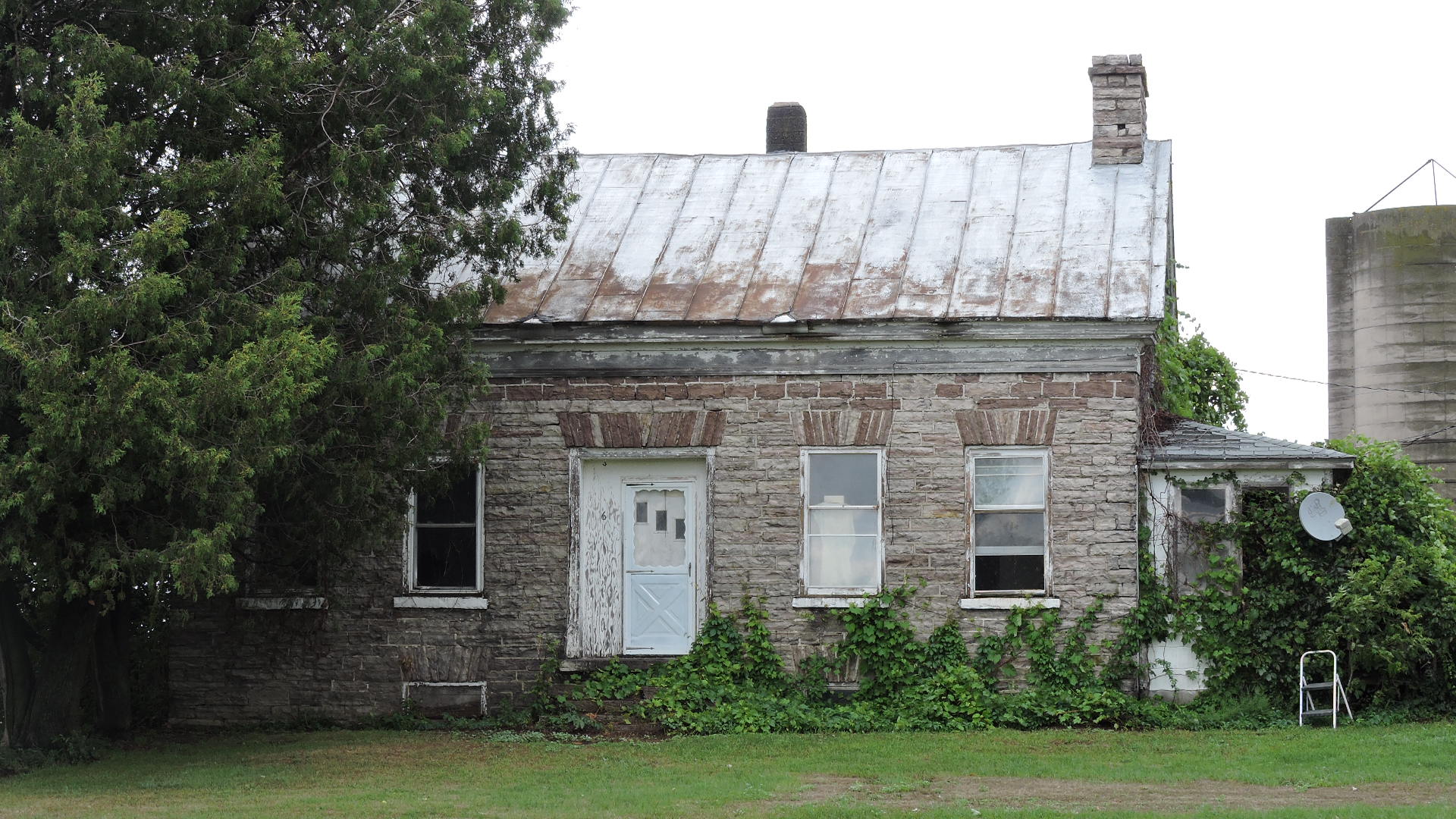
HAMMOND TOUR BROCHURE:
It was across the road from the JAMES MORE HOUSE. James More was born in 1823 and at the age of 11 came to America from Scotland via Canada. He married in 1850 Elizabeth Rodger, on of thirteen children of William and Nancy Rodger of Kelso Scotland. James became a prosperous farmer and businessman and for a short time leased the A P Morse Stone Block in Hammond. He served as the 18th supervisor of the town.
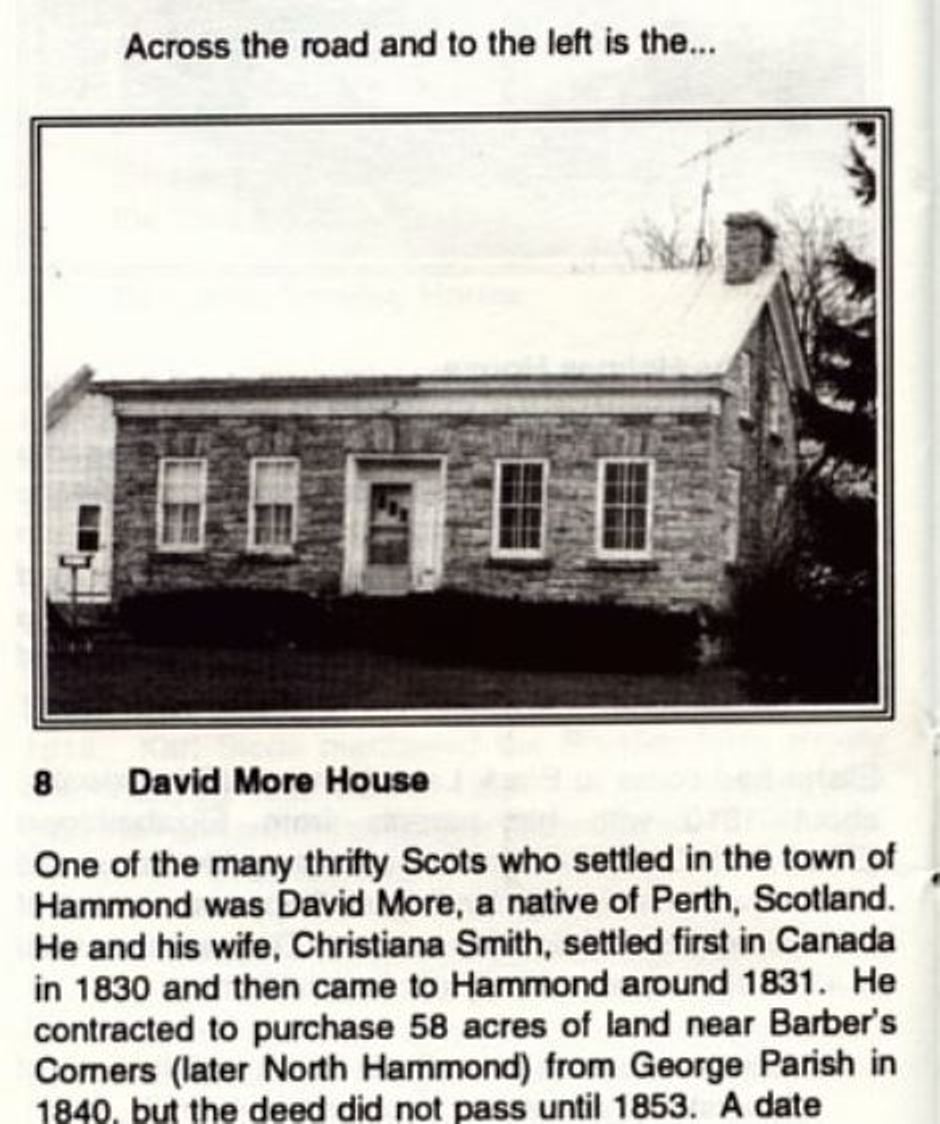
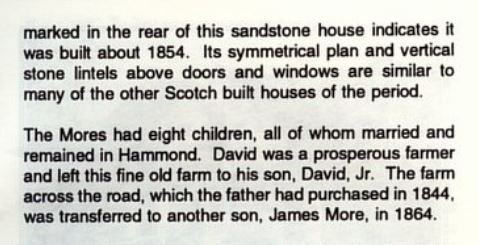
Something about the terrain of certain sections of St. Lawrence county must have reminded them of their own bonnie Scotland, for to those sections a century and a quarter ago Scotchmen were drawn as Mecca attracts the Moslems.
The town of Hammond was one of these magnets and there settled James S More and his parents about 1830. He was one of eight children born near Perth, Scotland. His birth was March 1 1823 and when he was six emigrated with his parents and seven brothers and sisters to America, tarrying about a year at Granville, PQ, before locating in Hammond.
One of the St. Lawrence county histories credits James S More with having bought the initial 76.21 acres where this native sandstone house is in 1847 but the record shows that it was purchased by David More from Leander Phillips on August 24 1844 for $1,425 and the price indicates that the house may have been there then but not too long built. It is over a century old and in excellent condition. The 76.21 acres was made up from 48.21 acres which Phillips bought from Samuel and Olive Young June 1 1844 and 38 acres which he had acquired from Daniel and William Tilton April 27 1844.
It may be assumed that David More was the father of James S More, for on September 27 1864 David sold the 76.21 acres to James S, for $1,425. James S attended district school in Hammond and acquired a business education by home study. On February 6 1850 he married Elizabeth, daughter of William and Nancy Hill Rodger who had settled in the same town. She had been born at Whitrick, Bogue, June 26 1853 one of 13 children, and came to Hammond in 1830.
On March 1 1858 James S More paid $3,000 for 25.90 acres and 43.55 acres to Marian, Myron, Warren, John, Lyman, Joseph and Emeline Barber, heirs of Aaron Barber, and added the two parcels to the farm, which he developed into one of the best in that area. Also he acquired property in the village of Hammond and from September 1 1866 to September 1,1869 operated a store there. For nine years he was assessor of the town and for eight years from 1872 he was supervisor. He was a Whig and Republican in his politics. Upwards of 40 years he was a member of the Hammond Presbyterian church. His children were Christian S, David L, Helen V and William B More.
James S More died February 6 1895 willing his 145.66-acre farm to his son, David L More, who retained it until December 1 1906 when he sold it to Susan McDougall She kept it until May 24 1933 and disposed of it to William A Burton. Mr Burton, in turn, conveyed it to Harold and Clara Baxter September 8 1936 and on November 8 1944 they transferred it to their son-in-law and daughter, Cyril N and Irene Baxter McDougall, present owners. William A Burton, editor and publisher of the Hammond Advertiser from 1915 to 1930 was born in Hammond June 15 1887 son of William B and Elizabeth Ferguson Burton. He was a member of the village board three years and prominent in village affairs. He married Miss Bessie England December 23 1909. He died August 6 1948. Cyril N McDougal, master of Hammond grange 677 is son of Clarence and the late Winifred Young McDougall of Waddington. He was graduated from Hammond High school in 1935 and married Miss Irene Baxter, daughter of Harold and Clara Baxter of the town of Hammond on November 11 1935. Mr McDougall is a prominent vounc Hammond farmer and was Republican candidate for supervisor of the town last fall. Mrs McDougall, graduate of the Hammond High school in 1933 is active in the Hammond Presbyterian church. They have three children.
Mr McDougall's father, Clarence McDougall is a son of the late Joseph H and Susan Beldock McDougall the latter of whom died February 25 1938. Cyril N McDougall's mother was the former Miss Winifred Young daughter of the late F Newton and Ada Giffin Young of Hammond. She died May 26 1949 aged 59.
Nestled into the hillside just across the Grasse river from the village of Russell is the quaint old house built by Russell Attwater in 1807. Through the 14 1/2 ensuing decades its appearance has changed little from the time it was erected from sandstone quarried on the farm where it stands. It still has the original small-paned windows, the semi-circle attic window, the original floors of wide, clear, white pine, the huge ten by ten maple beams fastened by wooden pins in the attic, the old hatchet split lath, the flagstone bottom in the cellar and the five fireplaces.
Bricked in now is the long kitchen fireplace with Dutch oven in the cellar. Plain but attractive original mantles grace the fireplaces in the dining room and parlor, with the old crane yet behind the paneling which closes up the one in the dining room. A half century ago Miss Clara Smith operated a photograph studio in the wing, and on June 19 1895 Miss Louise Smith, a teacher, who resided in the house, was married there to Hurlburt B Cutting, a prominent executive of the F W Woolworth company now residing in Essex, NJ. Around this old house and the village of Russell a wealth of history has been woven. For Russell Attwater of Blanford, who had purchased 13,600 acres of land at 40 cents an acre in 1798 the town of Russell was named when it was set off March 27 1807. In the summer of 1804 Attwater became active in developing settlements and caused roads to be built towards Lake George and Albany. He built a sawmill in 1807 and a grist mill in 1810. He gave the land for the old arsenal authorized by legislative act February 24 1809 and much used in the War of 1812 for arms and ammunition hauled overland from Plattsburgh via Russell and Edwards en route to Sackets Harbor.
The first church service in Russell was held in Attwater's house. When Zion Episcopal church was formed July 15 1809 he became one of the first wardens. Settlement was rapid between 1810 and 1816 but Attwater had spread himself too thin and mortgaged his lands to the Mohawk Valley bank, which foreclosed. Gerrit Smith, the noted central New York millionaire abolitionist, bid them in, paying the bank $17,500 for 13,605 acres on February 16 1837. This old Attwater house and farm was included in the transaction. On October 18 1837 Smith sold this house and 371 acres to Elihu Phelps for $2,136.55. Phelps who had located there in 1807 had at one time conducted the tavern established by Moses Bunnell in 1812 and been supervisor 1834-8 conveyed the place back to Smith October 23 1842 and December 28 1847 Smith sold back the house and 56 acres to Phelps. Phelps deeded this back to Smith December 21 1849 and three days later Smith sold it back to Phelps, who finally sold it to Nelson Doolittle November 1 1855 for $1,300.
Doolittle, early settler and one of the most prominent men in the village, was one of the early Russell postmasters, the first postoffice having been established June 27 1812. Also he was supervisor 1849-50 and in 1855. He was the father-in-law of Mrs Cutting's aunt, Mrs John Doolittle.
Nelson Doolittle died in 1864 leaving Fannie M Doolittle, widow; John N Doolittle, Sarah Doolittle, Ellen P Clark, Julia Doolittle, Sherman W Doolittle, Myra Crosby, Oswald B Doolittle and Donna Blaisdell, children; Ellen and John Nickerson, grand-children. At partition sale December 19 1888 conducted by Attorney Duncan M Robertson as referee this property was conveyed to Leander A Holt for $5,100. Holt died leaving his estate to his widow, Laura A Holt, and December 30 1891 she sold this house and farm to Amorette Smith for $5,500. Amorette Smith Dart conveyed it to Rosa Thomas September 10 1904 and May 22,1908 Rosa transferred it to Eva R Lane, who became Mrs VanSant and disposed of the propertv September 27,1912 to George L VanOrnum. March 17 1919 George L and Elinor F VanOrnum sold it to Jesse Reed, and November 12 1927 he conveyed it to Otis H and Vera VanOrnum Fox. Mr Fox died March 2 1935 and September 20 1945 his widow, the present owner, was married to DeWitt P Starkey.
Mr Starkey is a well known guide and manager of the Stillwater club, but with Mrs Starkey, resides wintertimes in the old Attwater house. Mrs Starkey is the former Vera VanOrnum, daughter of the late Chester and Agnes Noble VanOrnum. On June 18 1913 she was married to Otis H Fox, a butter maker and stage driver, who died suddenly March 2 1935. Chester VanOrnum, merchant and sawmill operator at DeGrasse, died April 7 1950 aged 88. His wife, who died in April 1945 was the former Miss Agnes Noble of Edwards.
George L VanOrnum, who died November 14 1948 at the age of 77 was a former blacksmith, wheelwright and farmer in Russell, and his wife was the former Elinor Foster of Gouverneur. Jesse Reed, another owner of this house, was a native of Russell, son of Darwin and Alvira Davis Reed, and died March 3 1935 aged 64. At 19 he went to the Klondike and remained there nine years before returning to reside in his native Russell.
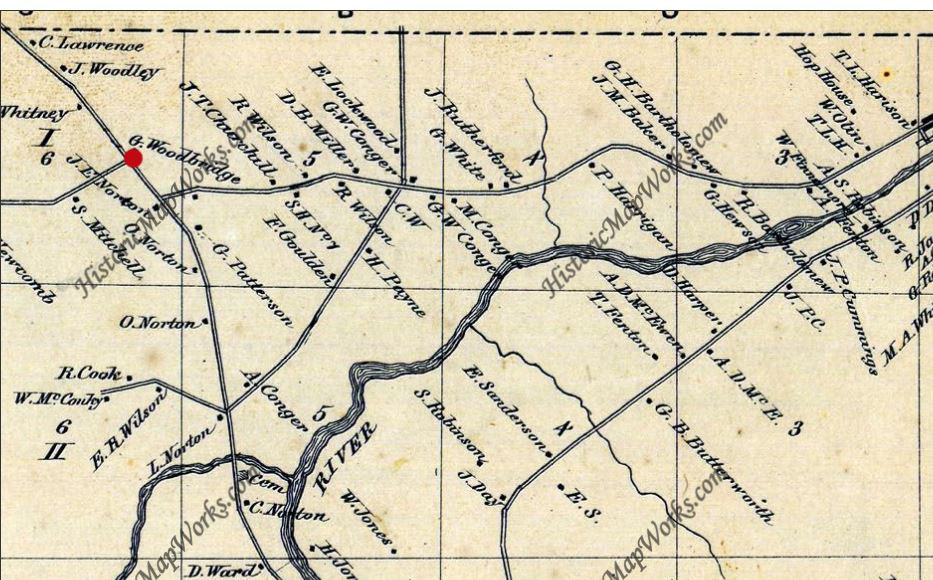
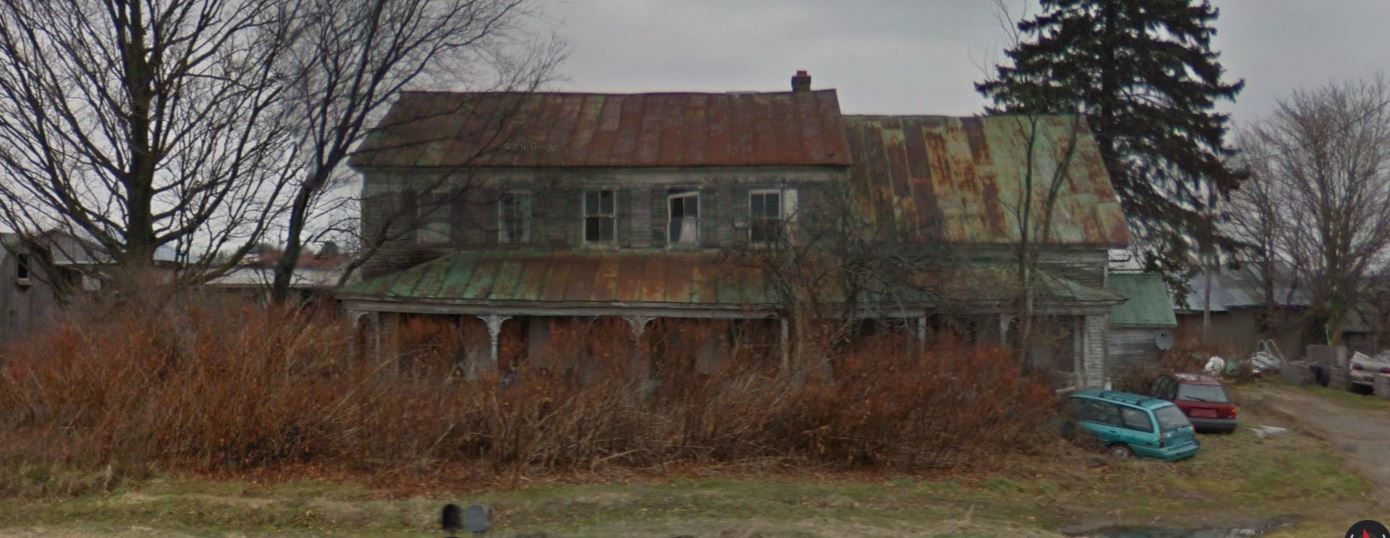
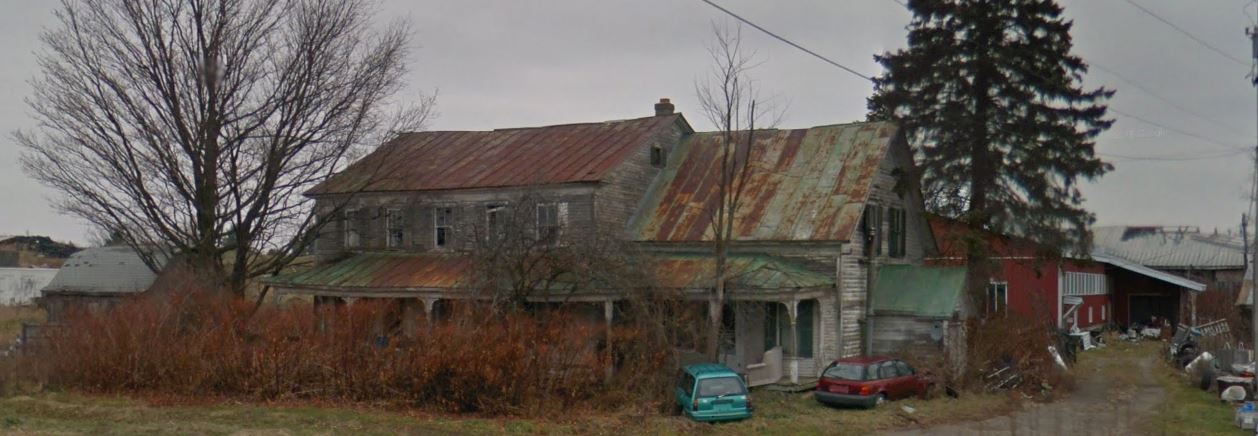
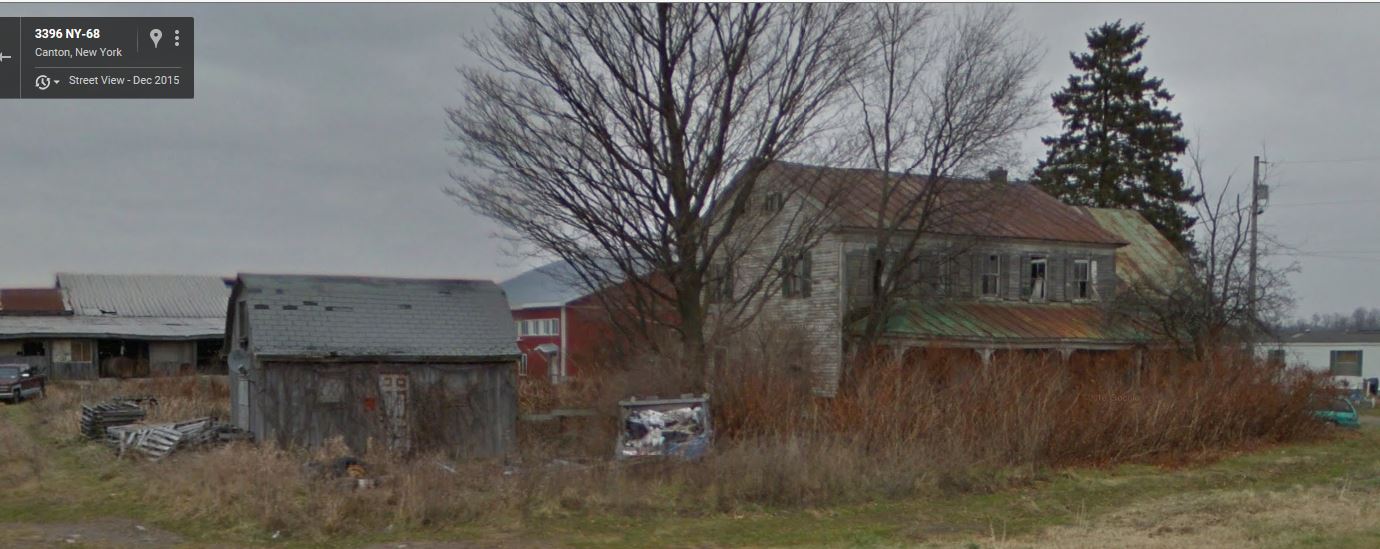
One of the interesting old North Country inns of a century ago was the Woodbridge tavern about two miles outside the western limits of the village of Canton on the road to Ogdensburg. Today it stands as a large, rambling 18-room farmhouse, owned and occupied with its 123.82 acres by Harry Coy Norton, a Canton town councilman. Whether it was built by Philip VanRensselaer, who was one of the wealthy land barons owning vast acreages in northern New York, or whether it was erected some years later by George Woodbridge does not appear from the historical record of today. That the place is over a century old there seems to be little question, and it seems to be little changed in exterior appearance from the picture of 1877 vintage published in the Durant & Peirce history of St. Lawrence county.
In its early days, unquestionably many of the Parishes, Ogdens and Harisons
halted there in the lumbering stagecoaches plying between Ogdensburg and
Canton and then moving on to Potsdam and Malone. The record shows that
on November 8 -1844 Philip Van Rensselaer conveyed the tavern property
and its 123.82 acres of land to George Woodbridge for $1,775. Its location
was designated Woodbridge's Corners, and it was the next western stop
from Stillman Foote's pioneer tavern on the edge of Canton village. George
Woodbridge died intestate November 4 1866 leaving Philena, his widow,
and Emory G Woodbridge, his son. Eventually title to the old tavern and
farm passed completely to Emory G Woodbridge, who was undoubtedly one
of the outstanding citizens of the township, for in the 1870's he was
the heaviest patron of the Fayville cheese factory. Several descendants
still reside in St. Lawrence county.
William George Woodbridge, retired farmer and son of Emory G Woodbridge, died aged 76 at his home near Morley October 20 1936 leaving four sons and a daughter, Justin, Edmeston and Ralph of Heuvelton; George of Canton, and Mrs Arthur O Northrup, Morley.
Emory G Woodbridge died December 7 1889 and on April 5 1890 his executors
sold the old tavern and farm at Woodbridge's Corners to Friend L Gill.
On April 8 1904 Mr Gill conveyed it to Mrs Minnie M Smith Norton, wife
of Frank Oliver Norton. Daughter of Sidney and Susan Doty Smith of Morley,
Mrs Norton married Frank Oliver Norton February 3,1886. She died May 26
1939 aged 74. Mr Norton died February 13 1940 aged 75 and this place went
to his son and daughter-in-law, Harry Coy Norton and Beatrice A Norton,
the present owners.
The Nortons constitute one of the oldest families in the town of Canton. Like Stillman Foote, Elihu Norton, a Revolutionary war veteran, came from Middlebury, Vermont. He and his wife, Sara Crane Norton, came in 1805 over an Indian trail to Indian creek and bought a farm at Woodbridge's Corners. There they first built a log cabin Of their seven children, Orville was born in October 1807 and was 17 years old when his father died in 1824. Orville, who bought the farm adjoining his fathers' on the west, was married to Electa, daughter of Daniel and Phoebe Whitney, who came from Vermont to Madrid at an early date. Orville, who died December 3 1874 was the father of nine children.
One of his sons, James Elihu Norton, was married to Lucy Jane Coy and died in 1871. Frank Oliver Norton was their son and besides being a farmer was for many years an auctioneer, insurance broker and for 25 years an assessor of the town of Canton. His son, Harry Coy Norton, present owner of the old tavern, operates the farm, represents the Farmer's Insurance company and since April 29 1947 has been town councilman. He is the fifth generation of Canton Nortons.
Mr Norton is of the opinion that the tavern was built by John Hopkins who came to settle on a town of Canton farm opposite the poor farm in 1803. If this assumption is correct the tavern is much older than the record would show. There are no fireplaces in the house, but the woodwork is of early craftsmanship and during tavern days there was a bar in the big house. In any event it is one of the landmarks of the town.
An attractive frame farmhouse which has all of the earmarks of a century of age and always catches the attention of the eye of the motorist traveling between Watertown and Ogdensburg is this one with the beautiful front door near South Hammond. Since December 11,1945 it, and its 185 acres of land, has been owned by Edgar P Gascon and his wife, Mrs Eleanor E Gascon.
It is on a 55.17-acre plot of land, which is part of the entire farm,
and which was sold on October 8 1855 by George Parish, noted St. Lawrence
county land promoter, who resided in Ogdensburg.
According to that deed Mr Lambie, who was one of the early settlers of
the township of Hammond, had contracted with Mr Parish to purchase this
parcel on July 1 1840 and in all probability the house was erected hortly
thereafter, making its age approximately 110 years.
The record of title shows that on December 14 1872 John L Lambie disposed
of this and other lands to James L Lambie for $7,394.50. That price is
proof positive of the then existence of this house. When James L Lambie
died is not clear, but on March 12 1900 his heirs sold this parcel and
other lands to William A Webster, who resided in the large stone mansion
next towards Ogdensburg, for $7,000.
Mr Webster died on April 8 1930 willing this property to his son,
Dr William A Webster, dentist, and it was he.who disposed of the place
to Mr and Mrs Gascon December 11 1945 they having contracted for its purchase
some years before and having resided upon and operated the farm during
that contract period. In fact it was about 24 years ago that Mr and Mrs
Gascon began occupancy of the place, and in addition to operating the
farm Mr Gascon has been a livestock dealer for several years.
While in the technical ownership of the Webster family 45 years the property was a tenant farm much of that time. The Websters constitute one of the early town of Hammond families and the Lambie heirs, who sold this farm to William A Webster on March 12 1900 were Samuel W and Addie Lambie, S Carola McLennan and Jennie F Jackson.
Samuel Webster, New Hampshire, and William Tappan from Vermont about 1819 became first settlers in the south portion of the town. William A Webster, who bought this farm from the Lambie estate in 1900 was a son of Samuel Webster and on May 12 1843 was born in the big stone house where he resided all of his life and died April 8 1930 at the age of 86. He was one of the most prominent men of the town, was a justice of the peace for many years, a highway commissioner at one time, served in the 16th New York Heavy Artillery in the Civil war, operated a large farm for many years, and then for some years engaged in the lumber business, operating a door, sash and blind factory in Clayton.
On January 5 1871 he was married to Miss Charlotte Dygert of South Hammond, who died June 13 1914. Dr William L Webster, son of William Alfred and Charlotte Dygert Webster, is also a prominent Hammond resident continuing occupancy in the homestead stone mansion, which is well over a century old.
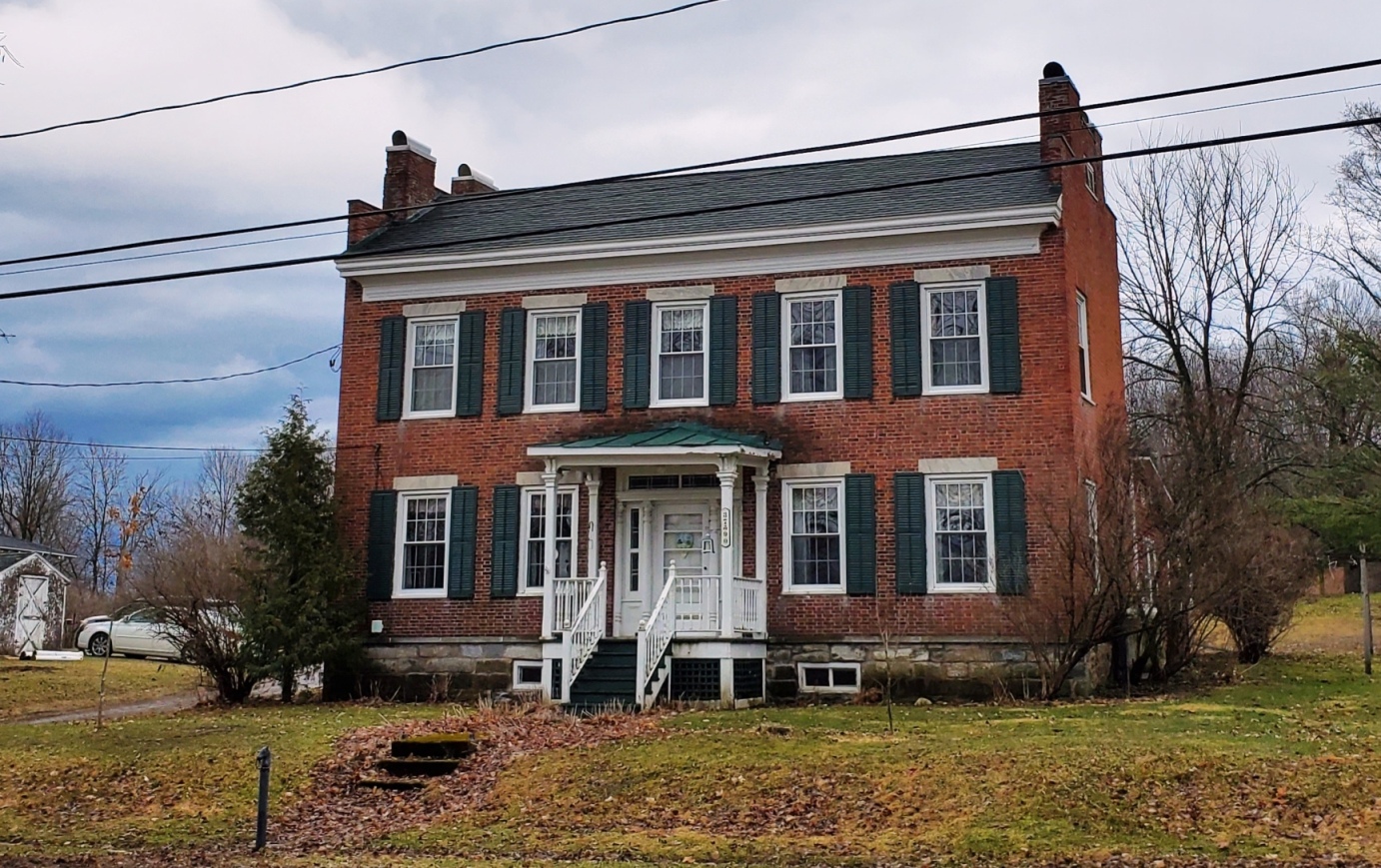
Thank you to Shelene Atkinson for the photos
Oxbow, the little hamlet in the town of Antwerp, made historic principally because there onetime resided Caroline Charlotte Bonaparte, daughter of an European king of a century and a half ago, features a number of interesting old brick houses, of which this is one.
It was built probably about 1842 of brick from the same kilns that supplied material for the Abner and Zebulon Benton and the Enos Brainard houses. It was originally owned by Robert Darling, one of the many sturdy Scots who located in that section, and from its commanding position on the east side of the mall or park, it faces across to the old cemetery where is buried Caroline Charlotte Bonaparte and her colorful husband, Colonel Zebulon Howell Benton, while at the head of the mall, and between this Darling mansion and the old cemetery, stands the old stone Presbyterian church where Robert Darling was a devout attendant and generous contributor. Nearby was his substantial farm, and he was a prosperous farmer.
Two parcels of land went into the site of this house. One of 1.33 acres Darling bought on April 16 1841 from Rufus H King and Robert Ormiston. King, who had pretty well covered the 1830s as supervisor of the town, had been Oxbow's second postmaster and, with John J Gilbert had opened Oxbow's second store in 1821. Ormiston had been supervisor in 1854. Both King and Ormiston were also Scotch. The second parcel of one acre was bought by Darling from Robert and Cornelia Lansing and George C and Mary Sherman on February 27 1844 and half of it was later conveyed to the Presbvterian church society. When Robert Darling died September 28,1877 he willed his big gilt-edged Bible to his daughter, Margaret Laidlaw and his Scott's Commentary to Robert D Laidlaw, a grandson.
Also he provided generously to the American Bible Society and the Presbyterian Foreign Missionary society. The life-use of this house and contents he willed to his daughter, Mrs Margaret Laidlaw, and there followed several years of ownership in the Laidlaw family.
Alexander T Laidlaw, Oxbow, and William G Rutherford, Gouverneur, were named executors of his will and, on June 1 1890 they transferred this house to Alexander Laidlaw for $1,100. On September 5 1893 Attorney Edward H Neary, referee in a partition action brought by Margaret B Rutherford vs. Sarah A Laidlaw et al, conveyed this porperty to Sarah A Laidlaw for $900. Attorney Edward N Smith as referee in a suit affecting title sold the property to Watson F Carpenter April 24 1900 and November 29 1902 Watson F and Laura M Carpenter disposed of it to William Hutton, prominent Oxbow farmer.
Mr Hutton kept the house until January 15 1913 when his wife, Hattie, joined him in its sale to Wilhelmina Laidlaw of Oxbow for $1,600. Under the terms of her will recorded August 21 1919 she provided a life-use of this house to Andrew Laidlaw and then gave it to her daughter, Mrs Carrie Beenfield.
Mrs Beenfield, later a resident of Syracuse, sold the property to Allen and Lillian Whittaker of Oxbow in May, 1930 and May 21 1941 the Whittakers sold it to Lyle W and Teresa M Hall. On September 24 1945 the Halls conveyed to Floyd G and Helen E Shampine, and October 4 1949 they deeded it to Fred and Myrtle Shampine of the town of Gouverneur, who sold it to Michael X and Grayce J Prescott of Oxbow March 20 1950 present owners. The house is beautifully constructed and as sturdy today as when it was erected over a century ago. The fine front entrance is somewhat obscured by a modern porch, and the attractive original, small-paned windows have been replaced by ones of modern type, but much of the handsome interior woodwork remains. The original curved stairway was one of the finest in this section, and the house continues to attract the traveler who visits this historic old hamlet.
One of the remaining souvenirs of the industrial empire that David Parish tried but failed to build at the hamlet of Rossie, St. Lawrence county, is this old brick house erected atop the lofty granite ridge on the main Street in 1812 as quarters for his land agent.
Born December 4 1778 in Hamburg, Germany, son of John Parish, wealthy Englishman who had established a powerful financial house there, David Parish himself became a millionaire before he was 26. In the early 1800's he came to the United States on a financial mission for his father and late in 1808 purchased 200,000 acres of St. Lawrence and Jefferson County lands which included Ogdensburg and large tracts in the towns of Antwerp, Rossie and Hopkinton.
In the late summer of 1810 he began building the Rossie iron works and by the summer of 1813 he began the furnace which, in 1815 got into operation as the first blast furnace in northern New York. Deposits of iron and lead were near at hand in substantial amounts. Some of the first steelmaking processes in the country originated here, and in 1840 the Russian government sent a commission to Rossie to study them.
On April 7 1813 David Parish, Stephen Girard and John Jacob Astor loaned the United States government $16,000,000. This loan kept the nation solvent and was the largest financial transaction of the War of 1812. The same year this loan was made, Parish contracted to make cannon balls for the army, but because of the plant's proximity to the Canadian border, the contract was later cancelled.
About 1816 David Parish returned to Hamburg, and his younger brother, George, came to carry on his land, industrial and mining operations, moving into the Ogdensburg mansion. Later David became involved financially to the ruin of himself and father in Europe, and drowned himself in the Danube. George returned to Europe about 1839 and died suddenly in Paris.
George Parish, 2nd, bachelor nephew of David and George, had already assumed control and management of the vast Parish properties. Romantically he lived at Ogdensburg with Mile. Helena Ameriga Vespucci, descendand of the great Italian navigator for whom America was named, and in 1859 left her to return to Europe.
For many years this brick house, in Rossie, a hamlet named for a sister of David Parish, was occupied by Charles L Lum, one of the Parish agents, and in this house the Parishes frequently stayed when visiting Rossie to survey their iron operatipns. Incidentally, it is said that they often found relaxation at their own race track in the meadow back of the barn which, for many years after its completion in 1815 housed some of the speediest horseflesh in the north.
This house contains five large rooms downstairs, four bedrooms on the second floor with a fine hall and stairway leading between the two floors.
On February 23 1874 George Parish, 2nd, sold this house and the 282.39-acre farm to William and Nancy McMullin Turnbull for $7,059.75. Financial reverses in later years caused the place to be bought by Wallace McKean, James C and Betsey Turnbull December 12 1892. However, on March 2 1893 they disposed of the property to John William O'Brien, born January 6 1842 in county Wexford, Ireland. After many years his son, Jerome J, acquired ownership and died February 14 1931 leaving Blanche, John C, Morgan and Smith O'Brien and Helen Redmond, who sold this property to John C O'Brien nine days later. It fell into the hands of the trustees of the First National Bank of Gouverneur May 10 1935 for $1,860 and on September 1 1944 the bank sold it to Ai B Hutton, the present owner and occupant. Occupants of the farm during the O'Brien ownership have been Charles Lampe, Roy Bacon, Daniel Phalen, Charles O'Hara, Francis LaFountain, William Stevenson and Max Lancto
In spite of the fact that there were unlimited quantities of native building stone available in St. Lawrence county David Parish elected to employ brick for his residence in Ogdensburg and for his farmhouse and land office in Rossie. And it was after his brother, George, had succeeded him in residency and control of his lands and northern New York business affairs that President Monroe was entertained at the Parish Ogdensburg mansion August 1 1817. At Rossie, where David, the Hamburg millionaire-banker, his brother, George, and their nephew, George Parish, 2nd, vainly endeavored to establish a great iron and lead industry, this brick land office was erected in 1815 upon a knoll near the Indian river and Parish's Rossie iron works.
Not only was this brick land-office the nerve-center of the extensive Parish land transactions in the Black lake district, but it served in the capacity of bank and paymaster's office. In the basement was a stout brick vault where the money reserve was kept. On the ground floor was a cashier's desk and window through which money was received and paid out. Not a little of the money paid out was in the form of wages to workers from the Parish iron mines a mile and a half from Somerville, the iron furnace, foundry, and, beginning in 1835 the workers in the Parish lead mines of Rossie, numbering 300 at times.
Across from the land office was the iron furnace, to which the ore was hauled by teams from the Spragueville mines and at the top of the hill dumped into the top of the furnace.
By 1865 the Parish iron, lead and land operations had become stagnant at Rossie, and on December 15 1875 George Parish, 2nd, the rakish bachelor credited with having won the "Beautiful Florentine" Ameriga Vespucci from "Prince John" VanBuren, a president's son, in a grim poker game at John Hoover's tavern in Evans Mills, disposed of the property to Ario Pardee for $60,000. The transaction included the land office and iron works.
Less than three years after that Pardee sold the land office and grist mill to Robert Melrose on March 3 1878 for $7,500. Melrose died September 8 1887 leaving Betsey Tait, Robert Melrose, 2nd, Elsie Jeffers, Mary Comstock, Margaret Peacock, Nellie Melrose, Idella Melrose and Sarah Melrose. Both Robert Melrose Sr, and Robert Melrose Jr, operated the grist mill, the latter having acquired title by purchase December 4 1891 for $2,774.74. This transaction included the land office. On October 1 1908 Robert and Esther Melrose sold the land office to Catherine Deughan for $800 and on December 5 1912 she disposed of it to Matilda Rexford for a similar amount. The latter died leaving it to Clarca Dority, who conveyed it to Charles A Wright on April 9 1935 for the nominal sum of $1. Next, on April 10 1945 Wright sold to Albert Peck, and on April 9 1946 Peck conveyed it to Emory M and Florence Lillian Tvler and on October 13 1949 the Tylers sold out to Arthur W and Rose Martin, the present owners.
Mr and Mrs Martin operate a tourist home, rent boats, fishing tackle and sell bait to recreationists who go to that historic area. But the glamorous days when the Parishes, the Ogdens, the Fords and the LeRays lived almost royal and pompous lives in northern New York, entertaining the great and the near-great, have long since been nothing but a memory. Today Rossie is a drowsy hamlet, still very much history-conscious, but tarnished is the glory of 135 years ago.
Scotch Settlement Road, off Rt 3 (Rossie-Oxford Rd) in town of Hammond NY
Between the Indian and the Oswegatchie rivers in the town of Rossie there is a district known as the Scotch Settlement. It was begun in 1818 when ten native Scotch families headed by Robert Ormiston, James Dickson, William Faichney, James Fairbairn, Corlan McLaren, Donald McCarrie, Thomas Elliott, James Henderson, James Douglass and Andrew Dodds established themselves there. The next year arrived another group including William Laidlaw, and in 1820 came still others and so they continued to drift into the area from their native Scotland until about 1832.
Clannish in the extreme these residents of the Scotch Settlement brought with them many of the traditions of their homeland incorporating them into their lives here in America.
One of those traditions was the celebration of the birthday anniversary of their great Scotch poet, Robert Burns, as regularly as it came on January 25 for on that date in 1759 he had been born, son of an Ayrshire peasant. Out of these annual observances in Rossie's Scotch Settlement came the establishment of "The Burns Festivals" which, for many years until his death in 1900 were held at this "Jack" Laidlaw hotel on the hill just to the north of the hamlet of Rossie. Always they were on January 25.
Under probable expansion and modernization the appearance of the tavern has been changed greatly from the original. According to tradition the tavern was built in the early 1870's by Robert and John Tait for Jack Laidlaw, who was a son of that William Laidlaw who came from Scotland in 1819 to locate in Rossie. There are things about the property, however, which lead to the belief that the present squarish building represents a complete doing over and enlargement of the original structure.
According to the record from the county clerk's office George and Richard
Parish sold 49.83 acres to Africa and Zacheus Gates for $3,219.86 on April
1 1841. The price indicates a building on the property and the Gateses
were early tavern proprietors. They had contracted to buy this tract January
1 1838.
Zacheus died April 22 1852 and on July 3 1854 his estate sold his half of the property to John Laidlaw and Daniel Collins for $2,250. The half interest of Africa Gates had been acquired by Laidlaw and Collins for the same price on April 1 1854 and on April 24 1860 Collins transferred his half interest to Jack Laidlaw for $2,200.
Laidlaw retained title to the property until December 11 1889 when, for the nominal sum of 100 he deeded it to his wife, Julia A Dillenback Laidlaw, who died May 27 1890 leaving it to her daughters, Adelia E, Lottie H, and Maggie L Laidlaw. Adelia died October 29 1922 and Lottie on April 3 1923. On December 31 1925 Maggie married Benjamin V Wiggins, an interior decorator. On August 28 1933 Mrs Wiggins conveyed the property to her husband.
She died February 6 1942 and on January 26 1946 Wiggins deeded the property to his daughter, Mrs Dorothy Mathusz, who the following May 31 transferred it jointly to herself and father. He died April 5 1948 and on May. 25 1949 Mrs Mathusz sold the place to Ai B Hutton, the present owner, but it is no longer used as a tavern.
There are still many living In the town of Rossie who recall "The Burns Festivals," which were elaborate 24-hour affairs and made this house famous, for there they staged an elaborate celebration of the ploughman poet's birthday with limitless amounts of Scotch food featuring the much-prized haggis. There were printed programs of those celebrations with their Scotch music, dancing and general get-together, and there are seven now living in the area who were present at the last of the Burns Festivals approximately a half century ago. They are: Mrs Lillian Gibson, Mrs Stella Turnbull, Mrs Jennie O'Hara and Garrett Burns of Rossie; Mrs Margaret Webster Backus, Gouverneur; Clark La Freney, Ogdensburg, and Albert Simons, Hammond. Some of the old festival programs are now owned by Mrs Virgie B Simons, Rossie town clerk and authority on the history of that section.
where the Red pin is located is "Pike Rd" - house could be on this road
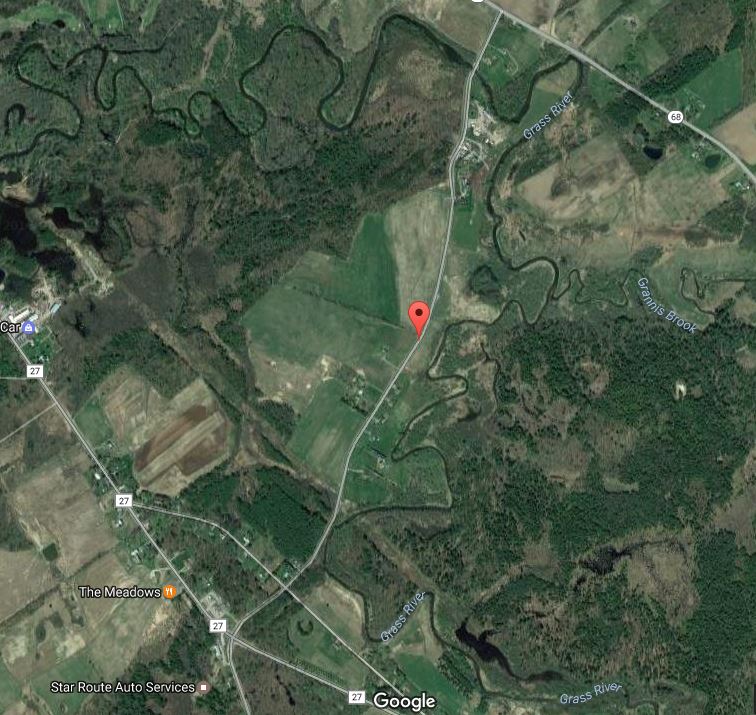
In excellent state of preservation is the white Cape Cod type house of Theodore P and Doris Pike Gibson on the old Pike road which stretches from the Canton-North Russell road on the west to the Canton-Pierrepont road on the east. With this house are about 112 acres of land and Mr and Mrs Gibson are prominent 4-H club leaders in the Canton area.
The land of this farm is a part of the 296.56 acres which John Farwell purchased from Landowner Richard Harison on March 19 1811. John Farwell it will be recalled was one of the pioneer settlers of the town of Canton, and at the first town meeting on March 4 1806 he was chosen one of the town overseers of the poor.
On October 28 1814 John Farwell sold 100 acres off the western end of the 296.56 acres to Calvin Nash and shortly thereafter was built thereon the quaint, rambling sandstone house now owned by James and Ellen Dromey Farrell. Off the east end of the 296.56 acres was sold by the heirs of Madama Hale, who was the daughter of John Farwell, a 50-acre plot to Adolphus Hosley March 15 1843 and that 50-acre plot was one of three sold by Hosley to Harvey Knox November 14 1844. Upon that 50-acre plot stands the Harvey Knox house, which was built the following year.
Thus it is that this Gibson farmhouse, on its sequestered Pike road, stands between the Calvin Nash stone house and the Harvey Knox pillared house, but much nearer the latter than the former. And, Mr and Mrs Gibson declare that John Farwell lived in their house, from which they argue that it must have been built shortly after March 19 1811.
Calvin Nash died March 19 1843 and his estate sold 50 acres on the east side of his 100 acres to Lunman Moody. This 50 acres with other lands eventually came to Richard D Nash. On April 24 1823 John Farwell sold another 50 acres east of this 50-acre Richard D Nash plot to Clarissa Richardson, who was the wife of Seth Richardson. On June 13 1859 she sold her interest in her 50-acre lot to Harvey Knox, who conveyed it to Leonard Farmer May 18 1878.
Farmer, who had previously acquired adjoining acreage, died November 18 1908. He left no will and his property went to his daughter, Leila Merrill who, on October 18 1912 sold the Clarissa Richardson 50-acre plot, the Calvin Nash 100-acre plot and other lands to Albert M Pike. Mr Pike, father of Mrs Gibson, conveyed the 50-acre Clarissa Richardson plot plus 2.49 acres and about 52 other acres that constitute the farm where this handsome Cape Cod house is, to Mr and Mrs Gibson August 1 1947. Mrs Gibson is the great grand-daughter of Harvey Knox, who built the Knox house on the Pierrepont road and who acquired the 50-acre Clarissa Richardson lot on June 13 1859. Mrs Gibson's mother, the former Miss Alice Grace Knox, was the daughter of Harvey W S Knox who was the son of Harvey Knox.
On October 5 1892 Alice Grace Knox was married to Albert M Pike, who was collector of the town of Canton in 1907-8 assessor of the village of Canton for 30 years, and elected president of the St. Lawrence County Assessors' association May 17 1945. A brother of Mrs Gibson is Harvey Knox Pike, who now owns and occupies the historic Harvey Knox house and farm on the Pierrepont road and is a neighbor to Mr and Mrs Gibson. Mrs Gibson, the former Doris Evelyn Pike, graduate of the Canton High school, of St. Lawrence university '25 member of Kgjppa Kappa Gamma sorority was married to Theodore P Gibson, Canton news dealer on September 5 1925. They have a son, David, and daughter, Alice, seniors in the Canton High school. And in this fine old house with its 36 by 24-foot upright and 15 by 18-foot wing are many fine antiques.
Gone...replaced by parking lot...
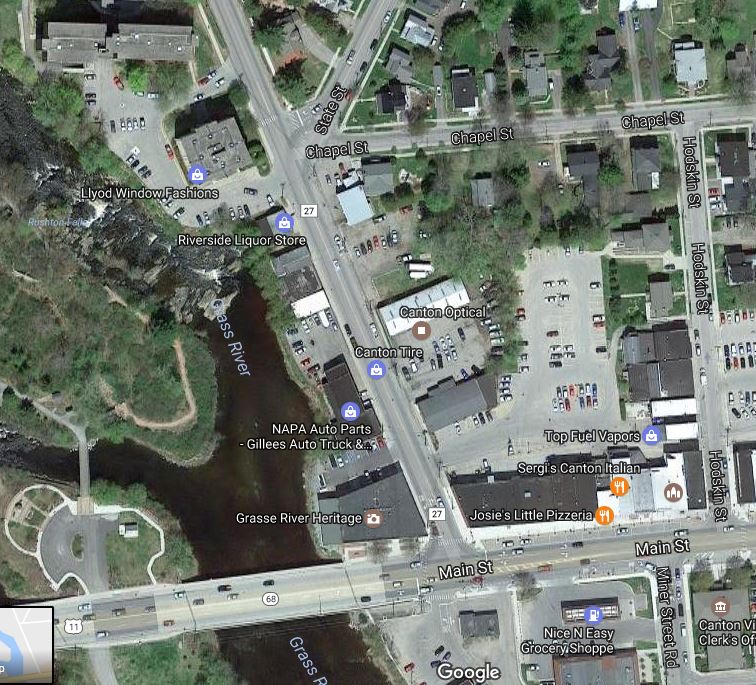
Down near the Grasse river's east bank in the heart of Canton's earliest
industrial district is this quaint old native stone house said to have
been built by Stillman Foote, Canton's first permanent settler. It is
of simple cottage type and evidences having been one of the earliest structures
erected in Canton. There is nothing in the record to fix the year of its
construction and originally there were no verandahs on it. It stands on
the west side of Riverside drive within a few hundred yards from Main
Street and the Hotel Harrington. In easy view of it also are the big tavern
erected by Stillman Foote in 1802 and the ruins of the beautiful four-story,
red sandstone grist mill constructed by Henry VanRensselaer in 1842. This
was known as the "Eagle Mill," and upon its site Stillman Foote
built his first mill more than a century and a half ago.
Before the War of 1812 Foote built a bloom forge near this house, which undoubtedly had some relationship to that forge and near there in 1815 Foote built a distillery. He was an active industrialist in every sense of the word and by 1827 he had a marble factory in the same area. Also in those early Canton years there was a tannery at the rear of this house. The site of this old house was part of the original mile square bought by Stillman Foote in 1800 snd upon which the village of Canton now stands. Just when the site of the house was acquired by the VanRensselaers as a part of the "Eagle Mill" lot does not appear from the record at hand.
However, on August 1,1836 Stephen VanRensselaer sold the "Reserve Mill lot" containing this property to Simeon D Moody, Silas Wright Jr, Joseph Ames, 2nd and Thomas H Conkey for $2,600. On November 2 1838 Ames and Conkey sold their interests to Wright and Moody, and July 1 1843 Wright became the sole owner, selling the property September 7 1844 to Hiram S Chapman for $5,000. Then on August 13 1846 Chapman sold part of the property to Henry VanRensselaer for $4,500 and on December 20 1860 VanRensselaer disposed of part of the "Reserve Mill lot" with other lands to Friend P Fletcher for $25,000. This included the .98 of an acre "old stone mill lot" of concern here.
On June 12 1862 Fletcher disposed of the .98 of an acre to Jeremiah and Daniel Traver for $500 and April 10 1863 Daniel sold his interest in this and other lands to Jeremiah for $2,000. Jeremiah was engaged in the tannery business and went bankrupt, his assets being assigned to William H Kimball May 21 1873. As trustee Kimball sold this .98 of an acre and other lands to Barzillai Hodskin and Solon D Hungerford April 21 1875 for $9,500.
On January 6 1880 they conveyed to Frank C and Edward H Gilbert for $4,800 and March 25 1890 they deeded this and other lands to Carrie H Gilbert for $10,000. She conveyed back to them December 8 1896 and November 11 1905 Frank sold his interest to Edward who sold to St. Lawrence university September 25 1923. The university sold to the town of Canton October 19 1925 and_it transferred to Leland H Young January 18 1926. His assets were acquired by Bertha M Young February 11 1930 and on April 17 1930 she sold to Roy H Bassett and G William Lewis. They sold to Amos and May Hennigan May 1 1930 and on April 1 1932 they disposed of this old house and lot to Omar and Pearl Liscum. Omar transferred his interest to Pearl on December 26 1938 and July 2 1946 she deeded it to Lloyd and Violet Liscum, the present owners.
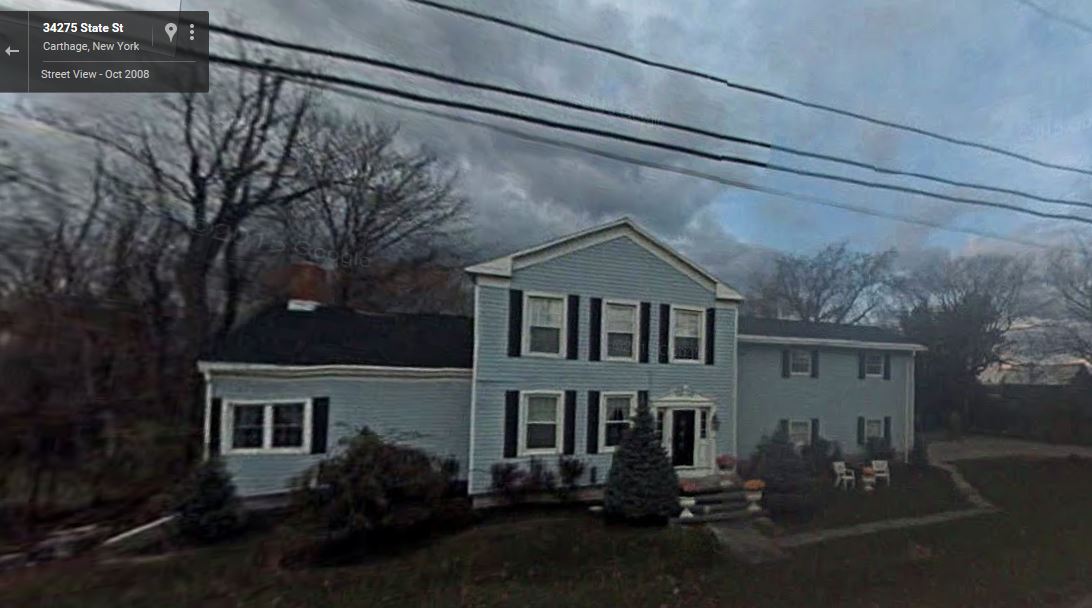
Snug among beautiful old sugar maples next easterly to the old Hiram Hubbard stone house on the north side of the road in the hamlet of Champion is a frame house with a beautiful doorway and some of the original 24-pane windows still remaining. A century and a quarter ago it became the homestead property of Dr John Prentice Johnson, one of Jefferson County's leading early physicians, as his father, Dr Converse Johnson in South Champion had been before him.
It is possible that Dr John P Johnson built the twelve-room house with its two fireplaces after he bought the .88-acre site from Joseph Marvin of Watertown August 6 1827 for $400 although it is also quite possible that the dwelling was previously erected by Marvin. That deed designated the property as. across the road from the premises owned by the Stephen, Hubbard estate and then in possession of Alfred Lathrop. In the wing with the little alcove entrance Dr Johnson had his small office with fireplace. In the dining room was the other fireplace with bake-oven.
There Dr Johnson resided until his death April 14 1852 leaving a widow, Jerusha Hills Johnson and six children, one of whom, Miss Cornelia M Johnson, became a prominent educator and died in the house November 13 1906 at the age of 82. Her mother, Mrs Jerusha Johnson, died in 1874.
Miss Cornelia M Johnson attended Champion district school and before she was 16 was teaching in the township. When the Albany Normal school opened she became one of its first students, graduating in its first class in 1845. Then for some years she taught in a Rutland district school before going to teach in Augusta, GA
There she was when the Civil war broke out and there she was when Sherman came marching through to the sea and sent a special guard to protect her. When all was over she returned north and toured Europe with Mrs George C Sherman. Then in 1869 she became preceptress of the Watertown High school when this community was born as a city.
For 28 years until her retirement in 1897 she was preceptress of the high school. As the result of .a judgment in favor of the Jefferson County bank vs. her father and Lyman Holcomb she had acquired this house at sheriff's sale June 5 1855 and willed it to her sisters when she died. One sister, Frances A Johnson, died November 24 1908. Another, Mary J Johnson, died August 27 1920 and willed this house to her niece, Marie Elizabeth Virginia Raplee, who, while a resident of New York City, sold the place to Arthur L Parks, a Champion cattle dealer, on November 24 1922.
Mr Parks was a native of the town of Champion, having been born there January 5 1864 son of the late Sylvester and Ann Howarth Parks. On December 14 1892 he was married to Miss Julia Holcomb. He became a master of the Champion grange of which he was a member 43 years, was president of the Champion Cemetery association, and for several years was a trustee of the Champion school district. Mrs Parks died on June 3 1934 and on June 28 1939 Mr Parks conveyed this house and lot to one of his sons, Sylvester J Parks, the present owner, who came there to reside after the death of Mrs Julia Holcomb Parks, and still lives there with his wife and children. His father, Arthur L Parks, died September 1 1950.
The house with its beautiful front entrance involving side lights and slender pilasters, fine old windows and a graceful semi-circular fan-louver in the front gable, is maintained in excellent condition and is one of the attractive old ones in the county. And likely Dr Johnson purchased the place on contract before he got his deed, the obituary of Miss Cornelia Johnson indicating that the house was there when she was born in 1824 for it states that she was 82 when she died in 1906 and that she was born in the house where she died.
House gone
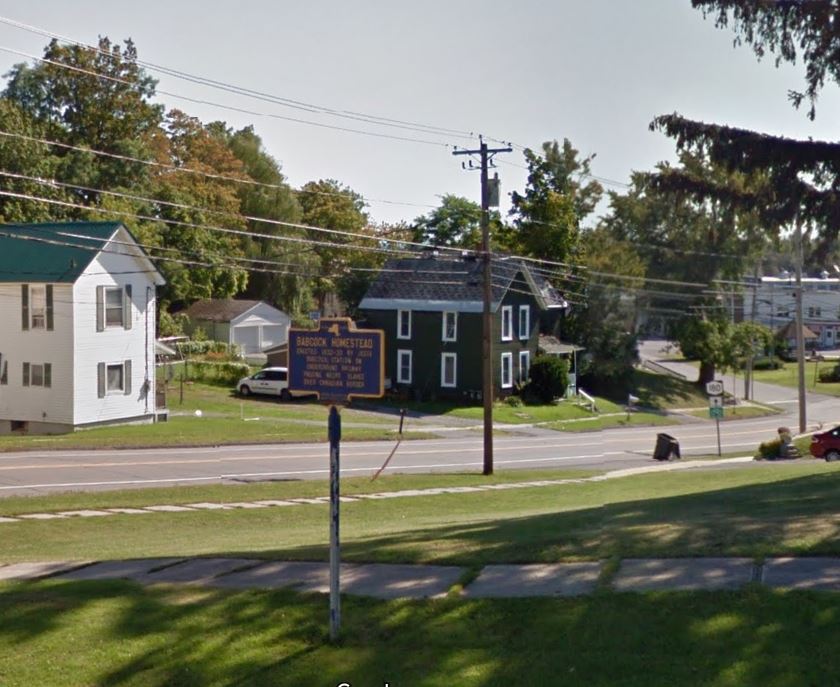
At the corner of Kirby and Brown Streets in the village of Dexter an historic marker announces that the low, white clapboard house with the long wing at 107 Kirby Street was built in 1832-3 by Jesse Babcock, one of the prominent early industrialists of Brownville and Dexter and that during the Civil war it was a station of "the Underground Railway" in the clandestine transportation of escaped negro slaves across the international border to a safe haven in Canada.
According to family tradition Dyer Washburn, who resided ten miles south of, Dexter between Camps Mills and Rices, brought the fugitive negroes under cover of darkness at night, hid them overnight in the barn of Jesse Babcock who had been a rabid abolitionist and temperance advocate for 50 years, then took them the next night to, Levi Smith's at Limerick. Following a night at Smith's they were guided the next night to Smith's brother's at Perch River.
Besides assisting in the escape of the fleeing southern negro slaves, Jesse Babcock had a contract to furnish the Union troops with rations at Sackets Harbor in 1862.
Built in the sturdy old-fashioned manner, the stout framework of the
house was put together with wooden pins and old-fashioned square cut-nails
were used to fasten on the sheathing and clapboards. The two fireplaces
were removed 75 years ago. Also taken off was the summer kitchen. The
original front door was solid with brass knocker. The original window
sash had 24 panes.
Like Henry Holmes Babcock, founder of the onetime flourishing H H Babcock Buggy company of this city, Jesse Babcock was descended directly from James Babcock who was born in England in 1612 located at Portsmouth, RI, in 1642 and removed to Westerly, RI, where he died in 1679. Where Jesse Babcock was descended from George, a grandson of James Babcock, Henry Holmes Babcock was descended from Captain John, brother of George and also grandson of James.
Jesse Babcock was born October 16 1805 at Marcy, NY, son of David and
Sarah Beardsley Babcock. Jesse's grandmother, Sarah Perry Babcock, was
a sister of Commodore Oliver Hazard Perry. Jesse's father was a Revolutionary
soldier. Jesse first married Maria Morgan at New Hartford, NY, September
26 1831 and settled in Brownville where he had charge of the cotton
mills. In 1835 he moved to Dexter with Davis and Poole and built and operated
a linseed oil mill, which the 1837 depression forced them to abandon and
covert the plant and power to a planing and plaster mill, which he operated
until 1883 when a falling bridge disabled him and he died December 8 1885.
His first wife, Maria Morgan Babcock, mother of his five children, had
died June 14 1854 and later he married Sarah A Baker, native of Dexter,
woman of superior education, who survived him.
Of the five children of Jesse and Maria Morgan Babcock, their son George, born January 3,1844 was the only one to remain in Dexter. He was associated with his father in the operation of a flour mill, served in the 10th New York Heavy Artillery during the Civil war, later became a custom-house officer and village trustee for several years and died in October 1879 but on February 21 1878 his father had deeded to him this and other property including the lot across Kirby Street where the grange hall is. George Babcock also successfully operated farms and bred fine horses.
As a young man George Babcock was married to Miss Leonora Fluno, daughter of David Fluno, and she became the mother of his three children, Frederick J Babcock, Charles D Babcock and Mrs Mary Babcock Hicks, widow of William E Hicks. Mrs Hicks has been the sole owner of this historic old house since the death of her mother, Mrs Leonora Babcock James, who had become the wife of Varnum A James of Dexter, some time after the death of Mr Babcock. Mrs James died December 30 1928.
Frederick J Babcock, a brother of Mrs Hicks, was for several years superintendent of the Dexter Sulphite Pulp & Paper company. Charles D Babcock, the other brother, was foreman of the old Hopper-Morgan company which manufactured notebooks and writing tablets at Glen Park. Mrs Marjorie L King, daughter of Mrs Hicks is secretary to the United States Treasury attache at Montreal, PQ
While this house was claimed to have been built in 1832-3 by Jesse Babcock and has never since been out of the Babcock family, title to the site was not actually taken by Babcock until October 7 1840 when it was deeded to him by S Newton Dexter and the other members of the Dexter village company.
Likely on Sand Street...house gone
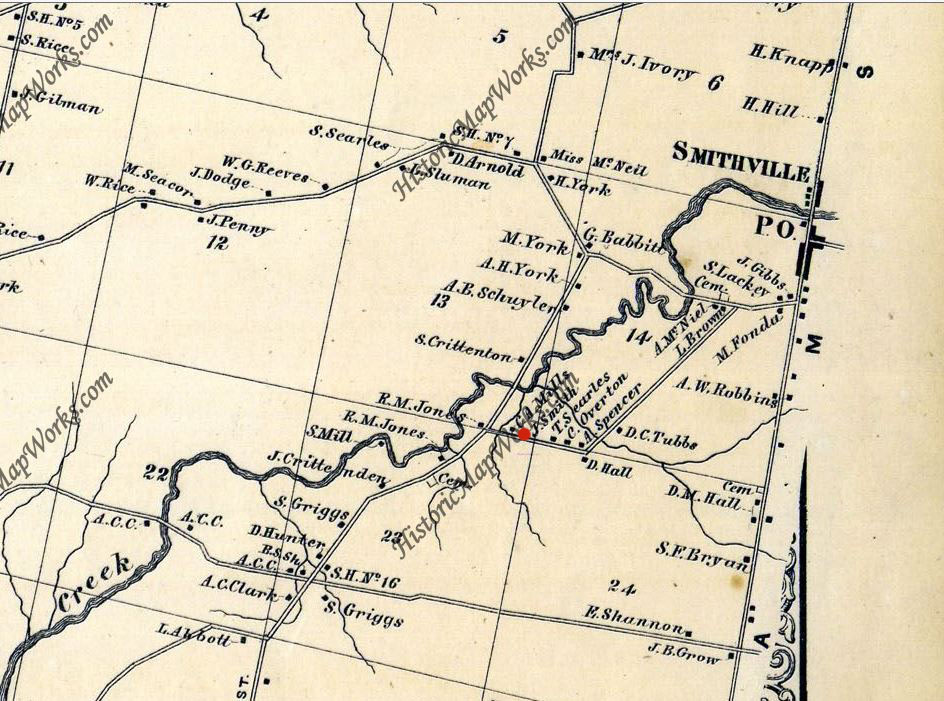
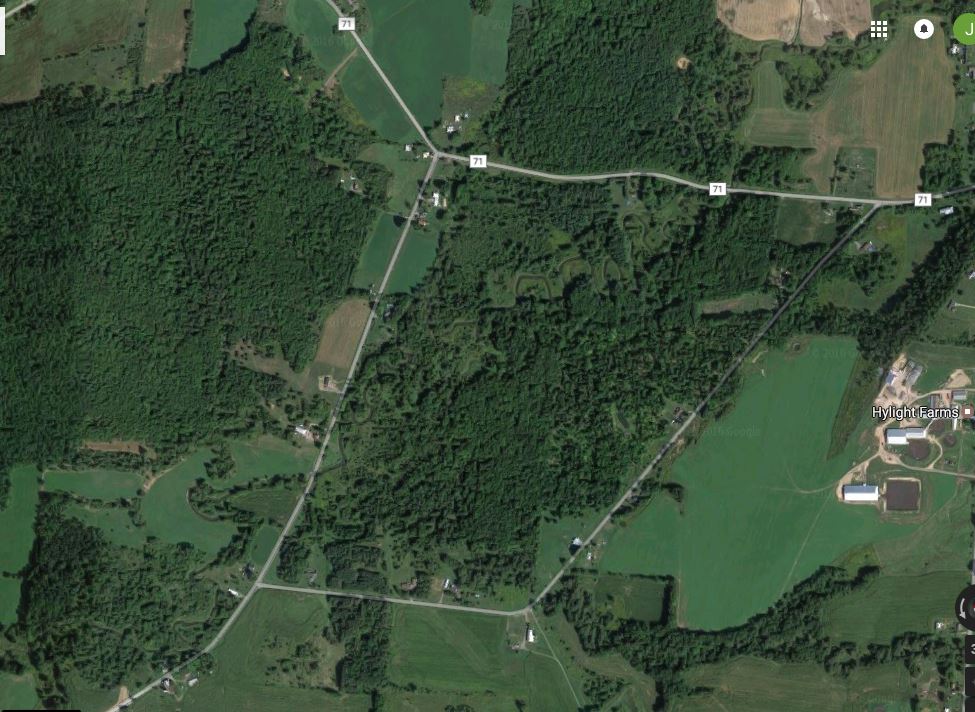
In spite of the fact that it seems impossible to trace the title of this house and farm back of March 30 1867 when Daniel M and Elizabeth J Hall sold it to Clark Searles for $10,987.50 it is probable that the name "R Smith" carved into the lintel over the door means that its first owner was Ranslow Smith.
The reason for this deduction is that the house of native limestone,
is claimed to have been built in 1839 upon a tract of 177.18 acres and
there is a deed of 126.56 acres in the same area running from Isaac and
Anne Bronson of New York City to Ranslow Smith under date of April 19
1837 two years prior to the construction.
The house is located on the road in the town of Henderson which runs from Bishop Street to the hamlet of Smithville which, like the original name for the village of Adams, was designated for Pioneer Settler Jesse Smith. But there were many Smiths in that area. In fact the deed to this farm recites that this parcel starts in the center of the road running past the dwelling of Johnson Smith.
Harvey Smith was one of the early settlers on Bishop Street, and David Smith and Reuben Smith were other early settlers of that section of the county.
The house consists of five large rooms on the main floor and three bedrooms upstairs. In the basement there used to be a kitchen fireplace and Dutch oven for baking. The farm is now owned by Judson C DeGraff, Mrs Cora DeGraff Heinman, Miss Lucy DeGraff and Albert H DeGraff, children of the late Mrs Ellen Eames DeGraff who possessed the property from May 17 1910 when she bought it from John Thomas Warren and May C Warren, until her death November 8 1933 after which her ashes were strewn about the flower beds of the farm of her maternal grandfather, Reverend Elisha Morgan.
Possessed of a distinct literary ability Mrs DeGraff was a member of Jefferson County's historic Eames family. She was a sister of the late Frederick W Eames of this city, inventor of the Eames vacuum brake and head of the Eames Vacuum Brake company, predecessor of the New York Air Brake company. She was a niece of Moses Eames, the distinguished mechanic and inventor who brought the first mowing machine into Jefferson County in 1852.
Mrs DeGraff was born in Kalamazoo, Michigan, September 21 1854 daughter of Lavett and Lucy C Morgan Eames. Her paternal grandfather was "Squire" Daniel Eames of the town of Rutland and his wife was the former Molly K Wright. Daniel Eames was one of the pioneer settlers of Rutland. He was the son of another Daniel, who in turn was a son of still another Daniel, who was the son of Nathaniel. Nathaniel Eames was a son of Thomas Eames the emigrant ancestor from England, who came to Massachusetts in 1630 was married to a girl named Margaret in 1640 and settled in Dedham, Massachusetts, where he had three children. His second wife was Mary Paddleford by whom he had six children. On January 25 1680 he died. In 1873 at Holland, Michigan, Ellen Eames was married to Christian DeGraff, who was engaged in the linseed oil business and who died in 1904. Three years later she returned to this county to the old Morgan homestead four miles west of Adams Center, where she resided until her death. Three years after that she purchased this old Smith farm which is now and has been for some time managed by her son, Albert H DeGraff, an agricultural expert, Cornell graduate and placement officer for the New York State Employment service. One of her other children was the late Edgar E DeGraff, commercial artist and onetime head of the art department of the noted Chicago Inter-Ocean newspaper, who died August 12 1947.
The Warrens, from whom Mrs DeGraff acquired this farm, bought it April 10 1907 from Everett C Wheeler, executor of the Edwin W Wheeler estate. By the will of Leonard Wheeler recorded March 1,1882 it went to Edwin W Wheeler. Leonard Wheeler bought it April 21 1873 from Julietta Searles, John A, George C, and Emily E Searles. On January 26 1869 Clark Searles deeded it to John A and George C Searles. Clark purchased it May 30 1867 from Daniel M and Elizabeth J Hall, but back of that to Ranslow Smith the record is not clear.

The present graceful edifice of the Rodman Congregational church on the south side of the main street of that hamlet was erected in 1850 and it was dedicated February 26 1851. Probably about 1849-1850 Norman Lyon, prominent Rodman cabinetmaker, built his residence two doors away on the same side of the street. Seventeen years later that was to become the parsonage of the church. For many years it was used as such until the church society found it inadvisable to maintain a resident pastor and so for the past few years the parsonage has been leased as a private residence. With the smooth exterior finish in matched lumber instead of clapboards, its symmetrical battery of eight twelve-paned windows equipped with excellently conditioned slat-blinds, the fine old house never ceases to captivate the tourist.
Primitive Congregational meetings held in that community as early as 1802 when Reverend Mr Woodward, a traveling missionary came through from the east, made it one of the oldest church organizations in the county. On September 22 1805 Reverend Ebenezer Lazelle of Watertown who had organized the Congregational church at Burrville June 8 1803 brought the Rodman society into formation and Reverend Mr Vale and Reverend Mr Priddle served as ministers. Then in August, 1808 Reverend David Spear came to preach his first sermon, was installed September 13 1809 at a salary of $220 per vear and preached there 57 years before retiring in 1865. He died November 13 1868 at the age of 88 and it is doubtful if he ever resided in this house.
The first church edifice of the society was erected in 1815 and July
9 1816 the first meeting was held in it. That building was repaired in
1830 and 1843 and abandoned in 1849. Two years after that the present
edifice was constructed. It was repaired in 1877 and again in 1950 being
rededicated the latter part of May in that year.
On May 17 1849 Norman Lyon paid Leander and Pamelia Lyon of the town of Wilna $250 for the five-eighths acre lot, upon which this house stands and probably built the house shortly afterward. Later it was purchased and occupied as a residence by Charles D Gilbert, who operated a general store in Rodman. There is no record in the county clerk's office of when Norman Lyon sold the property, of Charles D Gilbert having purchased this or any other real estate in the county, nor is it known if any other persons owned the property between Lyon and Gilbert. There is a definite record, however of Charles D and Mary A Gilbert having sold the property March 29 1866 to W R Hanford, William Christie, John S Sill, S H Gates, O C Wyman and G V Parmenter, trustees of the Congregational society. The Jefferson County atlas of 1864 shows that Mr Gilbert and his family then resided there and that the property then belonged to him.
At the time Norman Lyon bought the lot in 1849 Dr Isaac Jenks, who had been prominent in the Rodman Methodist church, resided next to the west of this house, and David Heustis was on the east side of it. In 1857 one, Merwin, was residing where Heustis later did and in 1864 G Bibbins lived where Heustis and Merwin had and Norman Lyon resided where Dr Jenks had. The county atlas of 1888 shows a Gordinier where Heustis lied been and an Austin where Jenks and Lyon had been. Today the hamlet of Rodman has lost its tannery, saw and grist mills, its blacksmith and custom carriage shops, its hotel and some of its stores, but it retains the atmosphere of peace and contentment at the beauty which make it one of the most attractive of the smaller communities in northern New York.
The Congregational church which once had 115 adult members, a firm Sunday school attendance of 85 a corps of eleven teachers and 15 officers, no longer is in such strength as to support a resident pastor, but it valiantly carries on its work and ministers to the needs of its members through the beautiful countryside.
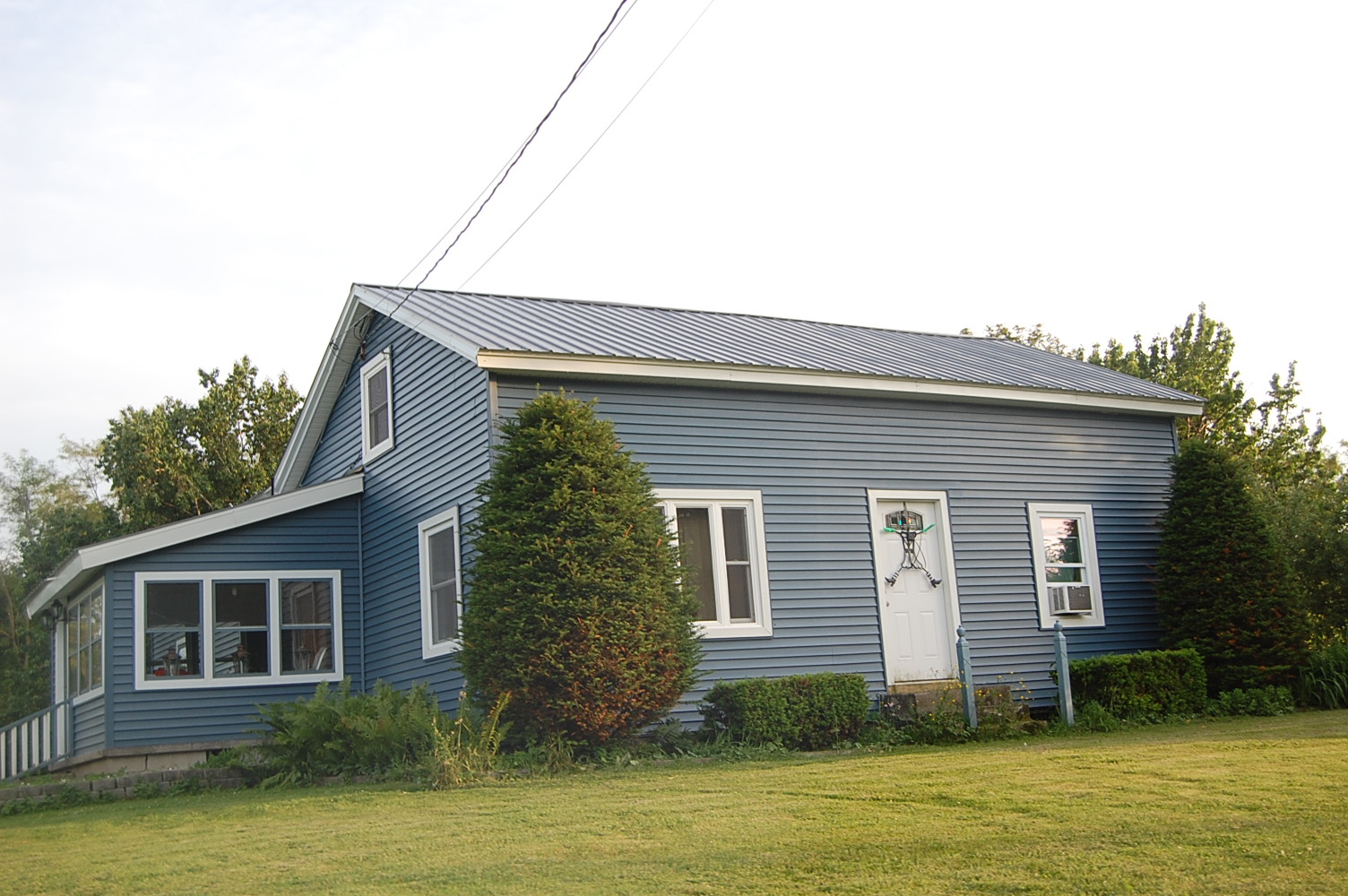
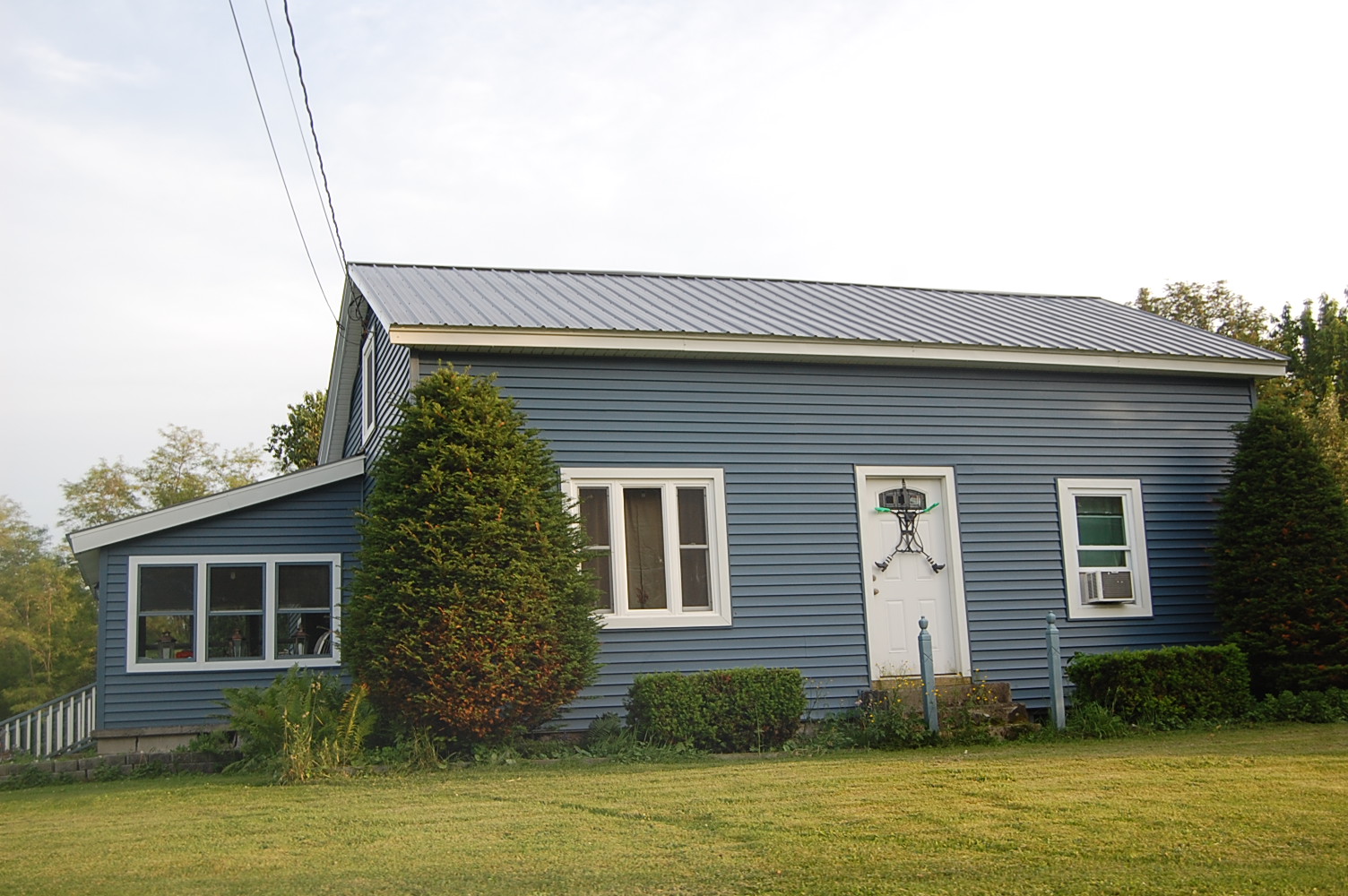
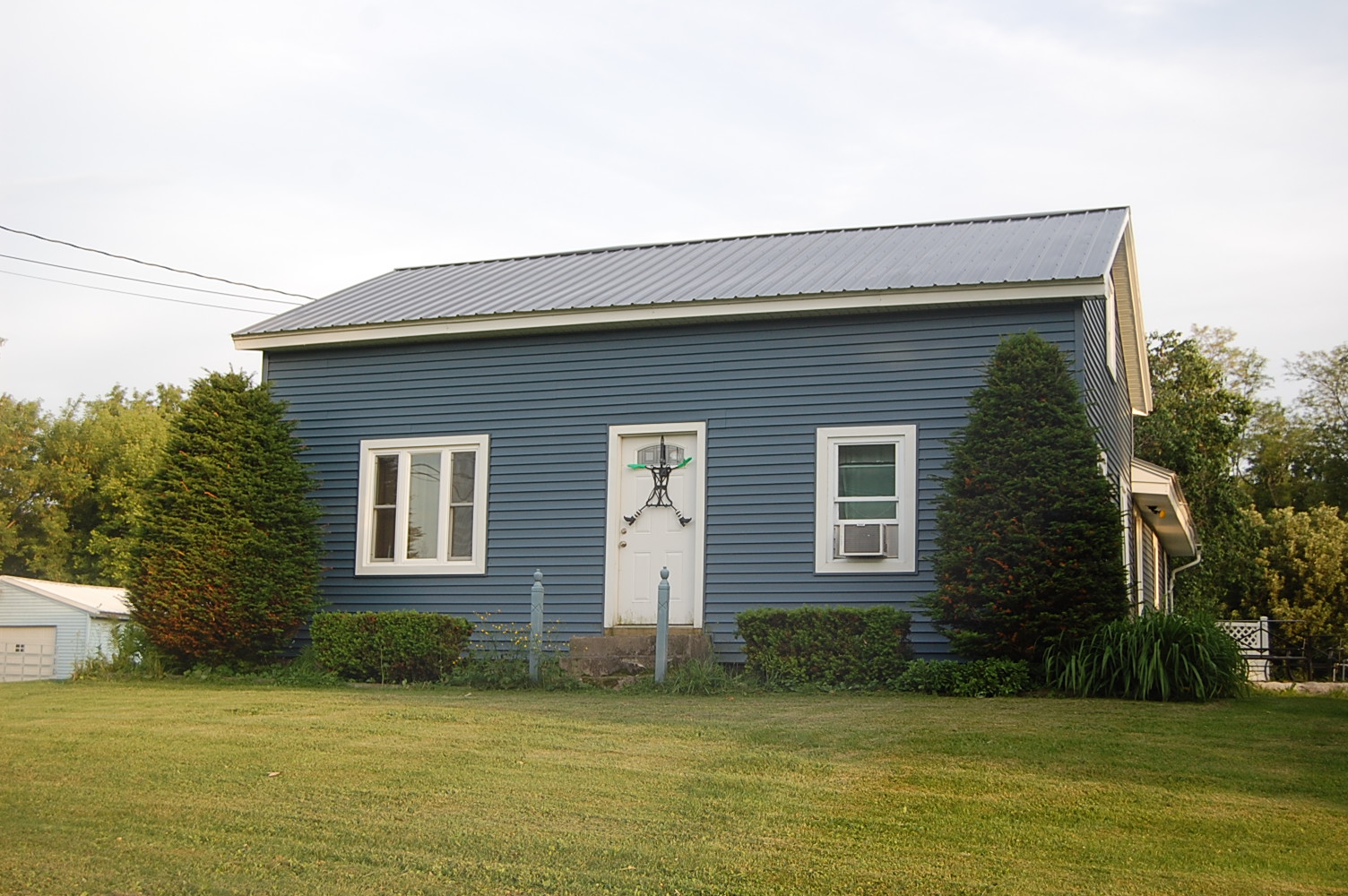
Its plaster exterior, which is a comparatively recent modification, reminds one of the quaint and picturesque houses of Brittany or Normandy. This particular house, which is in the town of Henderson near the Ellisburg town line, appears to have been built about 125 years ago by Zadock Dexter, who on March 3 1825 had paid his brother, William, $800 for 82.7 acres in that immediate area. On the preceding January 7, William had bought 137.95 acres in the same area from William Henderson, of Hyde Park, the land-owner, for whom the town was named. Whether William and Zadock Dexter had the same ancestry as the Dexter family at Black River is not apparent at this time. William died in 1856 and among his bequests were two cherry bureaus, one to his widow and one to his daughter. A $50 bequest to the American Bible society organized in New York in 1816 indicates that he was a religious man.
Zadock died on February 13 1870 leaving a will executed April 4 1864 giving his wife, Adaline B Dexter the house and 30 acres of land, which he had bought that same day from Cyrus N and Cornelia Bowe for $2,500. Three days prior to that Zadock and Adaline B Bowe had sold the neighboring 52 acres and the house shown herewith to their son, Bestow Dexter for $2,500.
Upon the death of Bestow Dexter, the property passed to his widow, Mrs Caroline E Dexter who disposed of it to Frank and Mary E Hamlin, town of Henderson, and the deed stated that the plot touched the 30 acres which Bowe had sold to William Dexter in 1864. When the Hamlins sold this quaint little house March 25 1919 they included but 1.8 acres of land with it. The buyer from the Hamlins was Mrs Josephine Putnam of the town of Henderson. She was a widow and kept the house and its 1.8 acres of land until September 9 1932 when she conveyed it to her son, Harrison S Putnam.
Mrs Putnam, who lived to be 91 and died on September 11 1937 was a native of Clayton, where she was born June 28 1846 daughter of Samuel and Elizabeth Myers Ault. Her husband was William Putnam, Henderson farmer, who died several years before she did.
Harrison S Putnam kept this place until March 27 1939 when he disposed of it to Fred E and Doris M Richmond of the town of Henderson and about five years ago they sold it to Clinton Wayne Carpenter who, with his wife, the former Miss June Alberta King, are the present mers. Like his father, Roy Carpenter, Clinton Wayne Carpenter is a carpenter by occupation as well as by name. On October 28 1941 he was married to Miss King, daughter of Mr and Mrs Lee King. Mr Carpenter was graduated from Union Academy, Belleville in 1938. His wife received her education at the Adams High school.
In reconditioning the home Mr and Mrs Carpenter refinished the original soft pine floors with their wide boards. When removing the old wallpaper they uncovered two fireplaces, one in the living room and one in a bedroom. The living room fireplace is equipped with Dutch oven for baking. The mantelpiece they found stowed in the attic and have replaced it. The broad chimney extends to the cellar bottom and back of it are old shelves for storing of preserves and canned goods. Fortunately Mr and Mrs Carpenter found skillets and fireplace utensils in the sealed-over living room fireplace.
Regrettably little can be found about the history of the Dexter family. Whether they stemmed from the same ancestry as the chair and furniture manufacturing Dexters of Black Biver there seems to be no recorded clue. In any event their old house is an interesting one and is of attractive design, although the original smallpaned windows have been removed and a modern picture window has been installed.
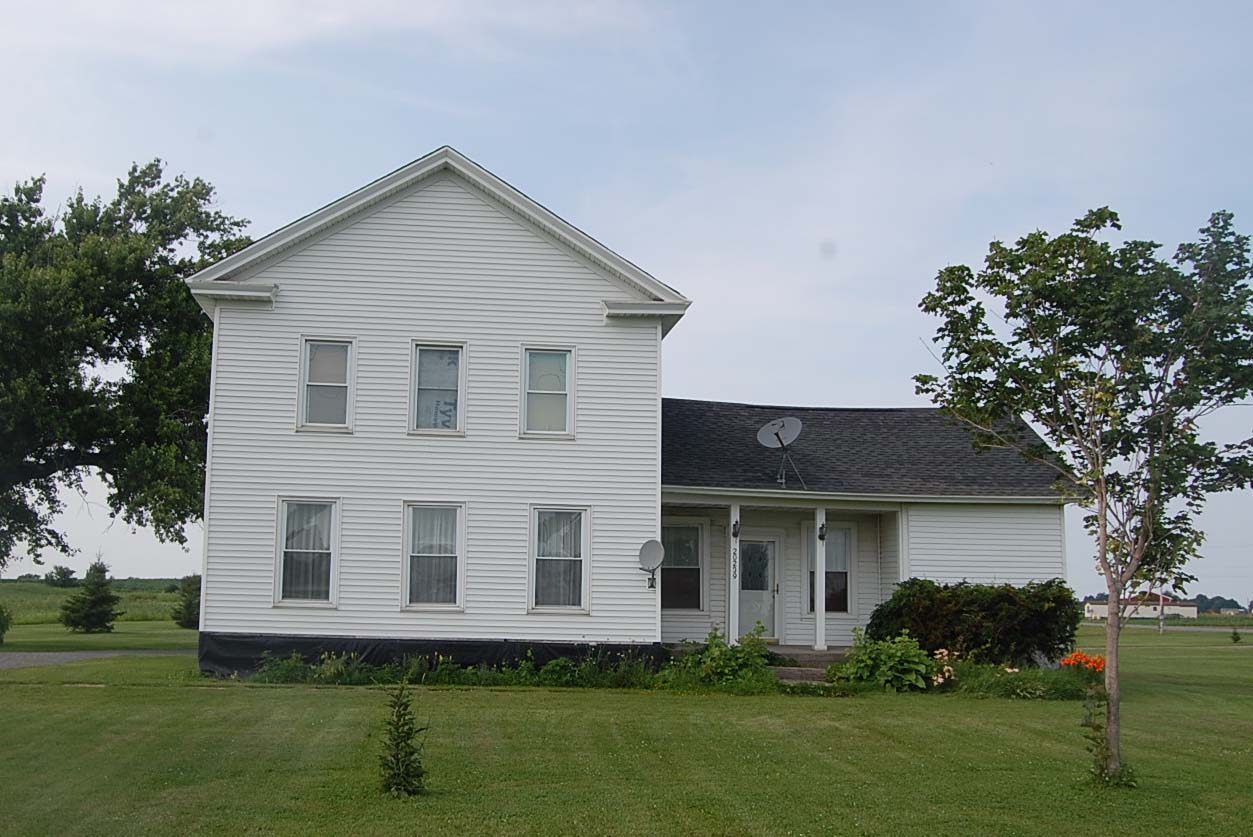
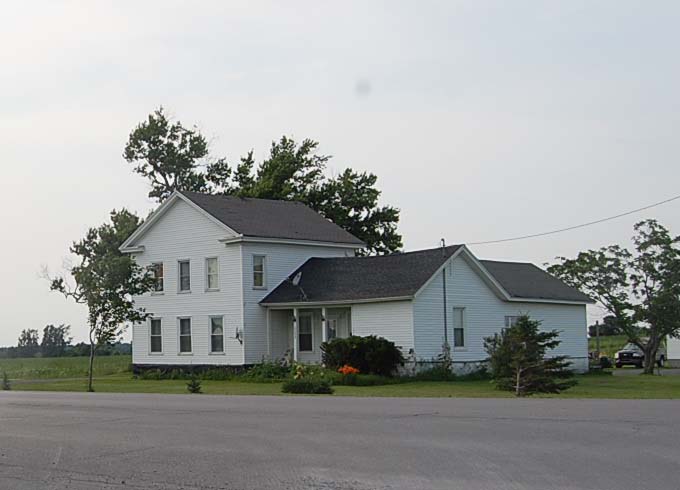
Whitford's Corners is just a little spot on the map, a little crossroads on the old Dry Hill historic highway out of Watertown to Adams. There a four-corners is made by the highway that runs to the village of Adams Center on the one hand, and to the hamlet of Rodman on the other. Whitfords, Harringtons, Heaths, Sills and Greenes were some of the early settling families in that picturesque area and it was from the Whitfords that the spot got the name of Whitford's Corners.
By some the place is known as West Rodman and in that vicinity lies the district which some of the old-timers called "Toad Hollow." It is only a few miles out of Watertown and as the traveler en route from Watertown to Adams reaches the crossroads he will note on the righthand an attractive frame house with heavy, fluted pilasters at the corners and an eliptical gable window decorated with ornate scrollwork. This is the old Whitford house, still possessed of its original twelve-paned windows in the upright and a return cornice above the pilasters. Both from the record and from the architecture one may well guess that the house is at least 105 years of age and possibly a little older than that.
It is generally referred to as the Nathan G Whitford house, but probably the original owner was Edward Whitford, one of the earliest settlers of the town of Rodman. Edward Whitford was born in 1778 and bis wife, the former Polly Maxon in 1781. They were married in 1799 and came to Jefferson County in 1836 from Rensselaer county, residing on the same farm until their deaths and both died in 1862. They had twelve children. Edward's death was on September 2. That he must have been a man of substance is testified to by the fact that on January 29 1836 he paid John and Ruth Avers $7,000 for 318 acres of Rodman land.
On June 25 1847 Edward Whitford sold adjoining parcels of 39.61 acres and 11.92 acres to Nathan G Whitford for $1,545. Incidentally these are part of the farm which goes with this house today, which farm was sold to Ralph D and Richard W Brown, present owners, by Mrs Jane Whitford Bakker, grand-daughter of Nathan G Whitford, November 1 1946. There are a number of other parcels in the present farm, among them being half an acre, 10.52 acres and .93 of an acre sold by Edward A Whitford and wife Minnie to David S and Susan Gurley January 29 1916.
Nathan G Whitford died October 10 1911 leaving most of his property to be divided between his two sons, N Andro Whitford and Jesse Samuel Whitford, in equal amounts. On April 1 1912 N Aldro (note: Which is it: Aldro or Andro?) Whitford and wife, Emerette, deeded their half interest in the farm to Jesse and Harriet Whitford, parents of Mrs Bakker. Mrs Bakker apparently inherited the property from them.
Jesse Whitford, son of Nathan G and Charlotte Heath Whitford, was born in the town of Rodman November 9 1861 and died March 10 1934 at the age of 72. He was married to Miss Harriet Kellogg of Adams Center on. January 14 1885. She died on June 7 1918. Their daughter, Jane, was married to Garrett Bakker, who for some time was a teacher at Portsmouth, Ohio. From the time that Edward Whitford located in the town of Rodman from Rensselaer county, there have been many Whitfords in the Whitford's Corners sector, which is not far from the boundary line between the townships of Rodman and Adams, and the family has been one of the prominent ones in the southern part of the county.
212 W Main
James I Hunt, who is believed to have been the original owner of this attractive century-old house of simple architectural design and beautiful front doorway on the south side of Basin Street, Brownville, was the village president in 1852 and was an early Brownville boot and shoe merchant. Next up the street from this house was the residence of Thomas Y How, the Princeton graduate and village pioneer who had loaned money to General Jacob Brown and had been associated with him in business transactions. A little further up Basin Street towards the village business center were the homes of Colonel William Lord, Brownville's pioneer industrialist and manufacturer of the Lord plough, and his son, Colonel Newton B Lord. From the estate of Colonel Edwin Kirby, son-in-law of General Brown, James I Hunt had bought the main parcel of land where this house stands on April 29 1853 and the previous year he had purchased adjoining lands. This house was probably erected about that time and consists of nine rooms and no fireplaces.
On January 14 1867 James I Hunt and wife, Eliza A, sold this house and lot to Mrs Ruth Lord. She was the wife of Henry Lord, who had established the Brownville Carriage Works in 1828 upon the April 5 of which year the village was incorporated.
It was from the estate of Mrs Ruth Lord that this property was conveyed to Albert E Lord on March 10 1875 Albert E Lord also having been a member of the prominent Brownville Lord family, and active in its government and business affairs. Not only had he been a prominent Brownville general store proprietor for many years, but he had been one of its postmasters.
Mr Lord retained possession of this residence but a comparatively short time, however, and on May 7 1877 his wife, Ann A Lord joined with him in selling the property to Adam W Walrath, member of another of Brownville's early and prominent families Adam W Walrath and his wife, Mary, died in 1887 and on December 6 1890 the estate of Adam transferred this house and lot to his son, Byron who retained title to it until after the death of his wife and on September 6 1907 conveyed it for the nominal sum of $1 to, his son, William Walrath, the present owner.
Born in the house, William Walrath was the son of Byron and Ardelia Walrath, and for many years prior to his retirement was employed by the Brownville Paper company. At Oswegatchie February 19 1902 he was married to Miss Katherine Sabourin. This year they celebrated their golden wedding anniversary. To them were born two children, Ravmond who died in 1942 during the last World War, and Mrs Robert T Warren also of Brownville. Diagonally to the rear of this house was located the Kirby family burying ground, although there are understood to be no persons buried there now. In the immediate vicinity of this house resided General Thomas Loomis, who was one of the founders of the Brownville Cotton Manufacturing company February 9 1814 also one of the first wardens of St. Paul's Episcopal church of Brownville, when it was formed October 13 1826 and in addition was one of the first trustees of the village of Brownville when it was incorporated April 5 1828.
In recent years the name of Basin Street, which is Brownville's main business street and the one over which the traveler generally passes on the main route between Watertown, Chaumont and Cape Vincent, has been changed to Main Street. Through the 152 years since this ancient Jefferson County community was started by the Quaker pioneer Jacob Brown and his family, this street has played a prominent role in the village life, both as a location for the residences of many of its outstanding figure and as a scene of many of its mercantile and industrial establishments.
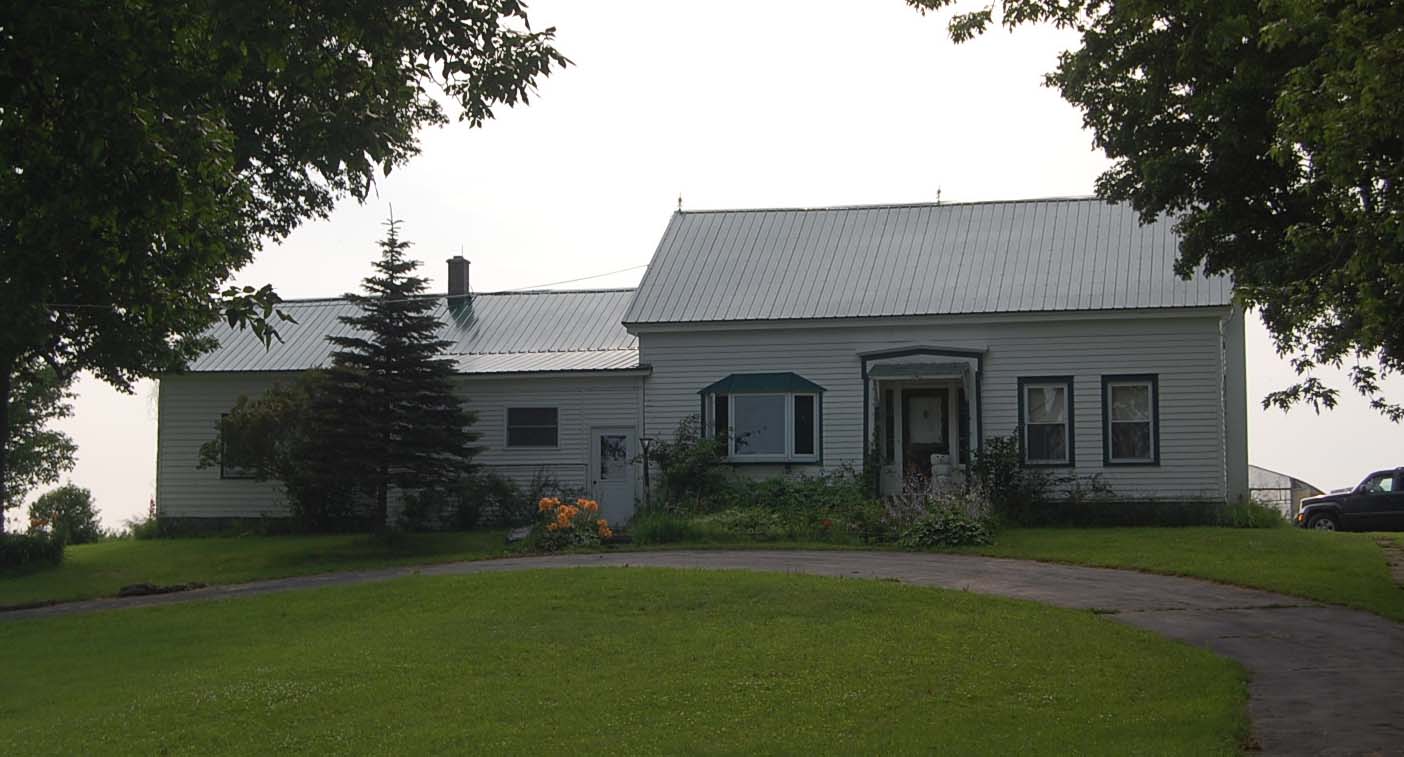
Aside from being one of the most scenically beautiful summer drives in Jefferson County the Dry Hill road between Watertown Center and Rodman is enhanced by a number of fine old houses. The mail box of one of these bears the names of John & Riley Harrington and from the title record it would seem that it must have been built about a century and a quarter ago.
It is near Whitford's Corners and consists of two parcels totalling 159 acres near the Adams-Rodman township line. For 48 years before Riley E Harrington and wife, Florence B Harrington, bought it August 24 1929 it was owned by the Sill family, and prior to that for about 38 years it was held by the Thomas R Green family. Before that, more than a century ago it was the property of Edward Whitford, one of the earliest settlers of the town of Rodman. The Harrington family is also one of the oldest in that town, the first of the line having settled there about 1800 along with the Heaths and Sills and today the sixth Harrington generation is residing in that area. Mr and Mrs Riley E Harrington bought it from the late Mrs Anna Gates Sill and the late Miss Ellen A Sill, widow and daughter of William E Sill, prominent Rodman farmer and former chairman of the Jefferson County board of supervisors. Mrs Sill and Miss Sill inherited the property from William E Sill, who had purchased it July 13 1910 from his brother, J Sterling Sill, former Rodman farmer and later partner in the local John Weekes & Son company. J Sterling Sill, in turn, had purchased it from his parents, John S and Arietta Winslow Sill, August 4 1896 and they had acquired it from Austin and Innocent Boynton March 15 1881. Only six years before, Mr Boynton had bought this identical farm from Mrs Delia OGreen, who had inherited it from her husband, the late Thomas R Green, who had purchased the two parcels of 115.25 acres and 43.75 acres and brought them together as this 159-acre farm.
Both parcels were bought by Mr Green from Edward and Polly Whitford, but at different times the 115.25 -acre parcel on May 17 1837 and the 43.75-acre parcel on June 1 1840 paying $1,700 for the former and $875 for the latter. Earlier than that it is more difficult to trace the ownership of the two plots, which might lead one to infer that the house had been built about that time, 1837 by Whitford or by Green. Riley E Harrington has felt that the house was built by Volney Ayers. However the county records do not connect Volney Ayers with the property. Definitely this farm came to Thomas R Green from Edward and Polly Whitford and there is more than a possibility that it may have been John Ayers who built the house, for on January 29 1836 John and Ruth Ayers sold the whole 318 acres of the Ayers farm in this area to Edward Whitford for $7,000. The deed describes it as bounded on the west by the Adams-Rodman line, on the north by Heath, Parker, Utley and Harrington lands, cast by Utley and south by former lands of Asa Clark.
On the same day January 29 1836 Edward Whitford bought from John and
Rebecca Adams for $6,000 a farm of 195 acres in the same area touching
the George Gates and Vilander Adams lands as well as Sandy creek. In 1806
Nathaniel Harrington, born March 14 1785 at Clarendon, Vermont, located
on 100 acres in the town of Rodman, having previously hunted and fished
much in that vicinity. He was the son of Caleb and Sally Perry Harrington,
had married Diana Edmonds, Vermont native, July 4 1808 and she moulded
bullets while he, a War of 1812 soldier, prepared to serve in the battle
of Sackets Harbor. A daughter, Electa, born April 23 1815 married Volney
Ayers, an Adams farmer. She had a brother Riley, born September 27 1820
farmer, who died
December 30 1862 Caleb Harrington, son of Nathaniel and Mary Harrington,
was born March 7 1851 and his father, Nathaniel, was born May 15 1726
marrying Mary Harrington, who was born October 17 1729.
Well preserved, unpainted clapboards, a dentilled cornice, original small, 20-paned windows, heavy, hand hewn frame timbers tied together with wooden pins, handmade cut nails and other early American construction features seem to brand this old South Champion farmhouse one of the oldest dwellings in Jefferson County.
Its similarity to the former Henry Coffeen house in this city makes it reasonable to assume it was built a few years before 1810 but all efforts to trace the intricate patchwork of its complicated title are as difficult as solving a labyrinthine puzzle. However, there fits into the puzzle a parcel of 40 acres conveyed to Solomon Perkins by William and Esther Campbell July 24 1807 for $500 which may be the answer to the problem.
Before, during and after Civil war days it was known as the George C Herrick house which, with seven parcels of land totalling 77.69 acres, was sold by Joseph Herrick, town of Champion, to George C Herrick, November 23 1847. Among those seven parcels was one of 40 acres conveyed by Solomon Perkins to Joseph H Perkins December 12 1812 the same which William and Esther Campbell had hold to Solomon Perkins July 24 1807. George C Herrick died July 18 1889 and July 20 1899 Sarah C Herrick sold this house and 77.69 acres to Timothy O'Neil, Carthage. On July 22 1907 Timothy and Wilda O'Neil, town of Champion, sold the same to Duane E Woodard, Copenhagen. Then on November 24 1930 Duane E and Sarah Woodard conveyed this place to their son-in-law and daughter, George H and Elsie M Waite. Mrs Waite died January 27 1941. Mr Waite is the present owner and residing with him and operating the farm is a son, Merritt D Waite, who has acquired adjoining tracts building the farm up to 175 acres.
Incorporated in the farm as it is today is land that has been in four
generations of the Waite family, and both the family and the farm possesses
many proud distinctions. First of the line in the town of Champion was
William Waite, whose wife was Sarah Dean, and they were the parents of
James Merritt Waite, Civil war veteran of the 14th New York heavy artillery,
hero of the battles of Spottsylvania Court House, Cold Harbor, the Wilderness
and Petersburg, one of the last of the Union veterans of Jefferson County,
and several terms commander of Joe Spratt Post, GAR, prior to his death
at Brownville February 26 1942 aged 98. He was born in Champion June 5
1843 and August 19 1873 married Miss Elizabeth Grieve, Deer River, who
died January 28 1935. For
years after the Civil war until he removed to Brownville in September
1918 James Merritt Waite was a prominent cattle dealer at Carthage
His son George H Waite, present owner of this house, has been a prominent South Champion farmer all of his life and on December 22 1897 was married to Miss Elsie Woodard, daughter of Duane and Seraphina La Salle Woodard of Copenhagen. Member of Carthage Grange No. 69 and of Jefferson County Pomona, Mrs Waite died January 27 1941 aged 59 survived by, besides her husband, a daughter, Edith, and son, Merritt D Waite.
Merritt D Waite, now 51 received his elementary education in the nearby old schoolhouse, which his grandfather attended and which is still used. On November 8 1928 he was married to Miss Helena Fitzgerald of Lyons Falls and they are the parents of 18 living children, 16 of whom are at home in this house and the two oldest boys are in the military service, Pvt Herbert being at Fort Devens and Duane of the reserves being now at Camp Drum. Mr and Mrs Waite hold the distinction of having the largest family in Jefferson County. Mrs Waite is now 41. Cooperating in the farm work the Waites maintain one of the finest herds of thoroughbred Ayrshire cattle in the north, 30 head.
For diversion the youngsters among the children go in strong for raising prize rabbits. But the old house, solid, war and comfortable, and the farm of which it is the manor, are as distinctive as the Waite family. Located on the old state stagecoach road between the hamlets of Champion and Denmark, which road was a link in the early state route from Watertown to Utica, this quaint old structure has one of the most beautiful environments in this section. Handsome old trees provide the immediate setting. From the rear door of the house sweeps across the broad Black River valley to the far blue hills beyond one of the most beautiful vistas in the county. The once heavily traveled state road is now a quiet, peaceful, little-traveled and out-of-the-way thoroughfare. Near the house still stands the old District two school, and also near is a small section designated "Cold Point," a name given it long age because of the extremely frigid winter temperatures. The old house has seven large rooms and in its early history there was a fireplace and bake-oven in the kitchen. Everywhere there are earmarks of age and from the farm's old relics Mr Waite this week gave to Curator J Reese Price of the Jefferson County Historical museum three of the oldest handwrought farm implements yet uncovered in this county. They are a primitive handmade pitchfork, an ancient sap gouge and a blacksmith's paring chisel for use in shoeing horses.
In the outer limits of the historic hamlet of Oxbow only a short distance before the Oxbow highway breaks through the Jefferson County line into St. Lawrence county's town of Rossie the traveler sees this unpretentious little native stone house, which has been plastered on the exterior. Its age is close to the century mark and from the record its first owner appears to have been Archibald Scott although for almost 65 years it has been known as the Fairbanks place.
The small plot of land, which goes with the house, was part of the General Lewis Morris tract and was embraced in the 18,000 acres bought by Abraham Cooper from Morris in 1817 inclusive of the entire site of Oxbow. On February 15 1849 Abraham Cooper and his wife, Harriet, sold 52.77 acres in the area where this house is to Foster Nostrand of New York City for $2,000. Then on November 16 1857 Nostrand sold the small plot, upon which this house stands, to Archibald Scott for $130. Obviously there was no house upon the plot at that time, according to the price paid, and the modest little house warn probably built by Scott shortly after his purchase of this land. A score of years later Scott sold the property on November 6 1877 to William Bailey for $600. Bailey kept it until April 23 1888 when Ann, his wife, joined him in its sale to Ezra Fairbanks for $600. Fairbanks conveyed it to his son, Arthur B Fairbanks on December 23 1912 and on October 5 1922,title passed to his wife, Mrs Minnie A Cranker Fairbanks. The property is now owned by Chester Fairbanks, son of Silas A and Charlotte Fairbanks.
Both the Scotts and the Fairbanks are old town of Antwerp families. James Scott, who settled in the town of Antwerp in 1833 was born in Roxburghshire, Scotland in 1800 and, before coming to America, was married to Helen Johnson, daughter of Henry Johnson, who was also a native of Roxburghshire.
Augustus Fairbanks, who was born in Maine in 1803 was the father of Ezra Fairbanks, first of the Fairbanks family to own this house. Ezra Fairbanks was born in Deerfield, NY, and there attended school until he was 16. Later he came to the town of Antwrep and on January 1 1857 was married to Emily M Bacon of the town of Antwerp. Their children included Silas A Fairbanks, Arthur B Fairbanks and Earl Fairbanks. Arthur B Fairbanks, now a retired Oxbow carpenter, was first married to Minnie A Cranker, daughter of John P and Betsey Ann Cranker. Mrs Minnie A Cranker Fairbanks died June 24 1929 and on December 28 1932 her husband married Mrs Sarah Ann Wears, widow of Ebenezer Wears, artist and member of the British Royal Academy. She died July 3 1942.
That the Fairbanks family in the town of Antwerp, like Jasan Fairbanks who was one of Watertown's first and most prominent settlers, was descended from the famous Jonathan Fairbanks who built the rambling Fairbanks mansion in Dedham, Massachusetts, in 1636 that is now the oldest frame house in occupancy in the United States, there is little doubt. At least circumstantial evidence of this fact is that one of the early settlers of the town of Anwerp was a Jonathan Fairbanks who, with one Hiram Fairbanks, paid William and Elcy Stewart of the town of Rossie $1,000 for 109.20 acres of land in the town of Antwerp on January 10 1834.
In the old family line from the original Jonathan Fairbanks of England who built the historic house in Dedham, now a national landmark and museum, the name Jonathan is a distinctive one.
Solon Massey in his "Links in the Chain," which was a series of biographies of the outstanding pioneers of Jefferson County, rated Major George White one of the outstanding settlers and great leaders not only in the town of Rutland but in the entire county.
The last land agent for Dr Isaac Bronson of Fairfield, Connecticut, who, early in 1804 had acquired the town of Rutland from William Henderson, to whom it fell in the division of the 11 towns June 6 1799 Major White was himself the owner of many parcels of land in Rutland, in Adams township, in the village of Watertown and in Sackets Harbor.
In the first organization of militia in the county George White became a Rutland Infantry captain anil fought as Sackets Harbor with distinction. On March 25 1814 he was appointed a major in the 76th Infantry. When the Jefferson County Agricultural Society was organized October 25 1817 he became a director and from 1838-1840 was president of the society. In 1823-5 he was one of the assemblymen from this county. From 1837 to 1840 he was supervisor from the town of Rutland.
Son of Simeon White, Major White was born in Hatfield, Massachusetts, October 10
1775 and resided with his father until he was 14. Then until 1794 he lived
with an uncle who was a Presbyterian minister in Hartford, Connecticut.
The next six years he spent in Trenton, NY, and with Enoch Eddy from Rutland,
Vt, came to locate in the present Rutland township of this county in June,
1800 the histories relating that he took up 266 acres of land. He was
married at Trenton in 1800 and became the father of ten sons and five
daughters. His wife, Lydia, died April 5 1841 aged 59 and on March 9 1853
he died at the age of 78. A son, Frederick White, who built the big stone
Union hotel, now the Masonic temple, at Sackets Harbor in 1817 became
one of the first presidents of the
Jefferson County Bank, the county's first bank, when it was located at
Adams. First of Major White's land purchases indited in the county records
was a parcel of 165 acres to the north of
his later homestead farm which is on the old state road from Watertown
through Rutland Center and Champion. That 165-acre parcel was acquired
from Dr Isaac and Anne Bronson on September 8 1808. March 30 1813 Major
White added an adjoining 154.70 acres.
Then on March 3 1817 he purchased the homestead farm of about 250 acres
from Goldsmith Coffeen for $4500 and the price would indicate that the
house was on it at that time. The record shows the exact acreage 238.72
but, in his will executed April 3 1838 he stated that it was about 250
acres and definitely declared that it was the farm he bought from Goldsmith
Coffeen on March 3 1817 "being the same farm on which I now reside."
This farm with livestock, farm equipment, hay, grain, and provisions he
willed to his son, Edwin C White, but on April 7,1846 five years after
the death of his wife, Major White deeded a half interest in this homestead
to Edwin for $1,000 the other half interest having been deeded to Edwin
January 6 1843 for $4,000. But in his will Major White gave his widow his
household furnishings and provided that Edwin must care for her and her
mother, Hannah Williams. Old residents declare the house shown herewith
to have been the home of Major White. It and an undetermined number of
acres, well over 200 however, are now owned by Lee S and Nellie Ballou
who purchased the place from the Rubert H and George F Ganter estates
March 29 1947. Descriptions of the land in the Ballou deed do not correspond
with this in the Goldsmith Coffeen deed to Major White.
But this house, of pleasing Georgian architecture and more attractive in appearance before it was covered with imitation brick, is in the same area of the town of Rutland however as the property sold by Goldsmith Coffeen to Major White and the discrepancy in descriptions may be due to the fact that Edwin C White himself had mainland transactions back and forth in the same sector with the result that he may have added to and sold off portions of the Coffeen place.
Certain it is that the property owned today by Mr and Mrs Ballou was purchased by Rubert H and George F Ganter from Mrs Jennie E and Miss Ida M Quencer May 1 1922. The Quencers in turn bought it from Mrs Carrie F Hyde of this city August 1 1918 and Mrs Hyde got it from the estate of Mrs Sarah A Hadcock October 16 1906. By the will of. Mrs Hadcock's husband. Solomon Hadcock, recorded December 15 1881 and executed June 27 1851 it came to her. About 200 acres of it was purchased by Solomon Hadcock from Edwin C and Laura J White on December 8 1860 for $10,000 and on the same date Solomon Hadcock acquired two other parcels totaling 119.16 acres in the area from human and Rosana Osmer for $5,515. An earlier deed of April 1 1856 shows that Edwin C and Laura Jane White had sold the 306.90-acre parcel to Datus Osmer for $15,600 which parcel contained the nearly 200 acres sold in 1860 to Hadcock. After 1856 two parcels of 90 and 17 acres had been sold off the 306.90-acre tract.
But to return to the story of the Whites, something of the tragedy that invaded the life of Frederick White may be gleaned from prosaic county records, one of which dated August 10 1827 shows Frederick naming Major George White trustees of lands in the towns of Adams, Henderson and Hounsfield in order that Mary B White and Alexander White, wife and son of Frederick White may be provided for. Others of October 20 1828 are deeds of several properties in Sackets Harbor by Frederick White to Major White. And the climax is a power of attorney executed to Major White October 19 1831 by Mary B White, widow of Frederick White, empowering him to get what salvage he can from her husband's estate for her.
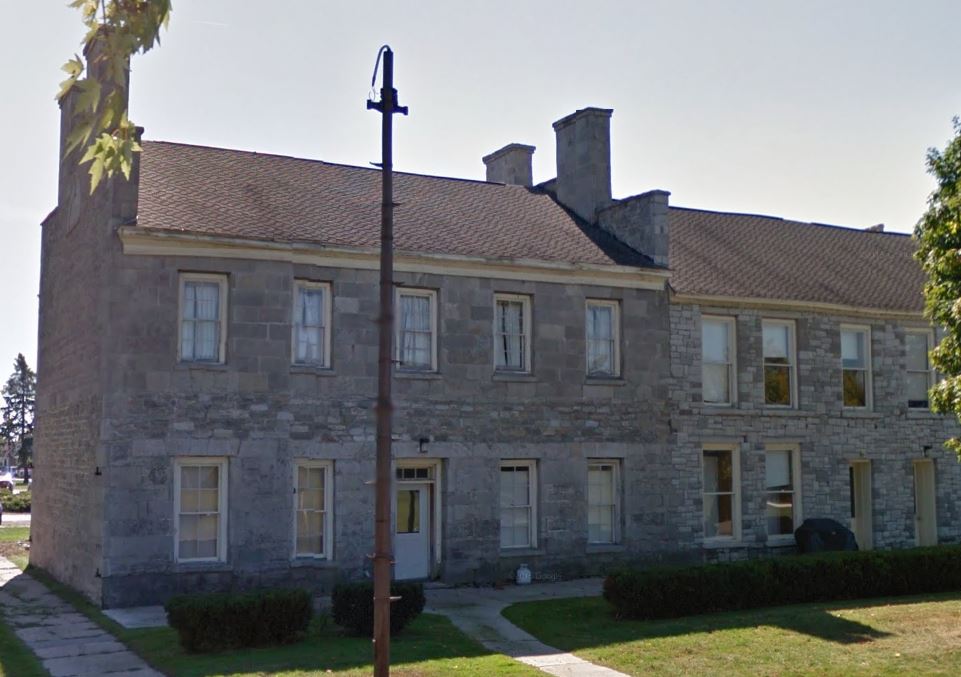
Lake navigation had not yet closed and our northern New York winter had not set in in earnest when, on November 21 1848 a steamboat nosed up to the Madison Barracks dock at Sackets Harbor and discharged two passengers who were destined to become famed in world history.
One was 26-year-old Lieutenant Ulysses Simpson Grant, 4th U S Infantry, freshly transferred from the Detroit, Michigan, barracks of that regiment to the two companies of the same regiment newly stationed at Madison Barracks under Major Francis Lee. The other was this young army officer's bride of three months, the former Miss Julia Dent, daughter of Colonel Frederick Dent, planter and typical Southern gentleman, of St. Louis, Missouri. Browned a deep mahogany by nearly three years of fighting in the war with Mexico Lieutenant Grant had been returned from the scene of battle barely a third of a year and his marriage to Julia Dent had only taken place on the August 22 preceding their arrival at Madison Batracks.
The transfer was ordered by Colonel William Whistler, commanding officer at the Detroit barracks, where Lieutenant Grant had served as quartermaster. Whistler, uncle of the distinguished artist, James Abbott McNeil Whistler, has been suspected of making the change to make room for a favorite. Young Grant filed protest but the order of Major General Winfield Scott for his return to Detroit came after navigation had closed and travel by land was not desirable.
No army or war department record exists of where Lieutenant and Mrs Grant were domiciled during the winter of 1848-49 while they were waiting for steamboats to ply the lakes again in the spring and take them back to Detroit but the late Colonel Hugh D Wise is authority for the statement that the late Colonel Walter B Camp, who knew Grant, advised him it was in the apartment shown herewith just west of the sally port of the post.
Here the Grants had two rooms on the ground floor and it is not improbable that they were part of the quarters of the then commanding officer, Major Francis Lee, for Grant had served.under him in Mexico and it was customary for the post commandant and the officer next in command to occupy the quarters flanking the sally port on either side. These quarters were distinguished from the rest of those in officers' row by their fronts of smoothly faced limestone and their four tall chimneys. It was in ante-Civil war days that "Prince" John Bankhead Magruder, a Virginian who, as a lieutenant in the First Artillery, had served in Mexican war battles with 4th Infantry Lieutenant Grant, had occupied these same quarters west of the Madison Barracks sally port and there given his lavish and glittering parties.
As, commanding officer at Madison Barracks, Magruder, a Southern socialite of the first water, was noted for the splendor of his regimental mess, with everybody in gay dinner jackets, and the pomp and glitter of his parties ale up his own salary and all he could borrow from the other officers.
With a group of British officers from Kingston as his guests at one of these parties, he so overawed them that the visiting commander remarked: "How can an American officer entertain so lavishly? What is your pay?" is my "Kelly," said Prince John to his orderly, "what pay?" and, turning to the British colonel, "I really do not know. I always give it to him." Not only did he borrow and spend money, but he borrowed the silverware of the other officers to make his social affairs impressive.
Historian Benson J Lossing, however, brands Magruder "an infamous character," for in the mid-April Secession days of 1861 Magruder told the president at the White House: "Mr Lincoln, everyone else may desert you, but I never will." Having done his utmost to corrupt the troops of Washington city, he fled two days after that remark to Lincoln to join the Confederacy and as colonel in Provisional Army of Virginia on May 8 1861 was assigned by Major General Robert E Lee to command the Virginia forces in and about Richmond. From that he arose to become the Confederate major-general in command of the District of Texas, New Mexico and Arizona April 4 1865.
Contrasted with the flamboyant, deceitful Magruder was the quiet, unassuming, deliberate, methodical Grant who, after his first stay of slightly over three months at Madison Barracks, returned to Detroit March 1 1849 was promoted to a captaincy August 9 1853 resigned from the army April 11 1854 became a Missouri farmer, returned to the army a colonel at the outbreak of the Civil war, arose to the command of the Union armies, was commissioned lieutenant-general March 9 1864 was first elected president in 1869 and again in 1873 and died at Mount McGregor, NY, July 23 1885. Such was this square-jawed native of Point Pleasant, Ohio, born April 27 1822 son of a tanner, Jesse Grant and Hannah Simpson Grant.
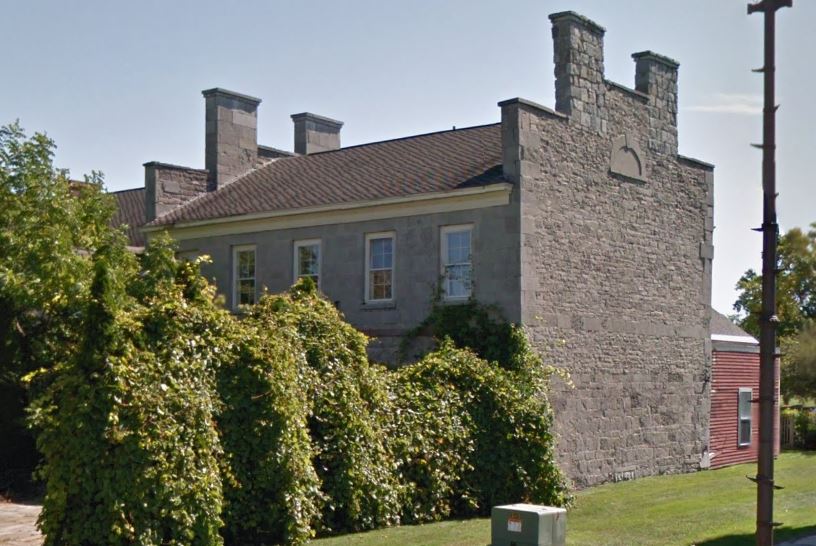
There are some who insist Mat Lieutenant Ulysses S Grant and his young wife had rooms in these officers quarters immediately east of the sally port instead of west of it when they came to Madison Barracks November 21 1848 for the first time.
With its four large chimneys and its front faced with rectangular blocks of smoothly cut limestone the quarters immediately east of the entrance to the military post duplicate in appearance the quarters immediately west, in the latter of which the late Colonel Walter B Camp is quoted as saying that Grant first resided. Ill-fed soldiers of Colonel Hugh Brady's 2nd U S Infantry constructed Madison Barracks of native limestone between August 1816 and October 1819 upon a reservation of 39.25 acres, as the result of an order issued by Major General Jacob Brown in the summer of 1815.
Upon a half-circle in the gable of the east quarters shown above is inscribed "Commenced August 1 1816. Completed October 1819 " and upon a similar half-circle in the gable of the west quarters shown last week, "Erected by 2nd Infantry."
Lieutenant U S Grant served twice at Madison Barracks, his first detail ending at the beginning of March 1849 when he returned to 4th Infantry headquarters at Detroit. His second detail began with the abandonment of the Detroit barracks in mid June 1851 and his arrival at Madison Barracks June 27 with fne 4th Infantry in command of Colonel William Whistler. That detail lasted until the regiment left June 18 1852 under transfer to the west coast.
Many stories are told of Grant's life at Madison Barracks, although mostly
legendary in nature. It is doubtful if many of his alleged exploits occurred
during his first detail, which lasted but a little over three months when
he was practically unknown to the villagers, having been of a taciturn
nature and the time having been the dead of winter. However, it is possible
that he joined the Odd Fellows during that first detail, for Wampanoag
Lodge, No. 311 had been formed in September 1847. For the most part it
is likely that he concerned himself with his military duties and the balance
of the time remained at his small apartment which, Colonel Camp declared,
Mrs Grant tried to make "cozy and homelike."
The second detail began at the edge of summer, lasted a year and unquestionably told another story. A smoker of cigars and a chewer of tobacco, young Grant nevertheless foreswore drinking intoxicants because he thought it "unsafe." The Sons of Temperance was developing rapidly in 1851 and it is believed that then was the time he helped found Rising Sun Division, No. 210 of that organization.
As a member and officer of it, it is related that he marched in the parades of abstainers through the streets of Sackets Harbor amid the jeers and catcalls of the drinkers. However, the end of 1852 saw the wane of the Sons and after his regiment went to Fort Vancouver, he ceased his membership in it.
From infancy he had displayed a fondness for horses and horsemanship, possessing the rare ability to ride successfully the most fractious animal immediately, and on numerous occasions, it is said he rode the ten miles to Watertown in 45 minutes, racing his village lawyer friend Charles W Ford to break a tie at checkers or whist.
Checkers was one of his favorite games and Watertown's checker champion was a shoemaker, to whose place Grant often rode for a test of wits, for he had vanquished the best of the checker champions at the Barracks. And one time to decide the issue Grant challenged the shoemaker to a footrace around Public Square. Grant, with his linen duster flying, won with ease.
Despite his quiet, untalkative demeanor he became valuable when the subject
of the Mexican war was broached. His judgments were sound and he was popular
witn his men. Just as much as he loved horses, a love first displayed
when, as a mere infant at a circus, he was permitted to ride a pony, he
just as vigorously detested band music from infancy. And on his second
detail to Madison
Barracks Colonel Whistler's daughter, Louise, caused the regimental band
to concert on the parade grounds each evening. But before the first note
was sounded each night Lieutenant Grant was on his way to Sackets Harbor
village or to Watertown for a game at checkers or whist. In this county
there are few mementoes of his life at that post. In the museum of the
Jefferson County Historical society there is a glass decanter, which it
is claimed he used, and Mrs Edward V Mason of Sackets Harbor had and may
still have the cradle, in which Lieutenant Grants first-born, the later
Major General Frederick Dent Grant, born in St. Louis, Missouri, May 30
1850. was rocked, for this child was but a little more than a year old
when his parents came to Madison Barracks the second time.
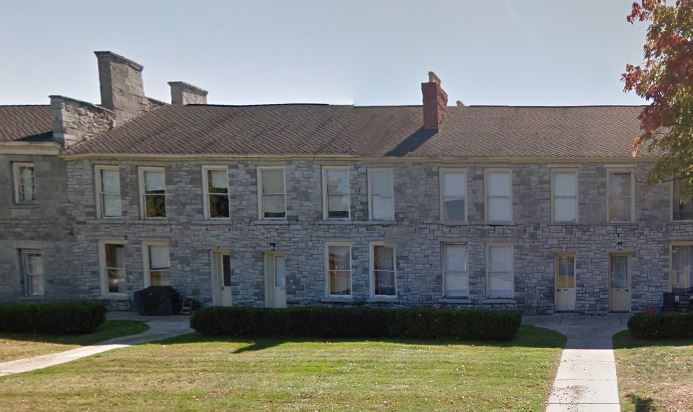
Legend would have it that Lieutenant General Ulysses S Grant resided in a number of different quarters at Madison Barracks during his two details there as a young lieutenant of the 4th United States infantry, and it is probable that he was located in at least two different ones. It seems unlikely that he would have the same one twice with a two-year interim between the two details.
Some of the old residents of Sackets Harbor declare that he and Mrs Grant stayed for a short time at the big limestone Union hotel, now the Masonic temple, the first time they came November 21 1848 but this seems unlikely.
It is said that on one of his details to Madison Barracks he and Mrs Grant occupied apartment No. 4 in officers' row, which is the one immediately west of the apartment abutting the westerly side of the sally port. The latter is the one which the late Colonel Walter B Camp, who knew Grant at Madison Barracks, said that he occupied.
Apartment No. 4 is the one with the front entrance door to the left of the picture shown above, and it is strongly possible that the Grants resided there for a time. In Sackes Harbor's Pickering-Beach historical museum, of which Mrs Pauline Alvin is curator, are a number of interesting articles owned or identified with the Grants during their stays at Madison Barracks. One of these is a small cherry drop-leaf table, and another a small cherry sideboard, both loaned by Mrs Bert Hazelwood. Then there is the large and figured silver tankard given to Lieutenant Grant and said to have been lost by him to Captain Charles Morris in a card game. It is loaned by Dr A G Hodge.
A small brass candlestick, a small folding leather drinking cup, a long-barreled fowling piece or sporting gun, and a big powder horn filled with black powder, are still other Grant mementos in the museum. A man of many names, Grant was born at Point Pleasant, Ohio, April 27 1822 son of Jesse and Hannah Simpson Grant. He was christened Hiram Ulysses Grant. As a youngster in school his mates called him Lyss. Later he was called "Texas" and Lyssus, but the name he wanted to be called was Hiram and in his schoolbooks he signed his name Hiram U Grant.
He had no liking for the military but his father thought that West Point would cheaply solve the problem of higher education and induced Congressman Thomas L Hauler to appoint him March 3 1839. Mistakenly Hamer sent in the name Ulysses S Grant. Brass-headed nails studded the initials "HUG" on young Grant's trunk. Feeling these might lead to embarrassments at the academy he changed them to "U H G" Arrived at West Point by steamboat May 29 1839 he signed "Ulysses H Grant" at Roe's hotel on the edge of the military reservation. On the adjutant's register at the academy he signed "Ulysses Hiram Grant." Adjutant George Waggaman informed him there was no appointment from the War Department for "Ulysses Hiram Grant," but that there was one for "Ulysses S Grant," and that so he must sign to conform with the official listing. From that time on through his commission as lieutenant-general, his appointment as commander-in-chief of the Army, his election to the presidency to his death at Mount McGregor, NY, July 23 1885 he was Ulysses Simpson Grant.
At West Point his name was abbreviated to "U S" Grant and jocularly the cadets dubbed him "United States" Grant and ''Uncle Sam" Grant. He could not keep step to the band and was nicknamed "Country Sam," but he was cool, methodical, did his work well, was a daring horseman. He smoked much but abstained from intoxicants for the benefit of wildly-inclined plebes. Fred Dent, a Missourian was his final-year roommate. In June, 1843 Grant was graduated. July 28 he was assigned to the 4th Infantry at Jefferson barracks, St. Louis, Missouri One day he rode to "White Haven" the pretentious home of the Dents in St. Louis. That was the beginning of his courtship with Julia.
VanBuren "the little Magician" was president, Major General Winfield Scott head of the army, Major Richard Delafield superintendent of the Academy when Grant entered. John Tyler was president when he graduated. In the spring of 1844 the 4th Infantry was transferred to Camp Salubrity near Natchitoches, LA, brevet Brigadier General Zachary Taylor commanding. Grant was given temporary command of a company. March 1 1845 congress voted to annex Texas and the Mexican war was on. It ended in the spring of 1848 and Lieutenant General Grant had proven himself a fine military tactician, but he detested peacetime routine and resigned in 1854 to join his father in the leather and saddlery business at Galena, Ohio, but when the Civil War came on he was back in the army to remain until his election to the presidency in 1869.
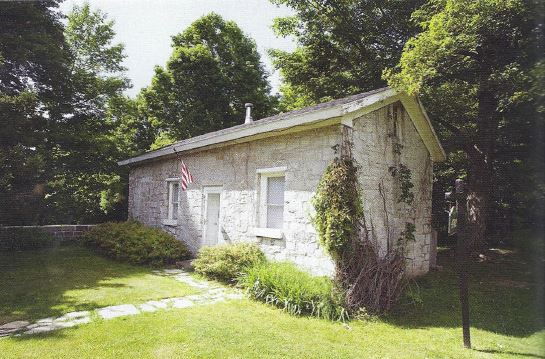
Considerably older, perhaps, than the present LeRay mansion now occupied as the Camp Drum commandant's residence, is the old one-story native limestone servants' house immediately to the rear of the mansion near Le Raysville. The condition and type of construction of the little house indicate that this may be so. It is a matter of recorded history that the James D LeRay de Chaumont mansion now standing was started in 1825 and completed in 1827. It replaced one of wood, built between 1806 and 1809 on the same site, and which also was a pretentious and luxuriously equipped abode, according to Gouverneur Morris and other contemporaries of James D LeRay who himself owned over 348,000 acres of northern New York lands at the time he assigned his assets to his son Vincent on December 31 1823 for the benefit of creditors.
When the long, low servants' house was erected is unknown. It may have been a few years after the original mansion was constructed 1806-1809. The type and condition of the walls implies early Republic craftsmanship. All is a matter of conjecture concerning the date of building it, and possibly the time was 1825-1827 when the present plastered stone mansion was built.
During the decades of existence of this small stone house shown above it has been variously occupied by servants, caretakers and relatives of those who lived in the big mansion.
From the time James LeRay came in 1808 to reside in the original mansion he had a substantial retinue of servants and others including a physician, cure, secretary, tutors and agents, and it is understood that some of these were quartered in the mansion itself. Son of Jacques LeRay of Chaumonl-sur-Loire, France, who had advanced hundreds of thousands of francs to outfit an army and navy for the American colonists in their struggle for independence from England, James D LeRay was a close friend of Benjamin Franklin, Gouverneur and Robert Morris, Alexander Hamilton, Thomas Jefferson, James Monroe and other great American leaders.
Having come to the United States to negotiate reimbursement of his father by the government of the new republic, he purchased 220,000 acres of northern New York virgin forest from the Antwerp company for $46 - 315.12 on January 3 1800.
His purpose was to sell this land in small farms, colonize the area, and realize a profit on his investment. He married Grace Coxe, a New Jersey girl, sent Dr Baudry over from France to select a site and superintend the construction of his first mansion near LeRaysville in 1806 and moved into it in 1808 befo.re it was completed. Seventeen years later it was decided to erect a still more pretentious mansion. Accordingly it was started in 1825 and finished about two years later, five years before LeRay returned to France for all time. Durant and Peirce, most house-conscious of any of the Jefferson County historians, say in their history brought out in 1878 concerning the original mansion: "In 1825 the work of demolition of the LeRay residence was commenced, to make room for the erection of a more elegant and luxurious one. It was built of stone, and smoothly plastered upon the outside."
Historian John A Haddock is the only one who says differently. "In 1822 the beautiful villa in which Mr LeRay resided, was burned to the ground, and the present grand mansion was erected upon the ruins. It is constructed of limestone, plastered with cement, and modeled somewhat after the style of his father's chateau at Passy, in France, but not so elaborate or expensive in its construction." One of the Deferiet letters of 1823 mentions a small fire and Colonel and Mrs Harold Remington who acquired the mansion property in 1936 report evidences of fire under the wooden addition that attached to the rear of the servants' house.
The large oval, castiron fire mark bearing the initials "U F" upon the righthand front of this little house, and showing plainly in the picture, has no identification with the LeRays, as it was purchased by Mrs Remington in an antique shop and caused to be screwed to the building. The United Firemen's Insurance company was not chartered until April 2 1860. This fire mark was made after that
Upon an estate which amounted to 2,082.53 acres when Vincent LeRay de Chaumont sold it to Jules Rene Payen of New York City on October 12 1840 James Donatien LeRay had resided in princely style for many years prior to his final return to France June 15 1836. There, in his native land, he died December 31 1840 approximately two and one-half months after his son had disposed of this magnificent estate to Payen, an engineer and chemist much interested in the manufacture of gunpowder.
James LeRay 's tall-pillared mansion included broad lawns hedged in by thick stands of magnificent trees, swept curving drives which united in one long entrance drive, which made its way through a gateway to tap a road that connected with one leading off at right angles to join the main Le Raysville highway. In a graceful coach drawn by four horses he rode to and from his manion. two post riders mounted on saddle horses, coming up at the rear. Fine plants, shrubs and fruit trees ornamented the estate. Fine cattle, horses and sheep were maintained on his farm, for he was keenly concerned with agriculture and one of the leading exponents of New York state in its development.
He was one of the first to import Merino sheen into this country, and in 1817 he was a patron of the Otsego county cattle show, first to be held in the state of New York. He promoted the meeting held at Isaac Lee's hotel in Watertown October 25. 1817 when the Jefferson County Agricultural society was formed, of which he became the first president. The first Jefferson County cattle show was held on September 28-29 of the next year, thereby becoming the second of its kind in this state.
James LeRay 's cattle and sheep were among the best in the countrv and won many first prizes at the cattle shows and fairs of his day in this areA Of his large staff of retainers was his farm supervisor who, it is understood, occupied the plain-styled limestone farmhouse pictured above.
This farmhouse stands at the southeastern end of the mansion clearing. It was located at considerable distance away from the mansion in order that it might in no way detract from the elegant appearance of the latter. A small waterfall of purest springwater at the house was a valuable dairy asset. An extensive deposit of fine building limestone on the estate undoubtedly supplied the stone for this farmhouse as well as for other buildings. The date of construction of the farmhouse is unknown, but it was probably at the time when James LeRay began to develop his dairy and herd of cattle which, likely would have been a few years after lie built his first mansion, a frame structure, the timber for which was felled in the fall of 1806 sawed in Brown's neighboring mill the ensuing winter and the frame raised early in 1807 under the superintendence of Ethni Evans. Evans also is believed to have been the master carpenter of that first LeRay mansion, which gave way in 1825 to the more pretentious present one standing as the commandant's residence at Camp Drum. In clearing the forest for the mansion and other buildings many elms were cut, but maples, beeches and pines were left, there being a heavy stand of beautiful white pines in that sector. From the time Jules Rene Payen bought the LeRay mansion estate in 1840 until his great-granddaughter, Mrs Fred C Anderson, the former Miss Mabel A Phelps and her husband disposed of it to the late Reverend Henry W and Sylvia Livingston Bell August 6 1934 it was held in Payen family ownership.
The New York Stock Land Bank of Rochester took over the property from the Bells and sold it to Colonel and Mrs Harold Remington of this city November 2 1936 and they owned and improved it until the federal government acquired it for its Pine Camp adjunct through a declaration of taking dated September 20 1941. Since that time it has been military reservation property assigned to the occupancy of the camp commander.
42787 County RD-100. (1000 island Park Rd)
Octagon houses in the United States are a rarity. One of the extreme few of them in New York state is "Waving Branches," the cottage of Mrs Lois F Gardner of Rochester at the Thousand Islands summer resort colony of Fine View between the American span of the Thousand Islands bridge and Thousand Island Park on the south shore of Wellesley island.
Fine View originally was known as Waving Branches Settlement and from
that this octagon cottage, which was first christened "Wild Brier
Lodge," gains its present name. While "Waving Branches"
does not approach in age the great bulk of houses in this series, being
approximately only 75 years old, it bears a wealth of interesting history.
First, it was the summer home of Judge Laban H and his wife, Mrs Sarah
Ann Ainsworth. Judge Ainsworth was this city's first recorder or city
judge, father of the city's first charter and justice of the peace for
many years. He was an important factor in the incorporation of the Thousand
Island Park association in 1876.
He was also a member of one of Cape Vincent's earliest and most prominent
families, a petitioner for the incorporation of that village June 14 1853 and one of the trustees chosen at the first election July 8 1853.
Not the least of the rich history of "Waving Branches" has been
its ownership by the late Earle Ainsworth Gardner, Rochester, grandson
of Judge Ainsworth, and contributor of pictures of over 100 Thousand Island
region steam boats published in the Watertown Daily Times in 1947-8. He
was an outstanding historian of Thousand Islands steamboats and steamboat
lore, inventor and manufacturer of GarGraves trackage for miniature railroads.
He was the son of George B Gardner, cocreator of the two-tone whistle
of the familiar Thousand Islands steamboat, "New Island Wanderer."
Earl Einsworth Gardner died November 29 1949 age 56 but his widow, Mrs
Lois F Gardner, carries on ownership and occupancy of "Waving Branches"
cottage.
According to family tradition "Waving Branches" octagon house
was built in 1876 but county records show that the lot, upon which it
stands, was bought by Mrs Sarah Ann Ainsworth, city, from Charles T
and Mary C Nunn on August 19 1877 for $50. Mrs Ainsworth died in 1885.
Judge Ainsworth died in 1902. Both are buried in a Brookside cemetery
lot purchased by Judge Ainsworth October 15 1869.
It was probably about 1861 or 1862 that Attorney and Mrs Laban H Ainsworth
removed from Cape Vincent to Watertown, for they are not shown in the
Watertown directory of 1860 but are in the directory of 1863-4. At that
time they resided at 10 Massey Street, and Mr Ainsworth was head of the
local law firm of Ainsworth & Earll, of which George D Earll who boarded
at the Kirby House was the partner and which had offices over 16 Court
Street. Later Mr and Mrs Ainsworth resided at 82 State Street, in the
house immediately west of the residence of the late Mayor James B Wise
which was recently razed to make way for the Arlington Street extension.
The Ainsworth house now stands on the westerly corner of the new street
and south side of State Street. The city directory of 1888-9 shows that
Judge Ainsworth was residing there with his son-in-law and daughter, George
B and Hattie Z Ainsworth Gardner, parents of the late Earle A Gardner.
On June 1 1889 Judge Ainsworth sold the property. On September 21,1887
the heirs of his deceased wife sold "Waving Branches" by quitclaim
to Augustus Ainsworth who, the same day conveyed it to Hattie Z Gardner
and some 20 years later title passed to her sons, Howard A and Earle A
Gardner. Still later full title was acquired by Earle A Gardner who conveyed
it jointly to himself and wife, Lois F Gardner, September 2 1947.
In "Waving Branches" with its perfect octagon living room is a fine accurately scaled model of the famous steamboat "St. Lawrence," which was made by Earle A Gardner. There is a life-size carved eagle that long perched over the pilot house of that ship. There are paintings by John C Upham of familiar Thousand Islands steamboats, photographs of others and many other steamboat relics, but the whistle of the "New Island Wanderer" Mr Gardner gave to the Canada Steamship Lines.
"Waving Branches" is indeed an historic landmark which should
be long preserved not only that but Judge Laban H Ainsworth was a colorful
member of the Jefferson County bar. In March,
1869 he drew Watertown's first city charter, the original draft of which,
in his own fine handwriting on legalcap paper, is now in the museum of
the Jefferson County Historical society, having been presented to the
institution by his grandson, Earle A Gardner. When Watertown became a
city May 8 1869 with Colonel George Walton Flower first mayor, Laban H
Ainsworth likewise became the first recorder, serving in that capacity
until 1881 inclusive. From 1883 to 1888 inclusive he was justice of the
peace. Before Watertown became a city and had but five wards he was trustee
of the fourth ward under President Henry H Babcock, founder of the H H
Babcock Buggy company. His drafting of the city charter was for a committee
of village trustees consisting of Hanchette. Spies and Staples and a citizens'
committee consisting of Wilbur F Porter, A H Sawyer and L H Brown.
Hammond Tour Brochure:
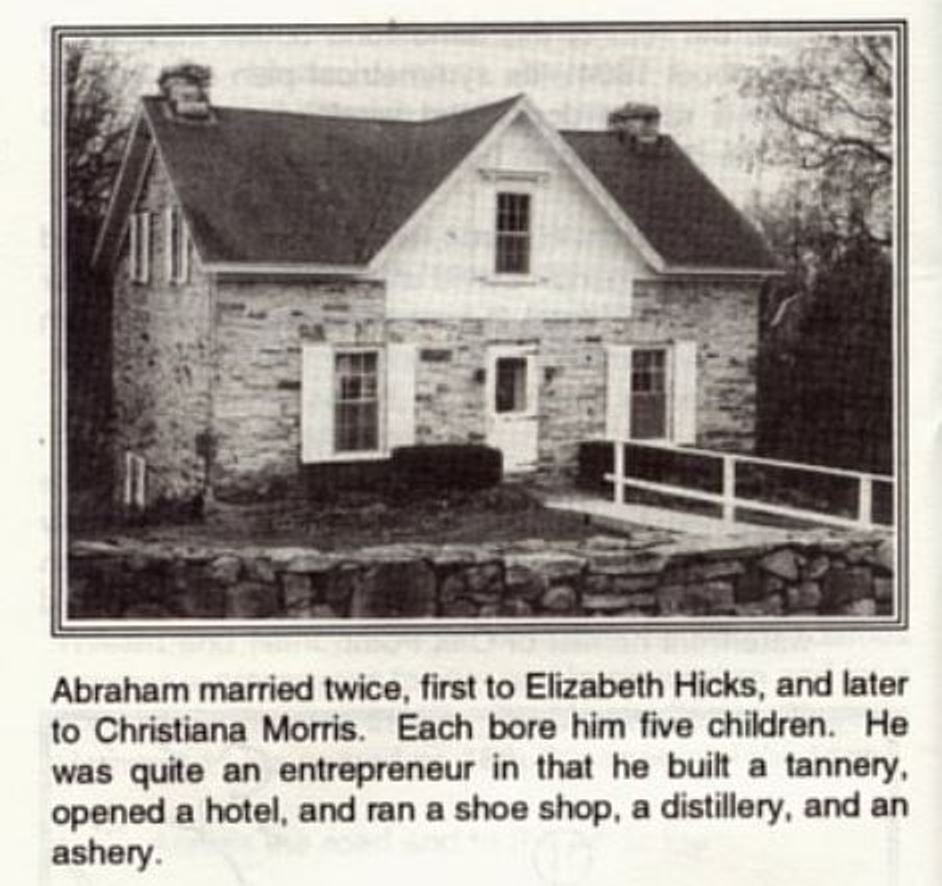
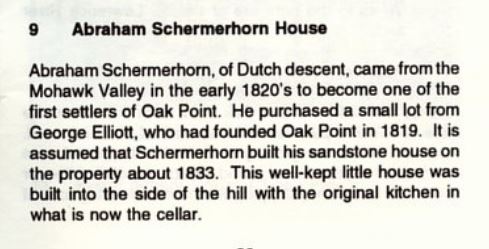
Over 133 years ago George Elliott began settlement of Oak Point, today a picturesque summer resort colon on the St. Lawrence river a few miles south of Ogdensburg, where a Mr Cowan opened a small grocery in 1824.
The following year a wharf was built on the island located a few rods from the main shore, a bridge was constructed between the two and was rebuilt in 1838 being considerably enlarged and reconstructed in 1892-3. The island became a scheduled port for steamboats discharging lumber and other products and taking on firewood for their fuel. The port became such a thriving community that a distillery was erected, and in 1840 a postoffice and customs house was established, for Canada is just across the river.
Early settlers after George Elliott were Abraham Schermerhorn, Earl Atwood and Asa Mather. On November 30 1819 Susannah Kearney sold 50 acres of Oak Point land in the town of Hammond to George Elliott, who sold off a small lot to Earl Atwood and Asa Mather June 28 1822. On June 28 1831 Mather conveyed a half interest to Abraham Schermerhorn who, after other transactions involving the other half, bought it of Hiram Morse February 28 1833. A quarter acre west of the distillery had been previously sold to Hiram Pierce by Atwood, and upon it was an ashery, title to which finally rested with William Bacon in 1831. If Schermerhorn acquired the ashery lot the record does not show.
On August 30 1822 George Elliott sold the remainder of the original 50 acres to Jacob Elliott, who transferred to Richard Elliott who, sold off a village lot to Schermerhorn on November 12 1825 for $35. It is assumed that Abraham Schermerhorn built his native grey sandstone house shown above about 1833.
This assumption was reached by Mrs Minerva M Fuller, Utica, who died last May 20 aged 85 because her mother, the late Mrs James (Mary Stratton) Thrasher who was born in 1825 recalled, as a young girl, having seen the house under construction. The title record of the property is complicated by a labyrinth of confusion of transfers.
Mrs Fuller further related that her parents purchased and moved into the house in the early 1850's. There is a deed of .61 of an acre from Abraham Schermerhorn to James Thrasher, father of Mrs Fuller, date March 1 1854. James Thrasher died October 9 1867 leaving a widow, Mary Ann Thrasher, and eight children, one of whom was Mrs Fuller. Mrs Mary Ann Thrasher died February 1 1902. This house and land passed out of the Thrasher estate when Frank MacGregor bought it at tax sale November 7 1934 and sold it to Katherine B Dodds, a member of the Thrasher family May 21 1935 who died giving Mrs Fuller a life-use of the place and then to Mrs Jean Dodds Given. The latter acquired full title from Mrs Fuller and disposed of it to Menzo H and Miriam J Preston, now of Waterbury, Connecticut, November 27 1948 Mrs Fuller quitclaiming her interest October 14 1949.
James Thrasher was a skilled cabinetmaker and five of his children were
born in this stone house, which sits in the side of a hill on the road
leading into Oak Point, where the Presbyterians have purchased the old
hotel and converted it into a retreat and summer encampment. Since they
bought it Mr and Mrs Preston have rehabilitated the property, redecorating
the interior, refinishing
the fine old pine floors, and equipping with water system and modern oil-heating
plant. They have filled it with beautiful antiques, mostly from their
own two families, have built an excellent stone wall with gates in front,
and have made much progress in their plan to landscape the grounds, providing
a beautiful terrace and lawn at the rear.
Mrs Preston is the former Miriam Janet Felshaw, daughter of the late
Attorney Fred K Felshaw and Mrs Felshaw of Anwerp. In 1934 she was graduated
from Syracuse university where she was a member of Ihe Boar's Head Honorary
Dramatic society. After her graduation she became English and dramatic
instructor on the faculty of the Antwerp High school and while there wrote
and staged a seven-act play, "Mademoiselle Caroline," based
on the North Country life of Caroline Bonaparte, daughter of King Joseph
Bonaparte, and wife of Colonel Zebulon Howell Benton.
On June 29 1939 she was married to Menzo Herbert Preston, then of Liberty, NY, and district representative of the Socony-Vacuum Oil company. Until recently they have been residing at Storrs, Connecticut, but now have transferred to Waterbury, Connecticut
A combination of Cape Cod and Georgian this handsome white frame house on the state road between Watertown and Philadelphia near the outskirts of the latter community never fails to attract the attention of the tourist. That it was erected more than 113 years ago the record indicates, for an August 29 1839 Jonathan and Elizabeth Rogers sold the slightly more than 435 acres upon which it stands to Kent Jarvis of Lowville for $9,000 Jarvis having been a partner of Oliver Child, prominent Philadelphia Quaker and onetime tutor of Vincent LeRay's son, James Marquis de St. Paul, in a sawmill operation in that locality.
There is more than a slim possibility, however, that the house may have been built by Thomas Townsend, a leading Philadelphia pioneer settler, in the neighborhood of 140 years ago, which would make it one of the oldest dwellings in Jefferson County. Underlying this supposition is the county record showing that on November 26 1808 James Donatianus LeRay de Chaumont and wife, Grace, sold the 435 acres, one road and 38 perches of land to Thomas Townsend for $1,914.74 and then on June 13 1820 Thomas and Elizabeth Townsend disposed of it to Thomas Bones for $3,100. The property was then in the town of LeRay, but on the erection of Philadelphia township April 3 1821 it became a part of the latter.
To satisfy a mortgage held by Vincent LeRay against James, Thomas, William, Rowland, Lyle and Ann Jane Bones and Harry W Marshall the tract was sold October 31 1834 by Master in Chancery John W Tamblin to Isaac H Bronson, Watertown. Bronson disposed of it to Lyle Bones November 11 of the same year. Jonathan Rogers later purchased it and August 29 1839 sold it to Kent Jarvis. On May 1 1840 Kent and Euretta M Jarvis conveyed to Stephen Leonard, who sold it the ensuing August 18 to William Allis, and June 14 1850 William and Elizabeth Allis sold off 71 1/2 acres where this house is to their son, Charles, who retained it until February 1 1888 and then disposed of it to Samuel O Isdell of Wilson, NY, for $3,550. On January 13 1896 Wilson and wife sold it to John G Swind, town of Philadelphia. Swind and wife deeded it to Perry E Wood of the same town on October 31 1903 for $4,375 Wood having on January 2 1895 bought from Ida E Clark of Wilna an adjoining 59.68 acres which had been part of the original 435-acre tract.
Mr Wood died in 1924 giving his widow, Lillian, a lifeuse of his residuary estate, which afterward was to go to his children, but on August 4 1927 they, being Leila Wood Halstead, Ruth Wood Jones and Hazel Wood, deeded their interest back to their mother, who sold the farm June 24 1929 to William B and Flora A Bradley of Rutland. On April 10 1934 the Bradleys sold it to John Cand Addie E McLeod, the present owners, prominent in the life of Philadelphia. For the past several years Mr McLeod has been justice of the peace of the township of Philadelphia, is president of the Philadelphia Milk Producers Cooperative Association, Inc, was district deputy grand master of the Jefferson- Lewis Masonic district in 1931-2 and is a past master of Philadelphia Lodge 916 F & A M
Longest to own this house was the Allis family and, in his history of the county, Hamilton Child States that William Allis located "on the old Bones homestead" in the town of Philadelphia in 1840 which ties in with the above record. William Allis, born in Halifax, Massachusetts, in 1785 first married Betsey (Elizabeth) Barber. Their daughter, Sophia, married William Bennett. Charles who acquired this house in 1850 was born in 1819 and died March 16 1908. It is of interest to note that Thomas Townsend, first owner of this farm was one of the group of Buck's county Pennsylvania Quakers that contracted with LeRay February 16 1804 to buy 7,040 acres in the present Philadelphia and that Cadwallader Child and Mordecai Tayjor also of the group came the following May to explore it.
Cadwallader Child, a surveyor and agent of LeRay, surveyed the first road in the township March 3 1823. He was descended from Henry Child, friend of William Penn, who in 1682 came to Pennsylvania to establish the Child family that sent this line into northern New York. Oliver Child, who was born February 16 1807 and died February 28 1878 was son of Cadwallader.
First their settlement was known as Elizabeth town until the survey of February 20 1810. After that it became Friends Settlement and finally Quaker Settlement until the erection of the township, when the name Philadelphia was chosen because so many of the settlers had come from the Philadelphia, Pennsylvania, region. The first town meeting was held at Harvey Hamblin's house March 5 1822. Thomas Bones was named an assessor, William Bones collector and constable, James Bones school commissioner and inspector, and John Townsend a highway commissioner. The Townsends came at the beginning of 1805 and John Townsend and Cadwallader Child had the first crops of wheat that year. Child built a block house and sold it to Townsend. On February 1 1805 John and Thomas Townsend were named trustees of the central lot in the tract bought from LeRay. All of these names are identified with the ownership of this present McLeod farm property, and in the Allis family it should be noted that John Allis was supervisor of the town 1859-1861.
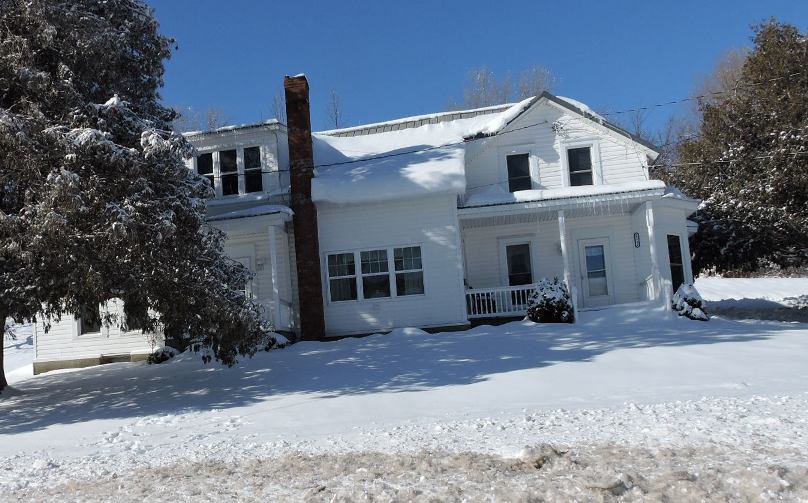
For 131 years until Robert A and Jessie G Parkinson, city, sold it to E Harvey and Korleen F Eddy, Black River, on May 21 1945 this farm on the picturesque Rutland Hollow road known as "Lovers' Lane" in the horse-and-buggy days, was owned by the Parkinson family, one of the oldest pioneer families in Jefferson County.
It was established by William Parkinson, a Vermonter born in 1747 who migrated first to Schoharie county, and then came on in 1804 to settle on the "Hollow" road. In Vermont he had married Elizabeth, widow of Peter Poor who had been killed by the Indians in Maine at an early date. In Rutland he engaged in farming and raised a family of seven children, Esther, Susannah, Reuben, Robert, Moses, Asa and William and died in January, 1826 his widow surviving until 1842.
The main parcel of this farm, 135 acres, was purchased by William Parkinson Sr, from Landowner Isaac Bronson of Fairfield, Connecticut, for $820 on April 18 1814 and on April 26 1816 he bought an adjoining 12.11 acres from Asaph and Mary Carpenter for $150. In his will, executed December 26 1825 he gave the farm and most of his personal property equally to two of his sons, Asa and William. To Reuben, Esther, Moses and Susannah he bequeathed each $1 while he gave his widow his beds, bedding and household furnishing, requesting his sons Asa and William to provide for her.
On March 24 1858 William Parkinson Jr sold his half interest in the farm to his brother Asa, who had acquired 32.17 acres from his brother-in-law Reuben Scott November 30 1857. 50 acres from Isaac Bronson December 18 1832 and 10.30 acres from Salmon S Stevens September 8 1842. Asa, pious and pillar in the Rutland Presbyterian church, built a cheese factory in 1870 and died intestate May 8 of that year.
Asa's estate went to his widow and two sons, Phineas C, born May 22 1844 and James B, born July 21 1846. Upon the death of Mrs Parkinson the property went to the two sons, who operated the farm and cheese factory as Parkinson Brothers until October 20 1897 when James B Parkinson sold his half interest to Phineas, who carried on until his death. By his will, recorded November 22 1918 he gave his property to his wife requesting that at her death she give seven-eights to their children, Robert A Parkinson and Mabel E Parkinson French, and one-eighth to a granddaughter, Marjorie Smith Doner, foster daughter of Dr H L Smith.
The will of Mrs Phineas C (Ida Hardy) Parkinson, recorded May 22 1928 gave this farm jointly to her two children, Robert A and Mabel E Parkinson French and shortly the latter disposed of her half interest to her brother who, in 1945 sold to Mr and Mrs Eddy, the present owners.
Asa Parkinson, born in Rutland, Vermont, October 19 1793 came to Rutland Hollow with his parents when he was ten. He distinguished himself in the War of 1812 by being a member of the gun crew that fired from the main shore of Sackets Harbor the shot that raked the British ship "Royal George," killing several men, wounding many others, and routing the British forces from their attack on that village. Asa was a member of Captain George White's Rutland company.
In 1825 Asa Parkinson married Margaret Dunlap of Rutland, who died childless in 1837. On June 22 1842 he married Olive Knight of New Hampshire and had two sons, Phineas C, and James B In December, 1869 Phineas was married to Ida Hardy of Rutland. James B Parkinson married Miss Alice Poor of Black River in April, 1901 and she died October 18 1928 while he lived to die in this city June 5 1932 aged 85. Here he served as sexton of St. Paul's church, of the First Church of Christ Scientist, and janitor of the Academy and Flower avenue schools. In 1906 he was superintendent of the Jefferson County Orphan's home. Later he operated a grocery store and at his death was the only real son of the War of 1812 in Watertown and with a record of 64 years was the oldest member of Watertown Lodge, No. 49 F & AM
The last Parkinson to own the farm was Robert Asa Parkinson, 138 Winslow Street, now 75 and retired vice president of the Agricultural Insurance company since December 31,1948.
Mr Parkinson was born on this homestead farm May 13 1877 was educated in the Watertown public schools and Northern Business college, became an examiner for the Agricultural Insurance company in June 1901 was made assistant secretary in 1919 secretary in 1934 and vice president in 1942. Six years later he retired with a service record of 47 1/2 years. On November 11 1904 he was married to Miss Laura Wilson of this city by whom he had one daughter, Muriel, the present Mrs Luke A Burns Jr
Mrs Parkinson died October 17 1918 during the flu epidemic and October
14 1922 he married Miss Jessie A Gillette, his present wife. He is a Republican,
a member of the Masonic fraternity and was a Liberty Loan leader in the
first World War. Mr and Mrs Eddy, the present owners of the old farm,
both attended the Black River schools. They were married at Black River
August 2 1938 Mrs Eddy having been the former Miss Korleen Jeffers, daughter
of Clayton Jeffers of Black River and for ten years prior to her marriage
she was an employe of the Agricultural Insurance
company of this city.
While the farm and its buildings are maintained in excellent condition, the old house has been so much modernized and added to that it has lost its original classic beauty with its fine old doorway, its small-paned windows and its return cornices that featured it long under Parkinson ownership.
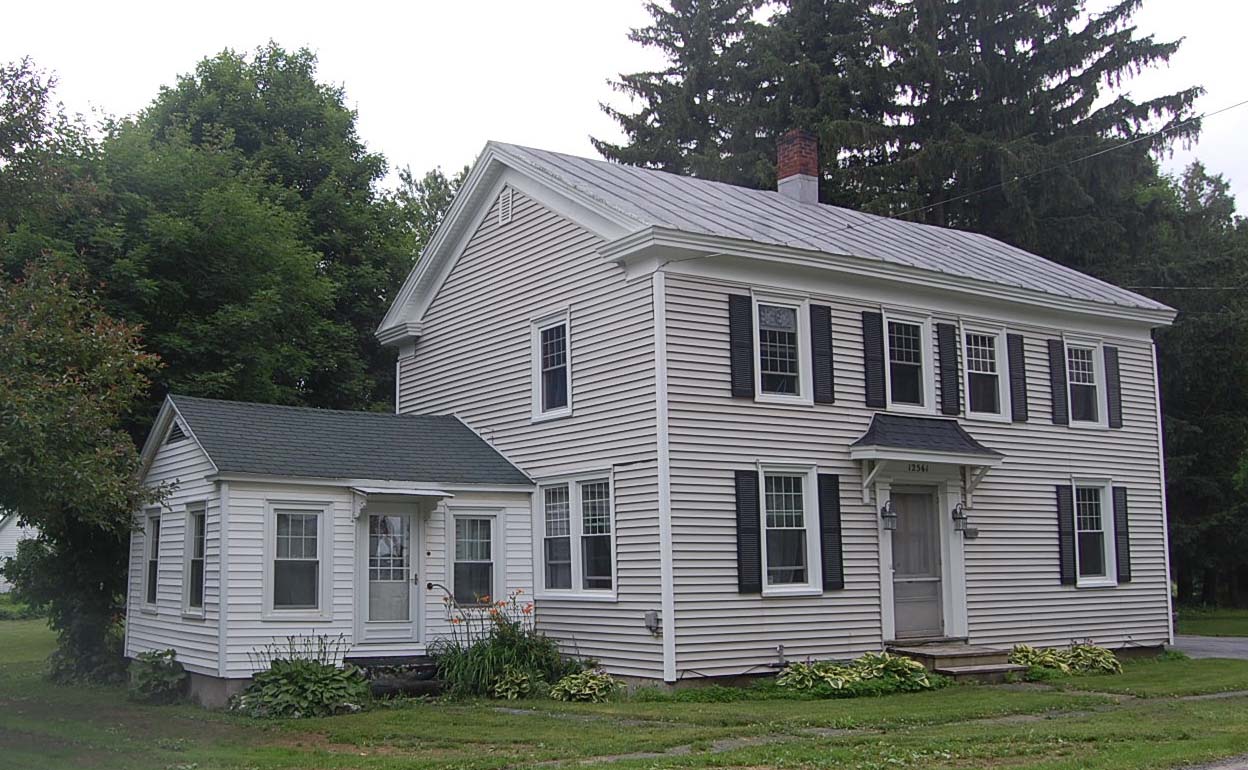
Just off the main street and on the street leading past the Methodist
church up towards Tremaine's Corners in the picturesque village of Rodman
is a large and beautiful white frame house of considerable distinction.
If not built by Benjamin F Hunt 103 years ago, it was probably erected
by Benjamin O Lamson a year or two before that. A half century ago it
was owned and occupied by Dr Herbert L Smith, now of this city, one of
Jefferson County's most remarkable and distinguished physicians. For almost
half a century its title has been in the Bibbins family, and since 1927
its owner has been A Kent Bibbins, Rodman automobile dealer and garage
proprietor who claims to have lived longest on any one spot in that village
of any of today's Rodman residents.
The house is immediately back of where the old Allport-Washburn-Wilson-Brown hotel stood, and upon that hotel site Mr Bibbins has his place of business. Little changed on the exterior, the house has undergone considerable interior alteration and no longer has the fireplaces originally there. It consists of nine rooms and modern conveniences.
On November 14 1846 Benjamin O and Nancy Lamson sold the property to George W Hodges for $500 and the house may have been on the property at that time. George W and Catharine Hodges disposed of it to Benjamin F Hunt and Robert S West on February 18 1848.
Next on November 1 1853 Hunt and West joined by their wives Louisa Lunette and Mariette, sold it to Simeon Clark but to satisfy an execution against Clark it was later sold to Attorney Levi H Brown, city, who, with his wife, Delia M Brown, sold it back to Clark's wife, Julia Ann, February 11 1864. She later died leaving Electa Burnside and Luther G Clark, the former gaining sole title.
From her it passed to William Burnside, a Rodman carriagemaker, and on May 8 1899 he sold it to Dr Herbert L Smith, who resided there about four years, sold it to the late George C Bibbins February 14 1903 and removed to this city. Mr Bibbins, prominent Rodman retired farmer who, for about 20 years was town highway superintendent, was a cousin of the late Dr Charles N Bibbins of this city, died February 10 1927 at 87 and on October 10 of that year Edwin M Bullock, executor of the George C Bibbins estate, conveyed the property to Mr Bibbins' grandson, A Kent Bibbins, the present owner.
On August 25 1920 the latter was married to Alice, daughter of Mr and Mrs Vernon Loveland of Rodman. Mr and Mrs Bibbins have one daughter, Miss Kay Bibbins. Born in the town of Rodman in 1810 Benjamin F Hunt was the son of Simeon and Roxalina Moody Hunt, early pioneers of the town who brought all of their possessions from Vermont by ox team in 1801 and built a cabin at the mouth of the Gulf Stream. Simeon cleared a 100-acre farm, turned his cabin into a tavern, first in the town, and there the first town meeting was held March 5 1805 he becoming a highway commissioner. On the preceding November 4 he had been a delegate to the Denmark convention where Jefferson and Lewis counties were decided upon. Also he was a founder of the Rodman Congregational church, was a musician and fiddler of renown, and the day after the first British-attack alarm at Sackets Harbor, was appointed lieutenant in the Rodman company of Silver Grays. A woods accident incapacitated his bowing arm, his wife died in May 1831 from runaway accident injuries and he died the ensuing fall.
His son, Benjamin F Hunt, Decame a teacher at 16 to 21 and then he took
over his fathers' farm. At 25 he married Sarah, daughter of Daniel Talcott,
an Adams pioneer. She died in 1844. His second wife was Louisa Lunette
Greenleaf who died in 1893 and in October , 1897 he married Julia A,
widow of John A Sherman, owner of the old Washington hall in this city,
Mr Hunt died April 7 1898.
In 1832 he became a merchant in Kingston, Ontario, but the cholera epidemic of 1834 drove him back to Rodman. With Robert S West he engaged there in business. In 1857 he removed to Rochester as Canadian agent of Briggs Brothers, seedsmen, but in 1848-9 had been Rodman supervisor. With his son, Fred S Hunt, he engaged in business in Bridgeport, Connecticut, in 1873 and retired in 1894 returning to this county.
At 89 Dr Herbert L Smith, owner of this house a half century ago, is Jefferson County's oldest physician in active practice, having a record of nearly 65 years in his profession. For the past 18 years he has also been the town of Watertown's health officer. From 1919 to the end of 1925 he was county physician and superintendent of the Jefferson County sanatorium. From January 1 1910 to January 1 1916 he was county coroner, then an then an elective officer.
On August 26 1863; he was born in Tylerville, son of the late George W and Jeanette Oakes Smith. George W Smith, prominent Rutland farmer and supervisor of that town from 1876 to 1879 was the son of Hezekiah Smith who had come to Tylerville from Salisbury, NY, in 1834. Through his mother, Jeanette Oakes Smith, daughter of William Oakes, another early Rutland citizen, Dr Smith is descended from Seth Oak of Massachusetts who served at the Lexington alarm of Paul Revere fame. Also he is descended from Jonathan Fairbanks, whose house at Dedham, Massachusetts, is now the oldest frame house in use in the country.
Dr Smith received his early education in the Tylerville school and Antwerp's Ives seminary. Then he studied medicine with the late Dr J H Tamblin of Tylerville and Copenhagen after having worked in the S Felt drug store in this city and in a drug store in Detroit, Michigan From the Tamblin office he went to the medical college of the University of the City of New York, but was compelled to quit on account of his health. Later he completed his course at the University of Buffalo medical college, received his diploma February 28 1888 established practice in Lorraine March 1 removed to Rodman after a year, and remained there until he came to this city.
To meet the demands of his practice in the Rodman section he maintained a stable of 15 horses, and made a reputation for his success in treating pneumonia in those pre-penicillin davs. He is one of the oldest members of the Jefferson County Medical society, the New York State Medical society and the American Medical society. Now in his 90th year he is still going strong and lives with Mrs Smith, the former Miss Bertha A Rogers, a happy life at 725 South Massey Street.
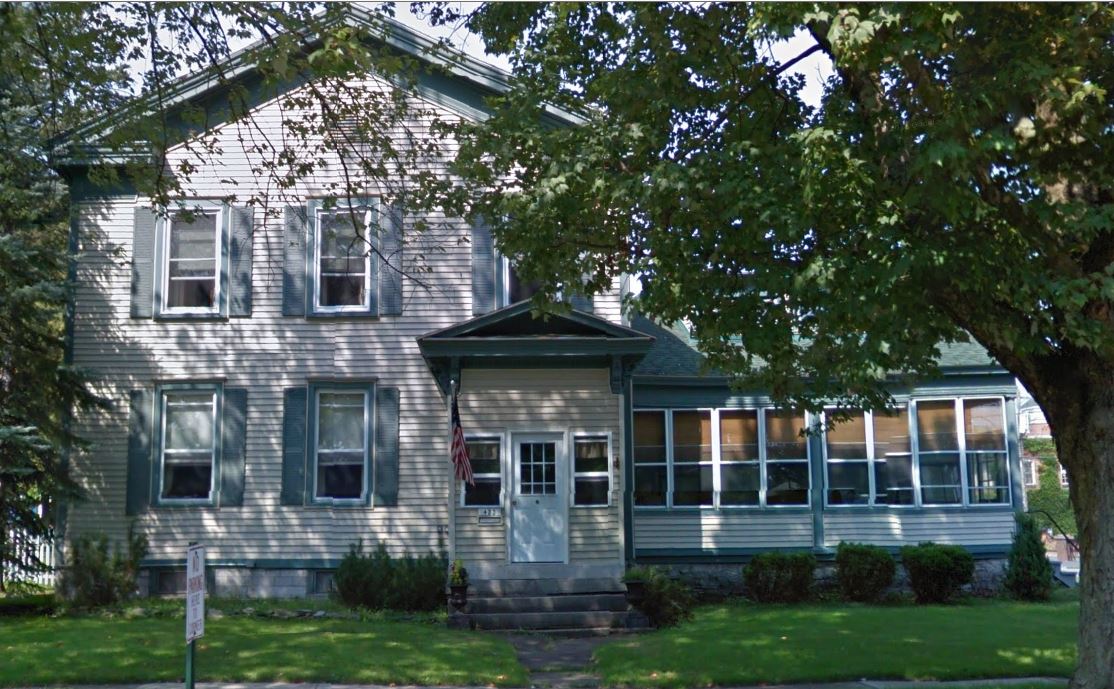
One of the most important figures in the handling of vast northern New
York empire of James D LeRay de Chaumont and his son, Vincent LeRay de
Chaumont, was Patrick Somerville Stewart. For half a century he was intimately
associated with them and for the last 30 years of thattime he was attorney
and agent with full control, and power to contract, lease or sell anything
up to a thousand acres. During that 30 years and for the ten years that
ensued up to the time of his death at 84 on November 15 1874 he resided in
Carthage, where he is buried in the old State
street cemetery.
Patrick Somerville Stewart was born in Edinburgh, Scotland, August 4
1790 or 1791. At 14 he shipped as a sailor and came to America. In 1815
he entered the employ of James D LeRay at LeRaysville. Possessed of sagacity,
sound judgments and trustworthiness he gained the complete confidence
of the LeRays.
On May 13 1835 almost twelve years after Vincent LeRay had taken over the northern New York empire for benefit of creditors of his then insolvent father, Mrs Stewart was appointed Vincent's attorney with full powers over the LeRay property both real and personal in northern New York and to dispose of parcels not in excess of 1,000 acres each.
That was the time that Mr Stewart, a man of 45 transferred his headquarters from LeRaysville to Carthage. There he and his family resided in this house now owned by Mrs Fred S (Margaret Jones) Merrill at 423 West street, for many years, and it is likely that the house was built for him by Mr LeRay at the time of his coming, for there is no record to show that Mr Stewart ever had title to it. Vincent LeRay, on the other hand had acquired the entire 1,000 acres of land that is Carthage on July 17,1815. The 1,000 acres had originally been bought about 1798 by Henry Boutin, first to clear land and settle at Long Falls, now Carthage. Boutin made the purchase from the French company, but was drowned a few years later and James D LeRay as administrator of his estate sold the tract to his son, Vincent, at public auction.
Vincent was in Paris at the time he made Mr Stewart his attorney on May
13 1835 and the document of appointment was sworn to before Daniel Brent,
then United States consul at Paris.
That Vincent LeRay had title to this house all through the Stewart occupancy is evidenced by county records, for on July 4 1873 while still residing in Paris and apparently desiring to convey this house at the corner of West and School streets, along with other properties in the area to his second wife, Cornelia Baroness de Gerdy, he deeded it to Mary Frances Stewart of Carthage, who immediately conveyed it the same day to the Baroness. Lawrence J Goodale, son-in-law of Mr Stewart, had nine years before succeeded the latter as LeRay's north country attorney and so acted in this transaction, as he did on January 1 1882 when Cornelia de Gerdy LeRay de Chaumont sold the house to Mrs Martha A Rice of Carthage.
Mrs Rice, joined by her husband, William W Rice, disposed of it to Mrs Diana Branaugh January 19 1885. By her will, recorded June 15 1889 the property went to her husband, Samuel Branaugh, Carthage bank director and business man.
On May 21 1904 John E Strickland as sole surviving executor of the estate of Samuel Branaugh sold this house to Dr Edwin A Simonds, who desided there until his death March 2 1935. Next, on August 13 1948 Miss Ruth Simonds, of Canado Mission, Canado, Arizona, daughter of Dr Simonds, conveyed it to Fred S and Margaret J Merrill and upon the death of Mr Merrill October 10 1950 sole title went to his widow, the present owner and occupant. Standing upon high ground, the big house, which escaped the great fire of October 20 1884 is worthy of some description. Its outer walls are bricked underneath the clapboards. The original ten large rooms, ten feet high on the first floor, contained several fireplaces, some of which with fine old mantels, remain. The nicely molded interior casings with corner blocks are hand-crafted. All doors, including the front door with its huge iron boxlock and massive key, are eight-paneled. In the broad hallway is a graceful staircase with tapered drumstick spindles of black walnut.
In the hallway the staircase is beautifully boxed in small panels of pine. Huge hand-hewn beams frame the 11.5-decade old house, and the high, three-roomed basement is all smoothly plastered.
And distinguished have been the occupants of the house. Patrick Somerville Stewart, whose wife, Mary Jane, was a native of Brest, France and died February 15 1876 at the age of 85 was prominent m village and county affairs as well as in LeRay's business matters. On the June 2 after Vincent LeRay appointed him his attorney, the Count de la Foret of Paris, conferred upon him similar powers concerning northern New York lands. Likewise did Washington Coster, New York landowner on February 25 1835 and, on the same date Francis Depau, New York merchant for whom Depauville is named. Then on June 8 1836 Depau's executors continued the powers. In 1850 Mr Stewart was village president. In 1858 he was Wilna's supervisor. He was a Whig in politics until the Republican party was formed and in religious faith he was a sturdy Methodist. He knew John C Calhoun, General Jacob Brown, Henry Clay, William H Seward, General Grant and Chauncey DePew. He was the father of eight children, of whom Isabella married Lawrence J Goodale.
Mary Jane, born at LeRaysville May 25 1830 married James H Morrow and lived to be 104 dying at her home in Alameda, Calif., August 25 1934. Samuel Branaugh amassed a considerable fortune as an industrialist and business man. Dr Simonds, born at Theresa January 11 1860 practiced his profession 51 years and for 25 years was Carthage health officer. He introduced the use of antitoxin in Carthage. His wife, the former Clara Hughes, was also a physician and practiced with him for some years.
Fred S Merrill, born April 13 1882 at St. Elmo, Colonel , was educated at Carthage schools and Colgate, was a Utica newspaper reporter for several years, and for 40 years a New York Central employee in Cathage and Watetown serving as ticket agent, freight agent and assistant yardmaster at the former, and retired April 30 1950. On September 4 1914 he married Miss Margaret Jones, Sackets Habor, a descendant of the Felts Mills Felt family, who, with two daughters, survives him.
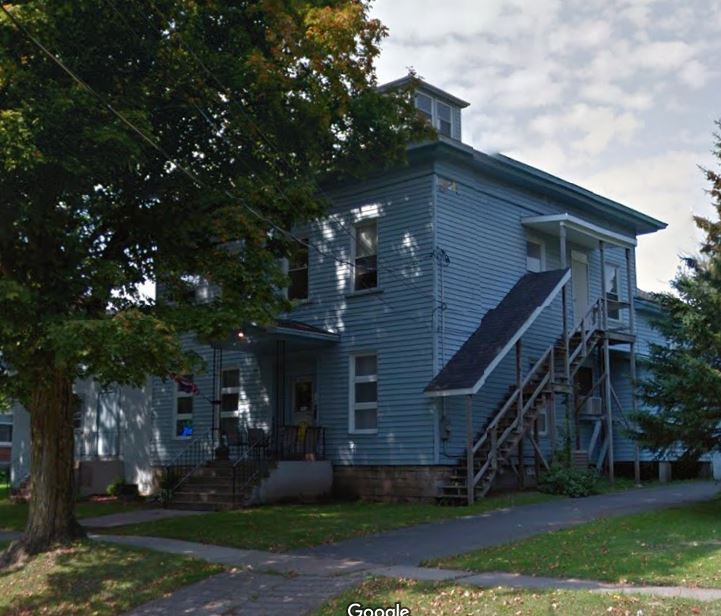
From the time that James LeRay de Chaumont took title to 220,000 acres of North Country lands on January 3 1800 he and his successor son, Vincent, were represented by a chain of highly able and trustworthy men as their agents and attorneys. First settlements on the vast tract were made under the agency of Jacob Brown, the Quaker, who later became the head of the United States army, but in 1799 James LeRay had sent Pierre Joulin, the cure of Chaumont, to America to save his life and Joulin became his first agent from abroad. He was succeeded by Moss Kent who resided at the first LeRay mansion near LeRaysville, and Samuel C Kanady, who was Watertown's first lawyer, served LeRay as attorney for several years.
Later legal details of LeRay's land transactions passed through the law office of Sterling & Bronson in Watertown. Then for 30 years from 1835 to 1865 Patrick Somerville Stewart was both agent and attorney concerning all of the remaining LeRay land. On January 1 1865 Stewart was succeeded by his son-in-law, Lawrence J Goodale who served almost to the time of his death on August 1 1913 there being on record a deed dated February 27 1912 showing that he was the attorney for Charles LeRay de Chaumont de St. Paul in the sale of LeRay lands to the St. Regis Paper company.
After becoming the LeRay attorney on January 1 1865 Lawrence J Goodale resided at 415 West Street, Carthage, in the house now owned by Bassett-Baxter post No 789 American Legion. This house is next south of that occupied by Patrick Somerville Stewart and between the latter and the LeRay land office erected in 1835. In it Mr Goodale lived until he removed to this city January 1 1895 but after that he also continued attorney for the LeRays. No house shows at this location on the Carthage map of 1864 which leads to the supposition that Vincent LeRay had it built shortly thereafter for Mr Goodale. At some time it came into Mr Goodale's hands the record indicates, but when, it does not show. On October 31 1899 Goodale sold it to John H and Anna Carney, Carthage. From Mr Carney the property was inherited by his wife and on February 15 1946 her estate sold it to Bassett-Baxter post of the American Legion.
Born in Watertown February 20 1816 Lawrence Joseph Goodale was the son of Joseph Goodale, a native of Temple, New Hampshire, and Agnes Bush, native of Enfield, Massachusetts. He was descended from Robert Goodell who left England August 30 1634 and settled in Salem, Massachusetts. Lieutenant Ezekiel Goodale, grandfather of Lawrence J Goodale, was a founder of Temple, New Hampshire, marched to Ticonderoga with the First Division of Colonials in April 1777 was in several engagements against Burgoyne and later served in Pennsylvania. In 1824 he died in Ellisburg.
His son, Joseph, born at Temple August 20 1780 came to Watertown in 1815 operated a local drug store nearly 20 years, built a brick block below the Kirby hotel on Court Street, devoted his attention to his Pamelia farm in his later years and died June 29 1859. Lawrence J Goodale was born in the Edmondston house about where the west end of the present Hotel Woodruff begins. He prepared for college here and at Fishkill Landing, entered Union college as a sophomore in 1835 was graduated a Phi Beta Kappa in 1838 taught school a year and a half, entered the local law offices of Sterling & Bronson, which handled much of Vincent LeRay's business, was admitted to the bar in October 1840 started practice in Carthage, returned to Watertown, in March 1842 to become a partner of Micah Sterling until the latter's death in April 1844 and then entered partnership with Joseph Muilin until 1847. From then until 1852 he practiced alone.
On July 4 1853 he went to New York to engage in the lumber business and in 1856 opened a law office at the corner of Broadway and Fulton Street, practicing until September 20 1864 when he removed to Carthage, where he had married Patrick Somerville Stewart's daughter, Isabella September 1 1841.
Vincent LeRay revoked the attorneyship of Stewart August 8 1864 and appointed Goodale effective January 1 1865. On November 3 1865 Orville. E and Esther E Hunt, owners of Carthage lands appointed him similarly. Patrick Somerville Stewart, who was nearly at the end of his life, made Goodale his attorney March 15 1873 and Frederick and Amelia A Stewart of Mobile, Alabama, had done likewise prior to that. On July 10 1873 Cornelia de Gerdy LeRay de Chaumont, wife of Vincent LeRay also made Goodale her attorney and there were others who placed their trust in him.
For upwards of 47 years Lawrence J Goodale served as attorney and agent of the LeRay family and at the end he had a record of having disposed of most of the LeRay land holdings under his control in northern New York. Mrs Goodale died April 30 1891 willing all of her property to her husband. On August 1 1913 he died, aged 97 survived by three daughters, Mary A, Sara J, and Evelyn, the last of whom passed away only a few years ago.
Throughout his long connection with the LeRays he enjoyed their utmost confidence and trust as well as the trust of the people, for in 1866 he was president of Carthage and in 1868 he was supervisor of Wilna. He became the first president of the Carthage Savings bank October 1 1887 and served until he removed to Watertown January 1 1895.
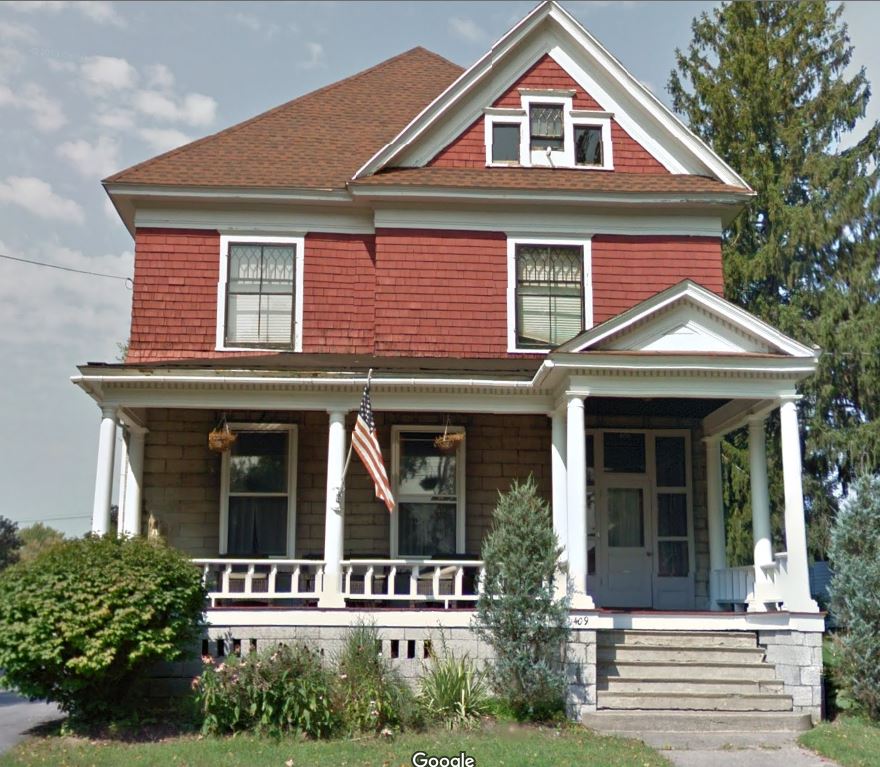
From the time that James D LeRay de Chaumont made his first purchase January 3 1800 of 220,000 acres of North Country lands located mostly in the present Jefferson, Lewis and St. Lawrence counties, he had agents to sell these lands in small parcels to prospective farmers and others, and attorneys to prepare and deliver the deeds.
During all of the approximately 100 years of the active selling of LeRay lands, however, there were but two principal LeRay land offices. The first of these was upon his residential estate from the time he moved into his first mansion near LeRaysville in 1808 and was maintained there into 1835 when his son Vincent transferred it to Carthage and inio a story-and-a-half brick building on West Street. The latter was used until almost the last of the LeRay lands had been sold, and in 1906 it was disposed of by Attorney Lawrence J Goodale, the last LeRay attorney and land agent. After that it was converted into a private residence property, and so it continues today, with hardly any resemblance to its original appearance.
Jacob Brown, founder of Brownville, was likely the first active land agent of the LeRays, although Pierre Joulin, the cure of Chaumont, brought over from France to save him from the Revolutionists' guillotine, is given that credit by some historians. In either event Moss Kent, brother of New York state's Chancellor James Kent, soon took over and carried on until 1816 residing in the LeRay household during that service from the time occupancy was begun in the first LeRay mansion in 1808.
Kent was succeeded in 1816 by Samuel C Kanady, who had been the first lawyer in Watertown, and Kanady held the position until his death in 1835. It was on May 13 of the latter-year that Vincent LeRay appointed, Patrick Somerville Stewart attorney and land agent transferring the office to Carthage. This story-and-a-half brick land office was erected at that time only a little way from Stewart's residence on West Street, and next to the later residence of Lawrence J Goodale. Stewart used this land office until his retirement at the end of 1864. From the time Goodale became attorney-agent on January 1 1865 he used the building until most of the remaining LeRay lands were disposed of.
Ten years ago the late Charles M Brownell wrote the following description of it: "I can yet feel the atmosphere of the old LeRay land office. You entered the small hall through a squeaky old door and then into a lobby, where old maps hung on the walls. A large stove and a wood-box took up much of the room. There was a long, high counter that separated this from an office, where there were high desks and stools to match, and the clerks worked here, making copies by hand, with pen and ink, of survey bills, deeds, mortgages, and other legal papers. My father had his desk, which was a low, flattopped desk, and an arm-chair in the front window. I can see him now, sitting there working with protractor, compasses and rule, making the first drafts of surveys he had made, taking the figures from his field-book."
To a small boy in that age, all this was wonderful. The office smelled musty and of old papers of which there were many. Records of everything in the transfers of property when the country was being divided, and tag ends of the old LeRay properties being sold. Lawrence J Goodale, who had the responsibility of the affairs of the LeRay lands, had his office in the north end of the building next to his garden and residence. It was cool, quaint and beautiful there at that time.
From the LeRays title to the old land office passed to the agent-attorney Lawrence J Goodale. On February 23 1906 he sold it to Charles J Reeder of Carthage. Charles J and Clara R Reeder conveyed it to Lucien C and Eva M Mailer on December 31 1908 and on May 7 1919 they disposed of it to Frank and Hattie Montondo of Carthage, Mr Montondo being a contractor and builder. Shortly thereafter Mr and Mrs Montondo sold to Charles P and Ella T Ryther, the present owners and occupants and now it is numbered 409 West Street.
Remodeled and rebuilt into a modern residence with an entirely new second story and roof, a new front to the lower story and an imposing front verandah, beautiful woodwork in the interior, the building today has little but the first-story brick of the old LeRay land office to identify it with the latter.
Born at Carthage June 17 1878 Charles Ryther, son of the late Charles P and Mary Degroat Ryther, was graduated from the Carthage High school. He retired March 15 1950 after 53 years of service with the Carthage National Exchange bank. For the last 35 years of that service he was assistant cashier and for the preceding 18 years, from the time of his high school graduation he was a clerk. For more than 50 years he was treasurer of Carthage lodge, No. 158 F & A M, and he has had a similar length of service as treasurer of Carthage chapter, No. 259 R A M He is a holder of a 50-year Masonic grand lodge medal.
On August 10 1904 Mr Ryther was married to Miss Ella M Tucker, daughter of Mr and Mrs Nelson Tucker of Grieg, and they have two sons and a daughter, George Ryther of Sharon, Pennsylvania; C Ashley Ryther of Carthage and Mrs Cyrus (Roberta) Dunthorn of Nutley, NJ
From its lofty and sequestered location in a beautiful grove of giant
pines, "The Pines," residence erected in 1826 by Francis Seger,
former Lewis county judge and state senator, complacently glimpses the
turbulent "High" or Lyons falls of the Black River, and the
unique triple ended bridge that spans the joining Moose and Black Rivers.
In its 126 years of existence it has never been out of ownership of the
Lyon family, distinguished for its public service and literary attainments,
for Judge Seger's wife was Laura, eldest daughter of Caleb Lyon Sr, who
started settlement of Lyonsdale in 1819 and Clarence Lyon Fisher, present
owner and occupant of "The Pines," conservationist, banker,
owner of a large Adirondack tract, former assemblyman and author of "A
History of
Lyons Falls," is not only a great-grandson of Caleb Lyon Sr, but
grandson of Reverend Samuel J Fisher, onetime president of Hamilton college
and noted Presbyterian minister.
Mr Fisher is also the grandson of Lyman Basselas Lyon and great nephew of Mrs Laura Lyon Seger. Judge Seger died in 1872 but his widow lived to die January 10 1884 at the age of 80. The mansion then remained unoccupied until the big stone mansion of Lyman B Lyon next below it burned in 1886. After the fire Mrs Mary Lyon Fisher and children, Clarence Lyon Fisher and the present Mrs Florence Fisher Jackson, and, Mrs Florence Lyon Merriam, sister of Mrs Fisher moved in. Later Mrs Merriam and her husband, C Collins Merriam, built "Florissante" on the stone foundations of her father's home, moving into it from "The Pines." Following that Mrs Mary Lyon Fisher bought "The Pines" and occupied it until her death in 1913. Then moved in Clarence Lyon Fisher and wife, the former Miss M Bachel Ingals and their son, the late Captain C Ingals Fisher cotninuing ihe family ownership to the present date.
"The Pines," upon the east side of Black River and a little below the high falls, gazes across this power stream to the paper-mill village of Lyons Falls rising from the west bank. Painted by Frank B Carpenter, the famous American artist who created the famed oil of Lincoln and his cabinet hanging in the capitol at Washington, two fine portraits of Lyman B Lyon and his wife, Mary B Lyon, hang upon the walls of the broad main hall of "The Pines," the spacious interior of which has been modernized but with the original charm unimpaired by Mr Fisher. Water piped from a woodland spring a mile back is one of the several modern conveniences. Beautiful furnishings including a handsome eleven-foot mirror (pier glass), large walnut book-cases and paintings saved from the Lyman B Lyon mansion fire, grace the house.
In the large addition erected in 1932 Mr Fisher as president and manager
of the Fisher Forestry & Bealty corporation, operates and manages
the 43,000 acres of timberlands owned by himself and sister, Mrs Delbert
L Jackson, Brookline, Massachusetts. Finished in paneled oak is the reception
room, upon whose walls hang souvenirs of Mr and Mrs Fisher's foreign
travels, big game trophies of the hunt, medals and other marksmanship
awards of their son who was a member of the United States Olympic Pistol
team in Germany in 1936. The finish of the work office is in wide boards
from mature white pine grown upon the premises. Here also are more trophies
of the hunt, and the atmosphere is in keeping with the conservative methods
employed by Mr Fisher in harvesting
Adirondack timber.
To the rear of the house is a beautiful garden with large iron kettle of pioneer days. Next to the garden is the tenant house and barn, and a small farmland area with pasture for horses. A tennis court near the barn completes the picture, and back of the pasture are the Fisher wood lots and miles of unbroken forest.
Born in the town of Lyonsdale Mr Fisher, whose father, the late William Hubbell Fisher, was a Cincinnati patent attorney, was educated in Holbrook Military academy and was graduated from Hamilton college in 1900. Possessed of the Lyon literary bent he was two years a reporter on The Philadelphia (Pennsylvania) Press and then managed his mother's forest lands. In 1910-11 he was president of Lyons Falls. Member of assembly 1925-1929 inclusive and member of the joint legislative body to study Adirondack reforestation in 1928.
Strong advocate of forest conservation he has been president of the New York State Forestry association and of the Empire State Forest Products association, delegate to the American Forestry association from New York state, a governor of the Adirondack Mountain club and president of the Lyons Falls National bank. His great-grandmother, wife of Caleb Lyon Sr, was Mary, daughter of Major Jean Pierre DuPont who was a nephew and aide to General Montcalm, the last French commander of Quebec. His great uncle was Caleb Lyon Jr, author of the lilting verses "The Thousand Isles" and many other poems, holder of many public offices including the first governorship of the territory of Idaho.
The great-grandfather, Caleb Lyon Sr, born at East Windsor, Connecticut, in 1761 attended Harvard, was of a poetic and literary turn, contributed agricultural articles to many farm journals, went to Walworth, Wayne county, in 1800 manufactured salt at Salina, laid out the village and harbor at Four Mile Creek, managed the Pultney estate, met John Greig of the 74,000-acre Brantingham tract, became his agent and came to Lewis county in 1819 to start settlement of Lyonsdale, acquired large Adirondack land holdings, was elected to the assembly in 1824 and died September 15 1835 advocate of the Erie and Black River canals and close friend of DeWitt Clinton.
Lyman B Lyon, son of Caleb Lyon Sr, and grandfather of Mr Fisher, was born in Walworth in 1806 served as deputy clerk in the assembly 1830-5 was president of the Lewis County bank, was elected to the assembly in 1859 was a vigorous promoter of the Black River canal, instituted the Moose River and Otter Lake tanneries, traveled extensively in foreign lands, and was one of the largest owners of northern New York timberlands.
It was Lyman B Lyon's sister Laura who married Judge Seger, who was admitted to the bar in Albany in 1823 came to Lyonsdale in 1826 and built "The Pines," was state senator 1839-1843 appointed first judge of Lewis county in April 1843 serving until 1856 was secretary to the state constitutional convention in 1846 and died in 1874.
VISIT THIS LINK TO THE LYONS FAMILY HISTORY PAGE
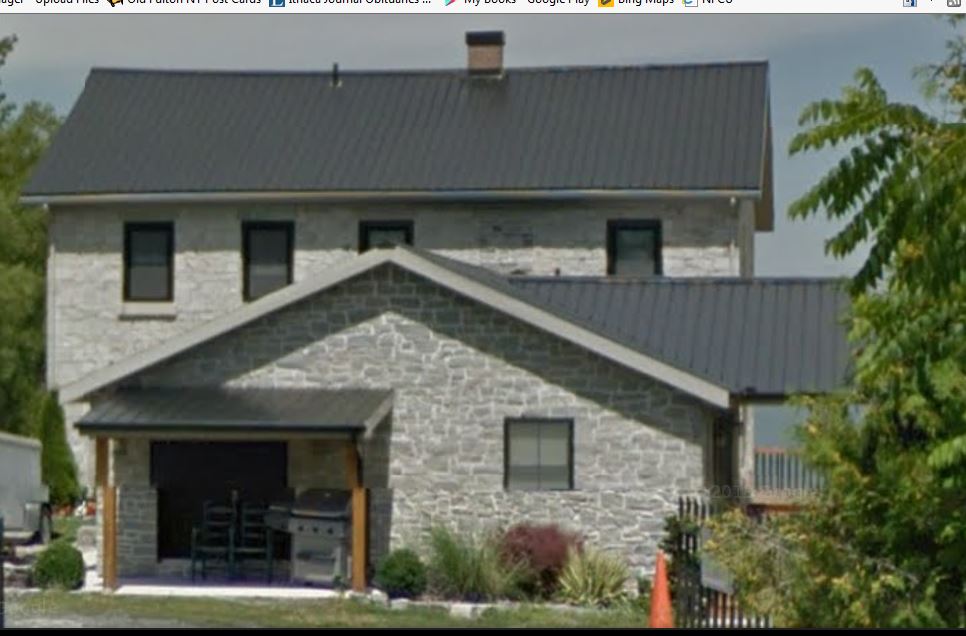
Once considered a household utensil of high inventive genius which took it into the markets of nearly every civilized country, the "Hitchcock Lamp," conceived by a one time Watertown resident and manufactured here for a quarter of a century, has long been nothing but a museum item.
The inventor was Robert Hitchcock, a native of Wolfe island, Ontario, who learned the jeweler's and watchmaker's trade in Watertown, was indentified with the maufacture of the Howard watch and the products of the New Haven Clock company, in New England, conceived the idea of this unique lamp in Bristol, Connecticut, and returned to Watertown in 1872 to organize the Hitchcock Lamp company, build the structure now the office building of Knowlton Brothers Inc, on Factory Street, and there produce these lamps for the market for a quarter of a century, when gas and electric illumination forced them into attics and ultimately into museums.
In the days when people lighted their homes with kerosene lamps, gusts of air often penetrated the glass chimneys and extinguished the flame. Robert Hitchcock devised a plan to obviate this by creating a greater mixture of oxygen into the flame so that it would burn steady and smokeless without the protection of a chimney. This he did by building a clockwork mechanism into the base of the lamp, wound up by an attached key, and actuating a small fan which forced the oxygen into the gas created by the burning oil.
Born October 20 1832 Robert Hitchcock was the son of Archibald Hitchcock, an Englishman, and Mary Hinckley Hitchcock, native of Oneida county of English descent. Settling on Wolfe Island Archibald Hitchcock, a lumberman, established a ferry line to Kingston, Ontario, in 1825 built a 20-room limestone hotel on the north shore of the island opposite Kingston in 1832 the year his son Robert was born, and there resided until his death in 1842. At 16 Robert, in a suit of homemade clothes, was brought by his mother to Watertown to get a job, was hired by Jeweler W H Sigourney, bought a partnership in the business two years later, eventually becoming sole owner, sold an interest to Roswell P Flower in 1859 disposed of his own interest four, years later, associated himself with Watch manufacturer E Howard in Boston, next moved to Bristol, Connecticut, to supervise construction and equipment of a clockmaking plant in partnership with George A Jones of New York as Jones & Hitchcock, there invented the Hitchcock Lamp and returned to Watertown in 1872 to form the Hitchock Lamp company at a captialization of $100,000.
Here he devised the special machinery manufactured in New England to equip his brick factory and Roswell P Flower, later governor, became the principal stockholder. In 1895 the company was reorganized as the Jefferson Brass Works with Governor Flower president and J B Taylor secretary-treasurer. Four years later Hitchcock withdrew, further perfected his lamp, continued its manufacture through the New Haven Clock company, New Haven, Connecticut, and died April 19 1900 at the age of 67. After his death his wife continued her interest in the invention as late as 1905.
The Hitchcock family loomed large in the history and development of Wolfe island, seven miles across, 27 miles long, largest of the Thousand Islands and completely in Dominion territory. There in 1802 Samuel Hitchcock established the first ferry service to Kingston. Mary Hinckley Hitchcock, wife of Archibald, was known as "Aunt Polly," and devoted herself day and night for years nursing and serving the people of the island. Archibald Hitchcock may have developed the famous Wolfe Island strawberry, for in 1841 he built a two masted schooner ferry boat named "Strawberry."
The family was one of high inventive and artistic talents and one of
a collateral line was Lambert Hitchcock, designer and manufacturer of
the beautiful and artistic "Hitchcock Chair" in a factory which
he built at Riverton, Connecticut, in 1826 and operated until bankrupted in
1840 producing in all about 200,000 chairs. In 1946 the abandoned Riverton
factory of Lambert Hitchcock was taken over by John T Kenney, shoe dealer,
and Richard Coombs, building contractor and manufacture of Hitchcock chair
designs resumed. Robert Hitchcock was youngest of four brothers. The others
were Hiram, John and Oliver. Rensselaer A Oakes in his genealogical history
of Jefferson County credits Robert Hitchcock with having been born in
the limestone hotel at the water's edge of Wolfe island's village of Marysville,
named after his mother. His niece, Mrs Louise Hitchcock Ferguson of Kingston,
Ontario, still keen and active at 84 and daughter of Hirma Hitchcock, maintains,
however, that Robert and his three brothers were born in a log cabin on
the brink of the hill just a few steps from where the hotel is. In any
event Robert Hitchcock spent his very earliest years in this hotel, still
the "Hitchcock House."
For 120 years the hotel has been in operation. For the past two years
it has been owned and operated as a summer hosterly by Noble Landry of
Detroit, Michigan During the preceding 41 years it was owned and conducted
by Malcolm MacLaren. Today the structure is as staunch, true and sturdy
as when it was erected by Archibald Hitchcock in 1832 but the beauty of
its fine stonework has been destroyed by a coating of drab paint. A Republican
in politics, a Presbyterian by faith, a member of the Watertown York rite
Masonic bodies, Robert Hitchcock, was a strong family man, pleasant, fluently
conversational and of high principle. On May 15 1855 he married Miss Eveline
Huntington, who was born in 1835 at Huntingtonville, founded in 1804 by
her grandfather,
William Huntington, a Revolutionary veteran of Valley Forge service, who
came from Tolland, Connecticut Her father was Ambrose W Huntington, son
of William, and Huntingtonville farmer, and the wife of Ambrose was Prudence
Tyler, native of Oneida county. Mr and Mrs Robert Hitchcock were the parents
of three daughters, Julia who died at 23, Lizzie who died at 26 and Anna
H who, on September 18 1892 was married to Philip H Winchester who was
several years a resident of this city and division engineer of the St.
Lawrence division of the New York Central railroad, but now retired and
a resident of Syracuse. His first wife, Mrs Anna Hitchcock Winchester,
died in February 1929. Their son is Robert Hitchcock Winchester.
Upon a lateral street across from the Methodist church and close to the business heart of the hamlet of Rodman is this plain but attractive century-old residence of Herman R Cole, Rodman merchant and town supervisor. Its ownership has always been by members of old Rodman families, and while the property was purchased on February 26 1850 by the late original Elam Cooley from Benjamin F and Lunette Hunt who resided in the big house next towards the main street and the Allport hotel, it should really be designated the Charles Denny Moffett house.
Mr Moffett, who had come from Paris Hill, Oneida county but eleven years before to locate in Rodman, purchased the place from Elam and Juliette Cooley on April 1 1856 and resided there until after his retirement from business when, on October 6 1871 he and his wife, Emily H Moffett, disposed of it to Mrs Rosanna Spear, wife of Nathaniel E Spear of this city, for $1,500. Next, on October 21 1873 Mr Spear joined with his wife in conveying the property to Mary Jane Booth of Rodman.
Title remained in the Booth family until November 27 1901 when Ira E and Mary L Booth of Liberty, NY, sold to Jacob H Hughes, Rodman. Mr Hughes retained possession until September 30 1903 when his wife, Dora, joined with him in selling to Monroe G Parker. The Parker family held possession until January 23 1920 when Dr George B Parser and Jane I Parker, city, who had acquired title, transferred it to James J and Anna E Tyler of Rodman and on March 1 1931 Mrs Tyler sold the house and lot to Mrs Irene R Cole, wife of Arthur E Cole, residents of the next upstreet house. Mrs Cole, in turn conveyed it to her son, Herman R Cole, the present owner.
The Cole, Cooley, Moffett, Hughes, Booth and Hunt families were among picturesque Rodman's early and prominent residents. Benjamin Hunt was one of the great early leaders in the hamlet. Asa Cooley was one of the earliest settlers and later members of that family have been prominent in the mercantile and public life of the town. Abel Cole was supervisor in 1814 and a member of the state legislature four years later. Jacob H Hughes, who owned this house a half century ago and died October 21 1949 aged 81 for many years owned and operated a carriage and blacksmith shop in Rodman and was master of the Masonic lodge. His widow now resides in Rochester. Charles Denny Moffett, owner of the premises a decade and a half, was the grandfather of Mrs Louis S Lansing of this city and father of the late John F Moffett, prominent Watertown banker and engineering contractor for many years.
Descended from William Moffett, a Scot who first appears in this country
at Newbury, Connecticut, in 1686 Charles Denny Moffett was born at New
Woodstock, NY, April 27 1813 son of Joseph Moffett, a native of Brimfield,
Massachusetts, who graduated from Dartmouth in 1793 studied law, located at Peacham
and Danville, Vermont, served in the Vermont state legislature and eventually
removed to New Woodstock, NY, where he died April 3 1820. In 1826 Charles
Denny Moffett went to Homer, NY, worked in the harness business until
1828 then went to Chittenango, removed to Paris Hill in 1832 and in 1845
located in Rodman where his brother, William H Moffett had settled ten
years earlier becoming a partner of William R Hanford in the mercantile
business. Charles Denny Moffett, who had married Miss Emily Hayman Knollin,
native of Dartmouth, England, at Chittenango on June 20 1830 set himself
up in the harness and saddlery business in Rodman and retired with a comfortable
fortune in 1870. The next year he and his wife disposed of this residence
in Rodman, where he had been a founder of the first Methodist society
in 1847 and came to Watertown to reside with their son, John, who was
cashier of the Merchants bank here, a bank which had become a state institution
in 1870. Charles D Moffett died here November 28 1880 and his wife on
October 20,1894.
Supervisor Cole, present owner of the house, also is a member of one of the town's most prominent families. Following in the footsteps of his father, Arthur E Cole, long a Rodman merchant and public servant, he served as town clerk several years before the town board appointed him to fill the vacancy on the board of supervisors caused by the resignation of Lloyd G Fassett at the beginning of this year.
Supervisor Cole's father before him had been town clerk for a considerable period of years and then was supervisor from the town for a decade from January 1 1920 to September 1 1930 at which latter time he was appointed deputy county welfare commissioner in charge of old age assistance and served in that capacity 16 years, retiring in 1946. On October 25 1905 Arthur E Cole was married to Miss Irene Railey, daughter of Mr and Mrs Dwight Bailey of Rodman and their children are the present supervisor of the town, and Mrs Lynn (Harriet) Hartley, Copenhagen.
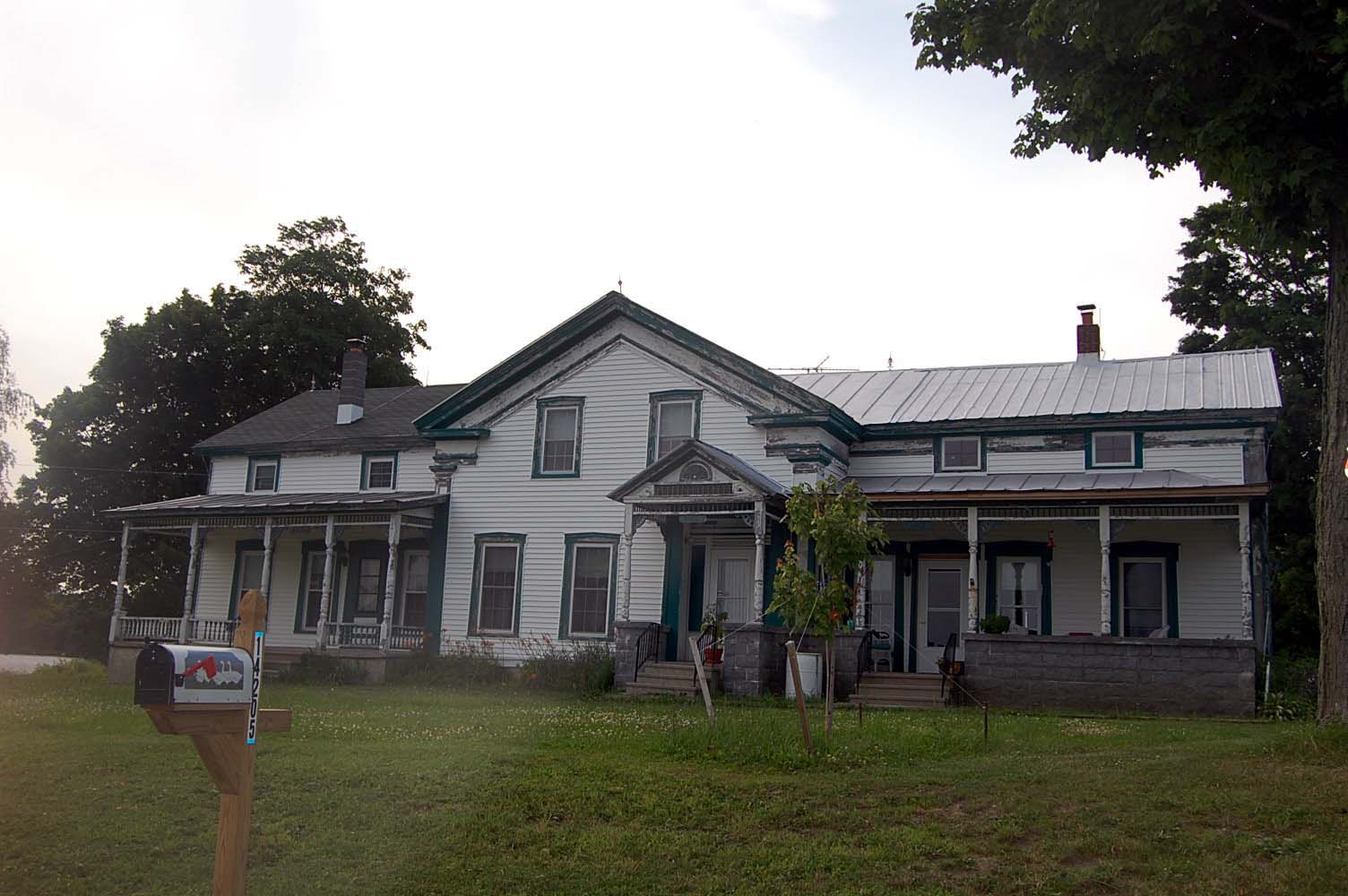
Seven miles from this city on the Dry Hill road is this large farm house, the upright and lower part of the east wing of which are said to have been built in 1816 by Nathaniel Harrington, a pioneer Rodman settler. Modernizations and additions have destroyed its original simple beauty, but it bears the distinction of never having been out of possession of the Harington family in its 136 years and to have been lived in by five generations of Harringtons. With its 255 acres and herd of 60 thoroughbred Holstein cattle it is now owned by Mr and Mrs Frank E Harrington and occupied by them and their son, Hollis Edwin Harrington. The family is descended from one of two Harrington brothers who came over on the Mayflower in 1620.
Born at Clarendon, Vermont, March 14 1785 son of Caleb and Sally Perry Harrington, Nathaniel Harrington used to come to hunt and fish in the wilderness of Jefferson County early in the last century. As a result, in 1806 he selected the section in which he wanted to settle down, served in the War of 1812 battle of Sackets Harbor and on February 12 1814 bought from Caleb and Sarah Harrington for $500 the 93-acre and ten rods parcel of land which formed the nucleus of this farm and upon which this house is said to have been built two years later. On May 12 1815 he purchased 74.9 acres from Harison & Hoffman, and on January 28 1819 two parcels of 50 and 35.25 acres plus from Benjamin and Azubah Fassett. In politics he was first-a Democrat, later a Republican and for several years served as county commissioner.
In coming to this section he followed a line of marked trees up from Rome. On July 4 1808 he married Diana, daughter of Eliphalet Edmonds, also a Vermont native who came first to Boonville and then to this county. Mrs Diana Edmonds Harrington died on June 4 1854 and her husband on June 4 1870. Next in line of ownership of the farm was their son, Benjamin Franklin Harrington born May 18 1827 who became a good farmer with a musical bent, teaching music several years and leading the choir of the First Baptist church in Adams 40 years. On January 22 1852 he married Miss Jennette A Sweet. His death occurred June 3 1920 and the third Harrington then to come into possession of the farm was his son, Ellano.
Ellano, son of Benjamin F and Jennette Sweet Harrington, was born January 15 1855 and died on March 26 1923 but on October 16 1920 he and his wife, Susan P Harrington conveyed the homestead farm to their son and aughter-in-law, Frank E and Ruth W Bird Harrington, the present owners. Frank E Harrington was born January 31 1894 and in 1916 married Miss Ruth W Bird. They now reside in the west wing of the house, while their son, Hollis Edwin Harrington, occupies the upright and the east wing. The latter, graduate of the Adams Center High school in 1938 served overseas in World War II and December 25 1943 married Miss Helen Elizabeth Morse, daughter of Mr and Mrs Ray C Morse.
The original part of the house is of most sturdy construction, the outer
walls of which are of planks laid one atop another and spiked together.
These planks are six inches wide. The east wing apparently has at some
time been raised to a two-story height. The west wing of six rooms is
of later construction, having been built by the late Ellano F Harrington.
It has bath and wood house. The large fireplace originally in the main
part of the house has been removed, but the old woodwork in that part
is handsomely crafted and still in the upright are a number of Nathaniel
Harrington's antiques including oil portraits of himself and wife, a huge
grandfather clock, a beautiful tall pier glass and a Brussels rug said
to be approximately 100 years old and yet excellent condition.
The Harringtons of the town of Rodman are among the oldest families in
that town and also among the most prosperous. The Caleb Harrington, father
of Nathaniel who built this house, was born March 7 1751 and was the son
of an earlier Nathaniel Harrington, whose wife was Mary. Caleb came from
Connecticut to Rhode Island and then to Clarendon, Vermont.
Caleb's wife was the former Sally Perry and on November 24 1809 he purchased 186.25 acres of land in the town of Rodman from the executors of the William Constable estate for $144.49. Caleb's father, Nathaniel, was born May 15 1726 and was married to a Mary Harrington, who was born October 17 1729.
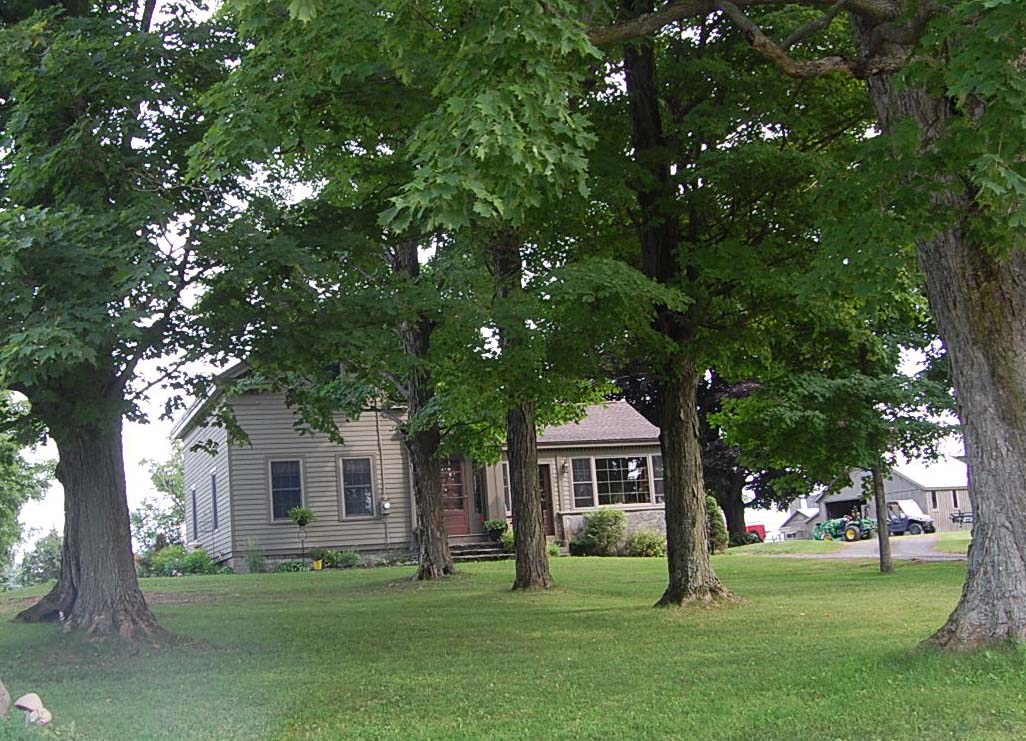
The names of three of the town of Rodman's earliest families, the Parkers, the Fassetts and the Harringtons go into the story of this beautiful old frame house, the vintage of which appears to be of the 1840's and now the home of Mr and Mrs Gordon W Fassett. And it is located upon the Dry Hill road about seven or eight miles from this city in the Harrington-Parker section of the town of Rodman, while most of the early Fassett settlers established themselves a little further northeasterly into the town.
Thickly screened in front by trees the fine, simple architecture of the house with its especially attractive original front door and doorway, its original small-paned windows, its heavy return-cornices with the nicely crafted dentils beneath and its extraordinarily well-kept condition do not fail to catch the eye of the passerby. With the house and outbuildings go a farm of approximately 62 acres.
Back of the front door is a pleasant hallway with an artistically crafted stair rail and here and there within the eight well-arranged rooms are delightful antique pieces among the furnishings. The house is on the opposite side of the road and between the historic farms of Mr Fassett's two uncles, Riley E and Frank E Harrington, of whom Mr Fassett's mother, the late Mrs Anna D Harrington Fassett, was a sister. Mr and Mrs Fassett are comparatively young people, having been married September 1 1932. A graduate of Syracuse university in 1930 and later teacher, Mrs Fassett is the former Marion Elizabeth Wells, daughter of Mr and Mrs Aurie R Wells of Little Falls. A native of the town of Rodman, Mr Fassett, who is engaged in construction work, is the son of George H Fassett Jr, and the late Mrs Anna D Harrington Fassett whose parents were Ellano F and Susan P Nunn Harrington.
The Parker family is tied into the Fassett family through Sarah Parker, great grandmother of Gordon W Fassett and wife of the late Merrill Fassett. And this house and farm, for some time owned and occupied by the late George H Fassett Sr, prominent cattle dealer and son of Merrill and Sarah Parker Fassett, came to Gordon W Fassett largely through the will of his grandfather, George H Fassett Sr, who devised it to his grandsons, of whom Gordon is one.
The coming of Nathaniel Harrington into this area of Rodman in the earliest years of the 19th century has already been related in the articles on the Riley and Frank Harrington houses. John Fassett came into the town of Rodman from New Hampshire in 1803 and at the first town meeting March 5 1805 was elected a fence viewer. Abel and William Parker were also in the town at an exceedingly early date, and the story of this farm goes back to March 21 1807 when Richard Harison, Josiah Ogden Hoffman and Thomas Ludlow Ogden, owners of the town, sold a parcel of 115.25 acres in the section of the great lot where this house is plus 50 adjoining acres in the next great lot to Benjamin Budlong for $496.
On March 21 1815 Budlong, then of Herkimer county, sold the two parcels to William Parker for $1,652.25 and the following December 21 William and Elsie Parker sold 56.86 acres to Abel Parker for $1,100. Abel sold the same parcel to John Parker March 8 1822 but on February 5 1818 William Parker had sold the 115.25 acres and 50-acre parcel to John Parker for $2,000. It seems likely that the house shown herewith is on part of that 115.25-acre tract.
The farm as it now is consists of a 57.15-acre parcel and a smaller parcel of 4 1/2 acres, and this 57.15-acre plot was sold by John W and Julia D Parker to William Fuller for $3,800 on March 1 1864. It seems unlikely that the 58.86-acre parcel and the 57.15-acre parcel are one and the same, although the work of two different surveyors working at different times may account for the discrepancy. In any event John Parker had paid $1,100 for the 56.86 acres on November 26 1824 and $2,000 for the 115.25 and 50 acres on February 5 1818 these prices possibly indicating the existence of the house, which would make it much older than the estimated 1840's.
However, from the time William Fuller purchased the 57.15 acres the record
of the property is clear to date. The Fullers owned the place but a short
time, William Fuller having died not long after purchasing, with the result
that on April 17 1866 his widow, Nancy D Fuller, and minor daughter, Mary
E Fuller, sold to Henry Gordinier for $4,500. Then on March 6 1868 Henry
and Juliette Gordinier who had also acquired the 4.5-acre parcel sold
both of them to George W Wood. George W and Lucinda Wood disposed of the
property on January 13 1897 to Mrs Esther A Glasier of Middletown, VA,
for $3,000. October 1 1901 Mrs Glasier, wife of Charles E Glasier, conveyed
to George H and Carrie Fassett and by his will recorded June 12 1930 Mr
Fassett devised it
equally to his grandchildren, sons of George H Fassett Jr, of which
grandchildren, the present occupant of the house is one.
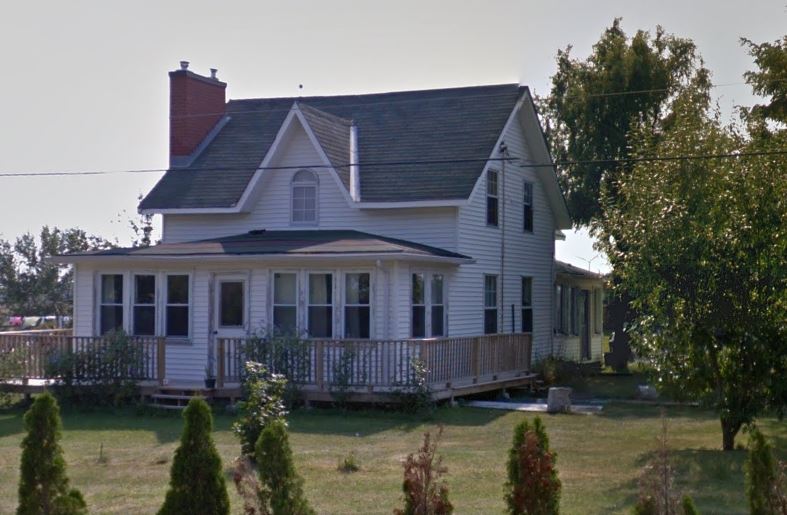
Rich is the history of the North Country and one of the most ancient and colorful spots in this history is Wolfe island, territory of the Province of Ontario, which lies at the foot of Lake Ontario just across the international boundary line directly opposite Cape Vincent. From the time France took title to eastern Canada it was a French possession, but after the defeat of the French by the British it became a British possession in 1759.
Before the coming of the white man it was an important Indian rendezvous.
Later it figured in the French and Indian conflicts, then in the warring
between the French and British and later in the War of 1812 for, with
its 27 miles of length and about eight miles of width it is the largest
of the Thousand Islands. Here Samuel de Champlain is said to have landed
in October, 1615 and a little later on May 13 1675 it was granted by Louis
XIV to the explorer LaSalle, whose attorney deeded it to James Cauchois
in 1685. When he died intestate it was inherited by his daughter Madeleine,
who married one Curotte. From her it passed to her son James Francis Curotte
who, upon becoming a priest, turned it over to his half-brothers Arnable
and Michael. When the British defeated the French it became British property
and not long afterward was acquired jointly by Captain David Alexander
Grant of the English 94th Regiment of Foot and Patrick Langan, a native
of Limerick,
Ireland
In 1781 Captain Grant married Marie Charles Josephe Le Moyne de Longueil,
daughter of the third baron of that name. Dying intestate in March 1806
Grant's interest went to his eldest son, Charles William Grant, fourth
Baron de Longueil, who died in 1848 the Baroness living another 20 years,
and then their daughter, who had married Reverend J A Allen, onetime Church
of England rector on the island took over the Grant interests. Patrick
Langan died in 1813 and his daughters, Julia, Maria and Charlotte, took
his share of the island. It is interesting to note that Grant and Langan's
deed carried the same seigneurial dues that were imposed on LaSalle. These
had never been paid and to forestall forfeiture they petitioned George
IV to take two-sevenths in lieu. This he did, granting one-seventh to
the Church of England and on July 15 1823 deeded half each of the remaining
five-sevenths to the Grants or Longueils and to the Langans.
Limestone quarried on the island in 1844 went into Welland canal locks and in early October of the next year the cornerstone was laid for the old Anglican church construced of similar limestone in a commanding location a half mile up the north shore road from Marysville overlooking the city of Kingston. In the presence of the Reverend Mr Huntington of Oxford, England, the cornerstone of the beautiful Gothic-type Anglican church of a capacity of about 300 was laid by the Archdeacon of Kingston, assisted by Reverend J A Allen and Reverend M V Rodgers. The Baroness de Longueil was present. Three years later Charles William Grant, fourth Baron de Longueil, was buried in the church cemetery.
The entire cost of the church was borne by the Baroness who, in 1865 three years prior to her death, gave to the Church of England the lands upon which the edifice and cemetery stand, to be held by the trustees and their successors in trust for a church where services of the established Church of England and Ireland could be held, reserving to herself and heirs, rent-free, two pews next to the communion rail.
At the time of construction of this church in 1845 the imposing rectory was built a little further upshore on an elevation overlooking the bay and the city of Kingston beyond. This is also of native limestone of semi-Gothic type and remained a rectory until about 25 years ago, when the Grants or de Longueils disposed of it and its 7 1/2-acre site to Dr W H Areson, a New Jersey dentist, who now resides in De Soto, Florida, the present owner.
Drifting winter snows along the road are said to have prompted the sales.
Dr Areson and his family have used the old rectory as a summer home. It
contains a large living-room, large dining room and kitchen downstairs,
four large bedrooms and bathroom upstairs, a beautiful Georgian front
entrance and imposing hallway.
The old rectory is still one of the imposing structures near Marysville,
so named for Mrs Mary Hitchcock, wife of Archibald Hitchcock, who built
the limestone Hitchcock hotel at Marysville's waters-edge. The old Anglican
church continues in use upon this historic island with its 1,200 population,
its famous strawberry culture, its extensive farming and its fine cheese
production.
The island, called Ganounkouesnot or Long Island by the ancient Indians, was later known to the French as Grande Ile. When Lieutenant Governor John Graves Simcoe came to organize the Province of Upper Canada, now Ontario, under the Constitutional act, and proclaimed the districting of the province on July 16 1792 he changed the name of the island to Wolfe in honor of the British general commanding at the historic battle of Quebec. At the same time he denominated this Wolfe Island he named the neighboring islands after other famous British generals, Howe, Gage and Amherst, and even one is named for himself.
Rt 118
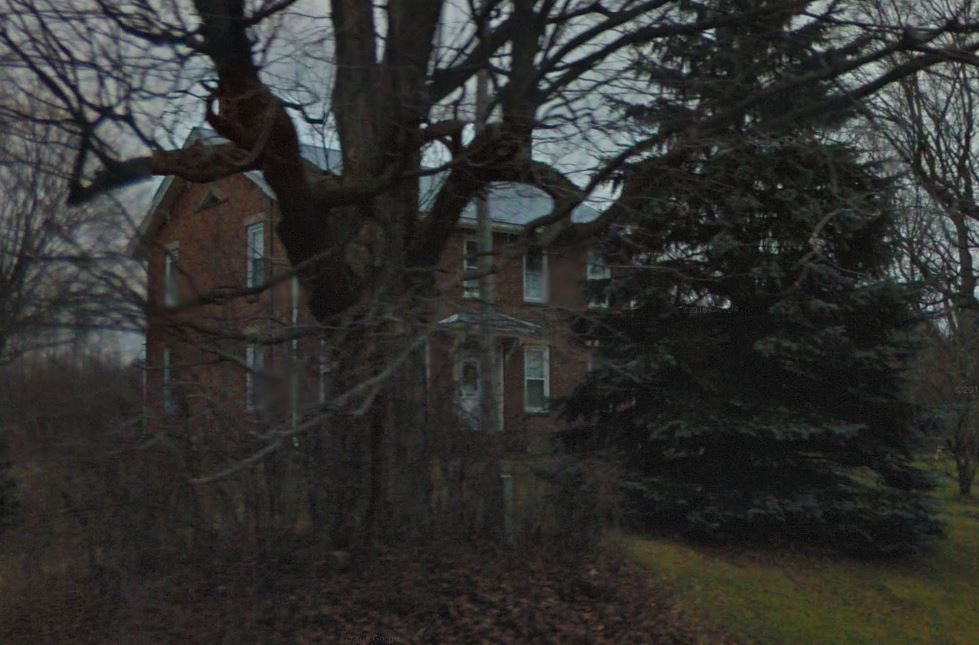
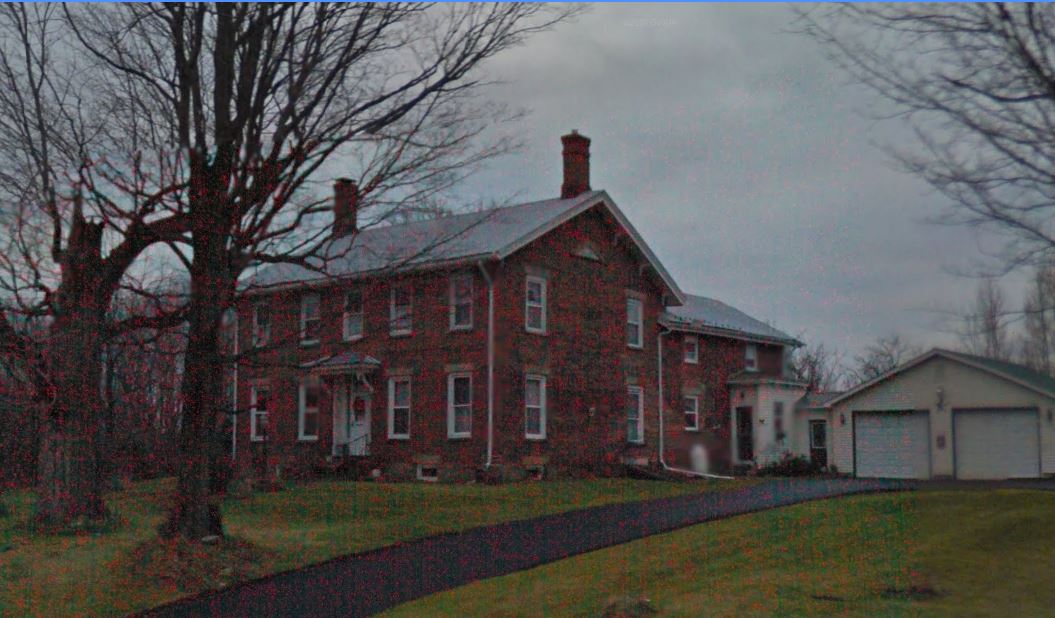
Long has been gone the glamorous atmosphere surrounding this 96-year-old brick mansion in Hopkinton that was originally the home of the wealthy George S Wright, one of that town's most outstanding citizens. Although never out of Wright family ownership, the excellently built house with its slate roofing imported from France, its beautiful mahogany-veneer furniture, services of expensive china and silver, and extensive library, has not been occupied for many years. It was built upon the site of the frame house of his pioneering settler father, Caleb Wright, who came to Hopkinton from Vermont in 1804 worked a few years for Hopkinton's founder, Roswell Hopkins, bought extensive acreage, became Hopkinton's wealthiest citizen and died on November 14 1839.
Caleb Wright was born in Weybridge, Vermont, November 28 1787 son of Ebenezer and Rebecca Staniard Wright. On February 15 1813 Caleb was married to Rosalinda Smith, who was born February 25 1784 in Cheshire, Massachusetts, and died in Hopkinton on August 8 1860.
Caleb and Rosalinda Smith Wright were parents of five children. Catharine married John W Priest. Adaline became the wife of Joseph A Rrush. Caleb Jr, married Helen Chittenden and became Hopkinton's first substantial merchant. Louisa lived less than a year. George S was the youngest of the five. George S Wright was born upon the site of this house May 28 1824 received an excellent education for that era, and October 8 1856 married Harriet M Eastman, daughter of Lee Eastman, member of the prominent Hopkinton Eastman family, the pioneer settler of which was Samuel, who was born in Hopkinton, New Hampshire, in 1769 later removed to Lincoln, Vermont, and from there to Hopkinton, NY, where he took up land February 24 1808. A man of scholarship and many talents, George S Wright held many positions of trust during the 81 years of his life in the town of Hopkinton, settlement of which had been started in 1802 by Roswell Hopkins. Among these was the supervisorship in 1862-3 a post which his brother, Caleb Wright Jr, had filled 1858-9. All of his life George S Wright resided on the homestead farm, where he had built the big, pretentious brick mansion in 1857 the year after his marriage to Harriet Eastman, replacing the earlier frame house of his father.
Of the two children of Mr and Mrs George S Wright, the younger, Miss Mattie was born June 24 1862 and died January 24 1876. The elder was Miss Rosa L, who was born March 21 1859 and died February 13 1915 aged nearly 56 having, upon the death of her father, September 11 1905 inherited his estate including the big mansion and its contents.
And there are many in Hopkinton today who distinctly remember the wealthy Rosa as an ardent horsewoman with a stable of fine horses and a coach house of stunning equipages. Especially do they recall one striking, prancing team made up of "Bess," a pure white, and "Blackberry," a coal black, accoutred in fine harnesses trimmed with gleaming, polished brass and hauling a smart two-seater carriage, with Miss Wright deftly handling the reins.
After the death of her father Miss Wright lived alone in the big house,
except for her three servants, a housekeeper, a cook and a gardener. The
mansion was maintained in a state of magnificence amid fine lawns and
beautiful flower gardens. And when she died February 13 1915 it is said about
Hopkinton that she incorporated a provision in her will that the ownership
of this property must always remain in the Wright name.
The story of the title to the mansion and grounds goes back to January 6 1810 when the pioneer Caleb Wright bought from Alexander Macomb for $500 the 200 acres, of which the mansion site is a part. On November 14 1839 Caleb died intestate and in the partition of his property the 200 acres was set off to his son, George S Wright, by court order dated October 18 1853. Upon the latter's death his extensive estate passed to his daughter, Rosa, and on February 1 1912 she sold off 478 acres to James H Knowlton, retaining for herself this "Country Home" site. Rosa died willing three-fifths of her estate to George A Wright and two-fifths to C Frank Wright, cousins. On May 3 1918 the former conveyed his interest to the latter who, on the following July 22 sold the entire property to Wirt Wright, another cousin of Rosa. Wirt and his family occupied the mansion as a summer home for many years and on March 1 1934 he conveyed to Katherine Wright. Wirt Wright's widow, Mrs Adelaide Wright, an invalid, resides in Chicago.
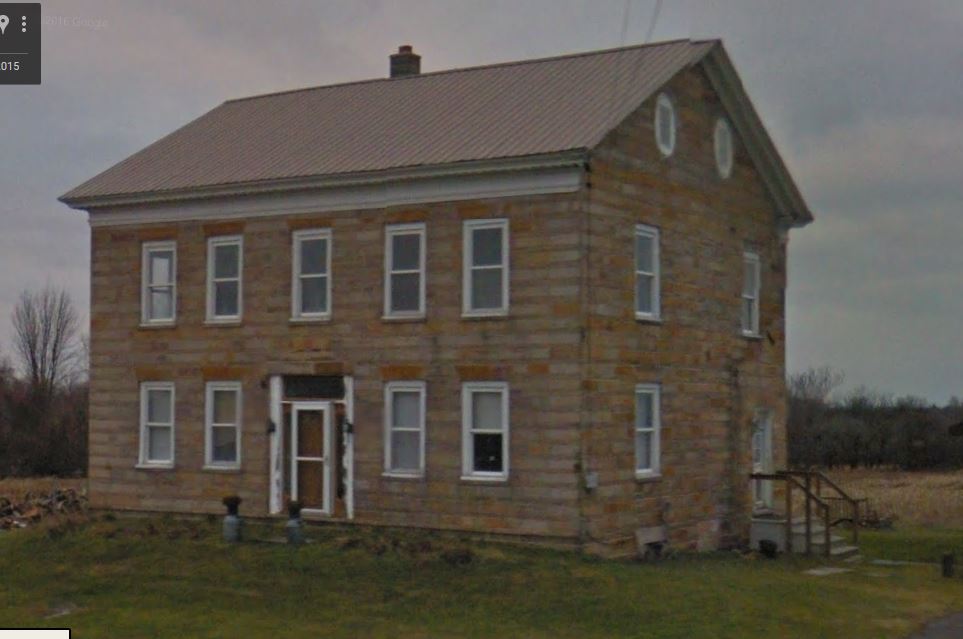
One of the historic landmarks always pointed out to the traveler coming through the town of Hopkinton from the southward is the old Durfey Inn about three miles from Hopkinton village. It was built by Phineas Durfey in 1828 for several decades was a stagecoach stop, and not infrequently the celebrated "Old Grimes" was a guest there.
Built stoutly of yellow native sandstone it has wintered well the rugged weather of the north for 125 years, but long ago it ceased to be a tavern and became a farmhouse with 120 acres of land owned for the past 17 years by Floyd Eakins. Phineas Durfey, a native of Ellington, Connecticut, was one of the pioneer settlers of the town of Hopkinton, records showing that he was there as early as March 18 1805 three years after the coming of Roswell Hopkins, founder of the town. In December 1806 he received $21.31 for chopping seven acres for Hopkins. In 1807 he was one of 44 heads of families, each owning a freehold of at least 100 pounds Sterling qualifying him to vote and records show that in 1814 he had four slaves, a male and female between 18 and 45 and a male and female under 18. His son, Joseph B, born November 26 1811 was the first white child born in the town. In 1821 he had 40 improved acres, 24 cattle, four horses, 38 sheep, 32 yards of homemade woolen cloth and 220 yards of homemade linen. He became one of the town's prominent citizens and officeholders.
Soon after he settled in Hopkinton a road was cut through to Potsdam, and after a time the travel over it warranted him in opening an inn. At first he had three log houses a little east of where he later built this stone tavern in 1828. Phineas Durfey was born March 18 1780 and died May 25 1865. In Bristol, Vermont, he married Ruth Brooks, a native of Charlemont, Massachusetts, who died September 27 1858. They had three children, Harriet, Joseph B, and Maria. In 1811 Phineas was a militia ensign, in 1819 a lieutenant and in 1820-1 a captain. His brother Joseph was supervisor of the town in 1830-2 and 1852-3 and Phineas himself in 1836.
St. Lawrence county records show that he paid Alexander Macomb $300 for
120 acres of land, to which he took title April 27 1809. Eighty acres
of this he sold to Joseph B Durfey on March 2 1846 for $500 and the
remaining 40 acres to Joseph on November 30 1853 for $400. Peter Eakins,
grandfather of the present owner bought the entire 120 acres and tavern
from Joseph B
Durfey December 12 1868 for $4,320 and died December 3 1880 leaving a
life-use to his widow, Eliza. Upon her death the property went to their
children, Samuel, John and Ann Jane Eakins. On February 23 1884 John sold
his one third interest to Alice C Eakins, wife of Samuel.
Samuel Eakins died February 14 1934 giving his widow life-use of his share
and then to their three children, Floyd, Earl S, and Mrs Grace Rosenbarker,
who also inherited their mother's share when she died December 31 1934. Miss
Ann Jane Eakins died March 7 1935 providing a life-use of her share
to her brother Samuel, but he had pre-deceased her, and accordingly under
her will her share then also went to Floyd, Earl S and Grace. On July
11 1935 Floyd purchased the interests of her brother and sister and
became the sole owner of this property. In another house upon the farm
live Floyd Eakins' son, wife and their three children, making five generations
of the Eakins familv to have resided on this farm.
Samuel, father of Floyd Eakins, was born in the town of Lawrence April 1 1849 son of Peter and Eliza Baird Eakins. He was married January 1 1876 to Alice Fisher, daughter of a neighbor in Lawrence, and died at the age of 85. Mrs Alice Fisher Eakins, born July 20 1858 daughter of Alanson and Malicia Hall Fisher, died at the age of 76. Miss Ann Jane Eakins, born October 6 1855 died at the age of 79.
The circular attic windows in the gables constitute an unusual architectural feature of the old stone tavern. Oval and triangular ones are often seen in the north country, but circular ones seldom or never. The stonework of the walls is laid in alternate shades, giving a striped effect.
A central hallway with staircase leads from the front door, and on the ground floor are four rooms and the old bar room, the latter at the southwest end. Originally there was a ballroom occupying the entire front half of the second story, while in the rear half were three bedrooms. All rooms in the house are lathed and plastered and the woodwork is nicely made of pine. At the beginning there were six fireplaces in the house, but only two or three are now usable. The kitchen fireplace with bake-oven was in the basement but is now crumbled to ruin. At the end of the ballroom was also a large fireplace.
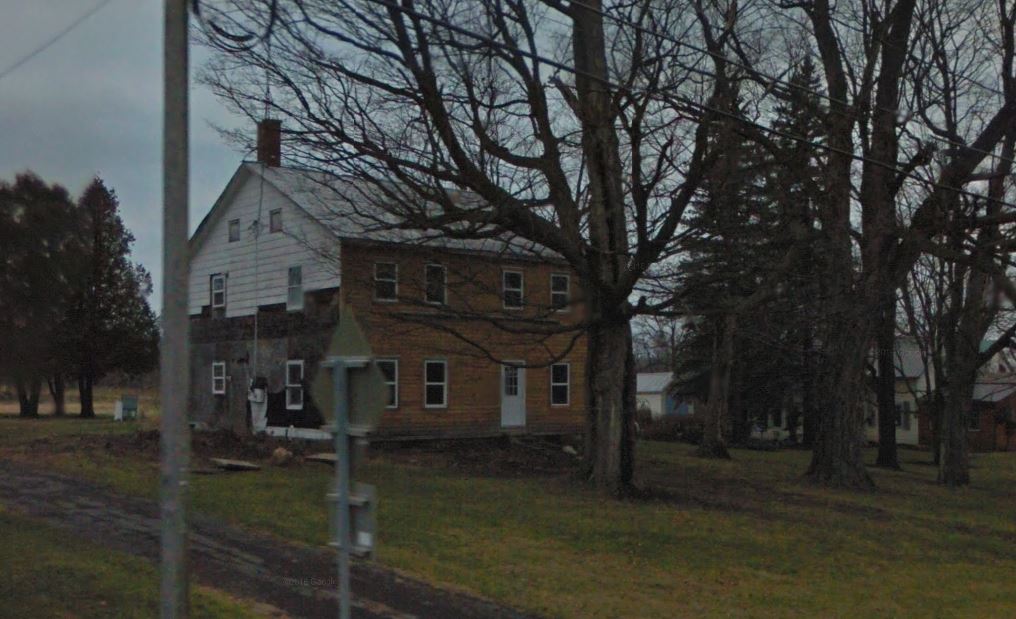
One of the show places of the village of Hopkinton is the beautiful Arlemas
Kent mansion, ownership of which has never been out of the Kent family
in all of its 135 years. It stands in a handsome setting of fine old trees
on the main street opposite the town hall and the village park, its frame
having been raised September 28 1817 and the house having been completed
the following year. Its 14 large, pleasant, high-ceilinged rooms with
artistically crafted doors and woodwork are furnished with many valuable
antique pieces, choice bric-a-brac and family portraits.
A native of Dorset, Vermont, Artemas Kent was a cousin of New York state's famous James Kent, who was born at Phillipstown, Putnam county in July 1763 was chancellor of New York state 1814-1823 president of the New York Historical society in 1828 many years professor of law at Columbia college, author of the famous four-volume Commentaries on the United States Constitution, active in the New York state constitution of 1821 one time supreme court justice and later chief justice.
Artemas Kent was born August 31 1788 in Dorset and died in Hopkinton August 21 1877. He was first married to Sally Wead of Hinesburg, Vermont, December 10 1818 and who died April 21 1842 and secondly he married Rhoda Winslow in 1845. His sisters, Hannah and Huldah were the wives of Thaddeus Laughlin, an early Hopkinton tavern proprietor.
On October 12 1809 Artemas left Dorset and arrived at Hopkinton November 30 via Utica and the Black River. It is said that he bought a tract of land across the road from the Truman Post farm, but soon returned to Dorset and again set out for Hopkinton February 27 1810 with horse, cutter and some effects, reaching Squire Laughlin's in eight days.
Between April 25 and November 1 he cleared 15 acres of his land as well as land for others. Again he went to Dorset, but soon came back, continued cutting trees, taught in a log school house across the road from Caleb Wright's in the West district three months in 1811 and again in the winter of 1812-1813. In the spring of 1813 February 7 he became a partner of Laughlin in the tavern.
On October 9 1815 Artemas Kent bought 1 1/2 acres of land where this house stands from Thaddeus Laughlin and May 1 1820 acquired an adjoining 136 rods of land from Laughlin, who sold him a third adjoining parcel of three eighths of an acre November 9 1849. On January 4 1859 Kent sold off two small parcels to F P Sprague for $70. but had two acres remaining for his own house. He practiced law in the courts, was active in church and a prominent citizen of the town. The electoral census of 1821 shows he then had 24 improved acres, six cattle, one horse, 22 sheep, 22 yards of homemade fulled cloth, 19 yards of woolen and eight yards of linen. The assessment roll of 1850 credits him with 228 acres of land.
His diary in 1812 states the people were alarmed over war and that 32 guns were brought from the Russell arsenal July 16. More feared than the enemy were the party contentions among the home people. In the spring of 1813 Colonel Zebulon Pike's regiment followed by Chandler's brigade passed through Hopkinton en route to Sackets Harbor.
Artemas Kent became a widower a second time June 28 1875 and when he died two years later the mansion, in which six generations of Kents have lived, went to his unmarried daughter, Adeline S Kent, fifth of his ten children, who died May 6,1910. A sister, Ellen. J, was the wife of Edwin C Hinsdale, Detroit lawyer and eight years city treasurer. The three brothers of Adeline were Dr Henry B Kent, a New York physician 35 years and head of the Lying-in hospital, whose wife was Phoebe V Miller; Fred H Kent, Sterling, Illinois, hardware merchant twelve years and ten years a member of the Chicago board of trade, and Charles A Kent, noted Detroit lawyer and 18 years law professor at the University of Michigan.
From Miss Adeline S Kent title to the mansion passed to her brother, Charles A Kent and two sisters, Miss Mary H Kent and Mrs Ellen J Hinsdale.
On July 5 1910 Charles A Kent and wife, Frances E King Kent, Miss Mary H, Kent and Miss Genevieve S Hinsdale, as sole heir of her mother, Ellen J Hinsdale, conveyed the place to Henry B Kent Jr, who was residing in New Brunswick, NJ. He was the son of Dr Henry B and Phoebe Miller Kent, was born May 1,1866 and married Miss Mary Esther Kane February 24 1894. To them was born one child, Virginia P Kent, who eventually became the wife of Milo Beecher.
By deed dated November 7,1917 Mr and Mrs Henry B Kent Jr, transferred their interest in the property to their daughter, Virginia Kent Beecher, to whom was conveyed also the interest of her aunt, Mrs Louis J (Virginia Kent) Magee on December 31 1917. Mrs Beecher gained complete title to the homestead August 18 1939 and on October 17 1944 she transferred it to her daughters, Helen E and Virginia H
Of the three fireplaces in the house only the living room one is kept open and the most valuable piece of furniture in the house is an ornate Atagiere sideboard, which Dr Henry B Kent imported from France and which he had in his New York house many years. There he refused a $3,000 offer for it. The wing of this Hopkinton house was added after the death of Artemas Kent.
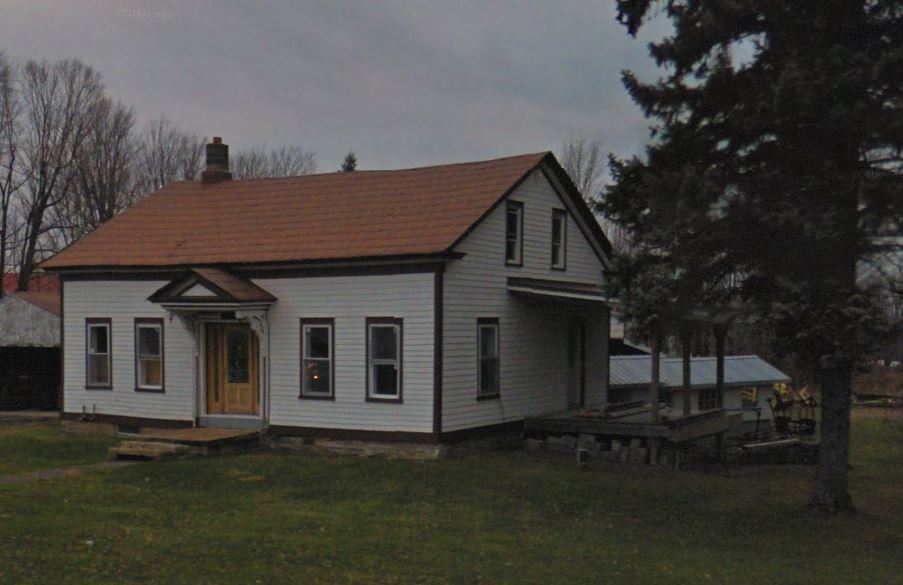
Houses in different regions of the country display characteristics peculiar to the region in which they are located. In Hopkinton and towns of that part of St. Lawrence county a large percentage of the frame houses, like the Ezekiel Jenne home above, expose the clapboards little more than 2 1/2 inches to the weather, probably to provide extra warmth and long preservation.
Undoubtedly of New England origin, Ezekiel Jenne who was born at Jay, Essex county, NY, on April 29 1780 migrated to the town of Hopkinton in June 1830 by means of ox-team, cut a road through the forest from the main Hopkinton-Parishville road, settling about half a mile south of the old turnpike and about two miles from the village of Hopkinton.
First he erected a log cabin which he later replaced with a frame house, and Elisha Risdon in his diary under date of June 21 1848 states "E Jenne has raised a house," meaning that he had set up the frame of the dwelling. The diary shows that on many occasions members of the Jenne family visited at the Risdons. On May 18 1834 "Mrs Risdon and daughters" took tea there, and four days later "Rasey, Jenne, Andrus and Witherell" were there to get their deeds for land.
Ezekiel Jenne's tract was probably the 88.78 acres deeded him May 14 1834 by William Short for $133.17. On April 20 1848 Jenne bought 15 adjoining acres from Asahel Kent for $30 and March 29 1859 sold all but an acre of the latter to George Smith lor $260. On the next December 7 Ezekiel sold two parcels to his son, Asahel, one of 54.20 acres probably being part of the original 88.78-acre tract. Next, on May 21 1866 Ezekiel conveyed to Asahel 43-acre and ten-acre parcels for $1. Asahel, in turn, on October 1 1892 deeded his farm of 89.78 acres plus a lot of 19.80 acres to his own son, Adelbert N Jenne. Adelbert died February 27 1942 but his widow, Mrs Clara Rockwood Jenne still resides on the farm with her son, Lawrence J Jenne and his family.
Lawrence J Jenne, whose wife is the former Miss Hazel Morway and whose daughter, Esther, also resides with them, operates the farm assisted by his two sons, Paul and Gordon, who are married and live nearby. Ezekiel Jenne, the original owner of this house and farm, was married September 11 1811 to Thankful Rasey, by whom he had ten children, nine of whom were born before they settled in the town of Hopkinton, where he died May 26,1870 and his wite October 11,1872. Asahel, who succeeded to the ownership of the farm, was their sixth child and was born April 4 1825. He was married to Priscilla Powers on March 11 1847 always resided in the town of Hopkinton and had six children, the youngest of whom was Adelbert. Adelbert was born on the homestead farm January 16 1867 was married to Miss Clara Rockwood on November 27 1895 and their only child is Lawrence J Jenne, who was born in the homestead May 20 1897 and now operates the farm, which has been under the working of five generations of Jennes.
Like the Jenne family, the Rasey family from which came the wife of Ezekiel
Jenne and the Rockwood family from which came the wife of Adelbert Jenne,
are early Hopkinton families often mentioned by Elisha Risdon in his long
and voluminous diary. The diary states May 5 1833 that A Rasey is better
of his lameness; that between February 12-18 1834 E Jenne took 2 1/2 bushels
of corn to Parishville for Risdon that on October 7 1834 Rasey and his two
children worked for Risdon and were paid six pounds of pork; that Mrs
Jenne and "old Mrs Rasey" were at Risdon's
September 5 1835; that on December 14 Risdon surveyed for Mr Jenne; that Lucina
Jenne, 14 died March 25 1842 and Sophronia Jenne, 13 on February 25 1845 Aaron Jenne, 37,dying November 4 of that year Risdon recounts that a fatal
sickness was prevailing when Lucina died.
That the Jennes and the Rockwoods had prominence in the township is apparent from the fact that Ezekiel Jenne was an overseer of highways in 1842 and Asahel Jenne in 1847 1851 and 1859 while George Rockwood held the same post in 1849. George Rockwood was constable in 1851 H S Rockwood in 1867 and Adelbert Jenne in 1898. In 1854 and 1857 George Rockwood also was town collector.
George Rockwood was the grandfather of the present Mrs Clara Rockwood Jenne. On January 25 1844 George Rockwood married Christiana Sheldon, who was born October 22 1820 daughter of Heman Sheldon, native of Rupert, Vermont, and his wife, Esther Reed Sheldon, born at Pawlet, Vermont.
First of George and Christiana Rockwood's children was Dr Heman Sheldon Rockwood, long a Bombay physician, who served in Co. E, 106th NY. Vols., in the Civil War, was wounded in the battle of the Wilderness and lost his right arm in the battle of Winchester. The second child of George and Christiana Rockwood was Silas, who was born July 24 1846 married Susan Sherman on December 31 1868 and had one child, Clara, born September 7 1872 and who became the wife of Adelbert Jenne. Whether the Hopkinton Jenne family stems from Ephraim Jenne, a native of Wales who emigrated to the American colonies with his brother, Isaac, prior to 1720 has not been presently ascertained. That Isaac Jenne married an English woman, whose Christian name was Milly, and one of their daughters was the Milly Jenne who became the wife of General Zebulon Montgomery Pike, discoverer of Pike's Peak and hero of the War of 1812.
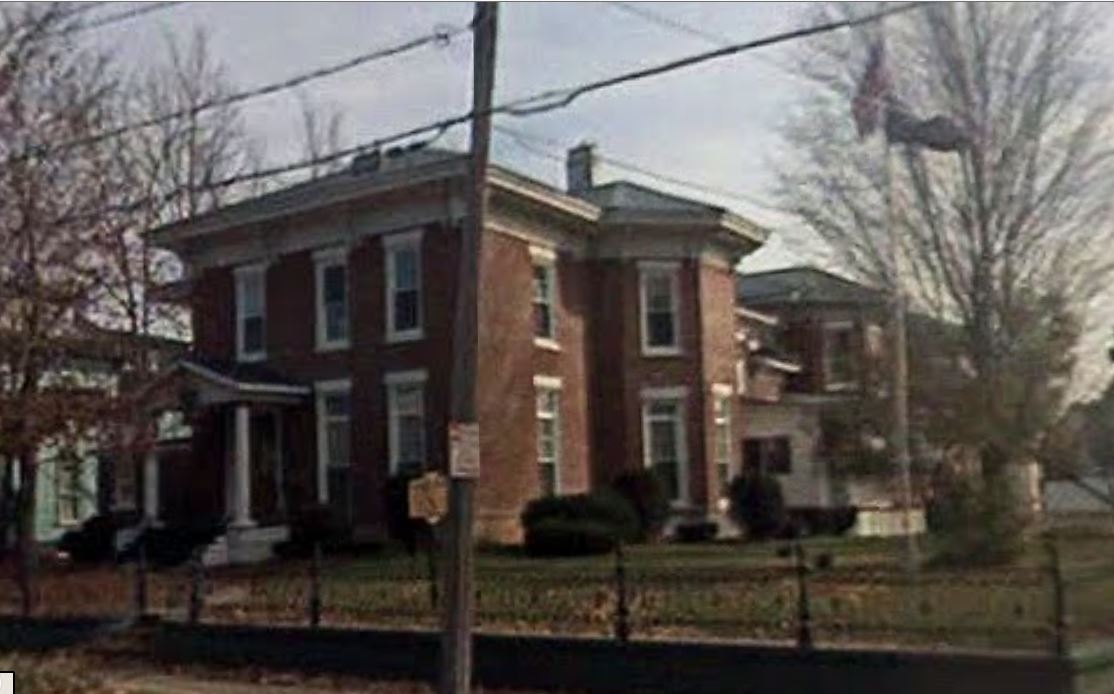
It was in the summer of 1845 that William Almon Wheeler, native of Malone, and only vice president of the United States ever to come out of New York state north of the Mohawk valley, bought the site of this big brick house on Elm Street next to the Arsenal Green park in the village of Malone. The acquisition was from the estate of his father, Almon Wheeler, and it is likely that the house was erected the next year, when he had been appointed district attorney of Franklin county.
As land agent for the Olivers of Maryland, owners of large tracts in the towns of Bombay and Dickinson, Wheeler had received a $5,000 fee for closing out their holdings. This enabled him to build the house, which was his home until his death June 4 1887 taking him through his service as district attorney, assemblyman, state senator, member and president of the New York state constitutional convention of 1867 congressman five terms from the beginning of the Lincoln administration, and vice president under Rutherford B Hayes from 1876 to 1881.
This was the man who had declined the speakership of the New York state
assembly, had been president pro tempore of the state senate, who had
been mentioned for the speakership of the house of representatives, the
New York state governorship and even the presidency of the United States.
The man who had fought James G Blaine, Roscoe Conkling, Alonzo B Cornell,
political corruption in state and nation, the spoils system in state and
national government, was the father of the congressional "Wheeler
Compromise" in 1874 which brought settlement (under protection of
General Sherman's troops) of the Louisiana disputes, was a founder of
the Republican parly in Franklin county in 1855 and first Republican candidate
there to receive a majority at the polls.
Rising from a poor, orphaned chore-boy in homespuns to affluence, William
Almon Wheeler was a man of pleasant personality, high intellectuality,
personal charm and magnetism, sound judgments, utmost honor and integrity,
a stickler for principle, a man, to whom high position came with amazing
speed over the heads of others, a man who might have had gubernatorial
and presidential nomination yet failed to capitalize the opportunity through
uninterest or timidity.
He was a man who knew his goals but not the way, a man who, through a discordant fibre in his character, lacked the aggressiveness to enforce his principles or achieve his aims in state and federal posts, yet who was an autocrat who dominated the party conventions of his home county, nominated his own slates of candidates, there often resorted to unsavory political practices, gave thousands of dollars to churches and missionary societies, but refused to get a postoffice appropriation, failed to sponsor a hospital, library or school expansion, and died in disfavor in his home town.
Born in Malone June 30 1819 son of Almon and Eliza Wheeler, he was a grandson of Zalmon and Hannah Butler Wheeler who had come from Fairfield, Connecticut, to found Fairfield, Vermont, and was descended from Thomas Wheeler, immigrant ancestor who had located at Concord, Massachusetts, in the 1600's and whose son, Sergeant John Wheeler, removed to Fairfield, Connecticut, where he was representative in general court and owned 1,004 acres of land at Grove's Hill
On January 5 1827 Almon Wheeler died, aged 37 and his son, William Almon Wheeler, then seven, had to work to help support his mother and two sisters, and educate himself. He worked his way through Franklin academy, studied two years at the University of Vermont but was compelled to quit because of eye trouble, returned to Malone, studied law with Attorney Asa Hascal, was admitted to the bar, practiced law a dozen years, and entered politics.
At 21 he was town clerk. Later he was town superintendent of schools. In 1846 he was appointed district attorney and elected on a union ticket in 1847. The Whigs elected him assemblyman in 1849. Re-elected the next year he was proposed for speaker but declined and was made floor leader, becoming ways and means chairman. Against opposition he got an act making the Champlain bridge possible for the Northern (Rutland) and Central Vermont railroads. Refusing a third term he became first cashier of the Bank of Malone, and served twelve years.
He became mortgage bondholders trustee of The Northern Railroad in 1853 and virtually managed it 13 years, retiring on condition that a $40,000 station be built in Malone. In 1855 he helped form the Republican party in Franklin county. Was elected state senator in 1857 and chosen president pro tempore his first term, declined re-election and was chosen congressman from Clinton, Essex and Franklin counties in 1860 supported Lincoln's policies and treasures, got deserved promotions for northern New York soldiers and worked to ease their privations. He was delegate and president of the state constitutional convention in 1867. Re-elected to congress from Franklin-St. Lawrence district in 1868 he served until nominated vice president in 1876. Was elected, supported President Hayes through his hectic administration, worked for return of sound monetary system and resumption of specie payment, saw the building of more railroad mileage in a decade than any similar period in the country's history, saw the advent of the machine-age, expansion of mining and cattleraising, the overproduction of commodities necessitating greater world-trade and tariff protection, and ended his public service to return to private life in Malone in 1881 where the atmosphere was unfriendly in his last years. His wife, the former Mary H King, had died March 3 1876 before his vice presidential nomination, and is buried beside him in Malone's Morningside cemetery.
When he died most of his $80,000 estate went in bequests of $500 to $10,000
to Malone churches, and missions, and less than $10,000 personal bequests.
To the Auburn Theological school he gave $3,000. His estate sold his house
August 18 1888 to Albert Andrus for $7,500. On November 17 1913 William
C Andrus, Dixon, Illinois, sold it to William F Creque, charter member
and building committee member of Malone Lodge, 1303 R P O E, then headed
by F R Kirk, for $10,000. On January 23 1914 William F and E Victoria
Creque conveyed it to the lodge, which still owns it and uses it as a
clubhouse. On the front is a bronze historical marker by Adirondack chapter,
DAR, and in the yard a New York state historical marker.
Sarah Fidelia Wheeler and Jane Maria Wheeler, sisters of Mr Wheeler, had conveyed the site to him in the summer of 1845 as heirs of their father. Almon, the father, had bought the lot April 3 1813 from Horatio and Hannah Powell, and Horatio Powell had acquired it August 20 1811 from Gates Hoit of Chateaugay.
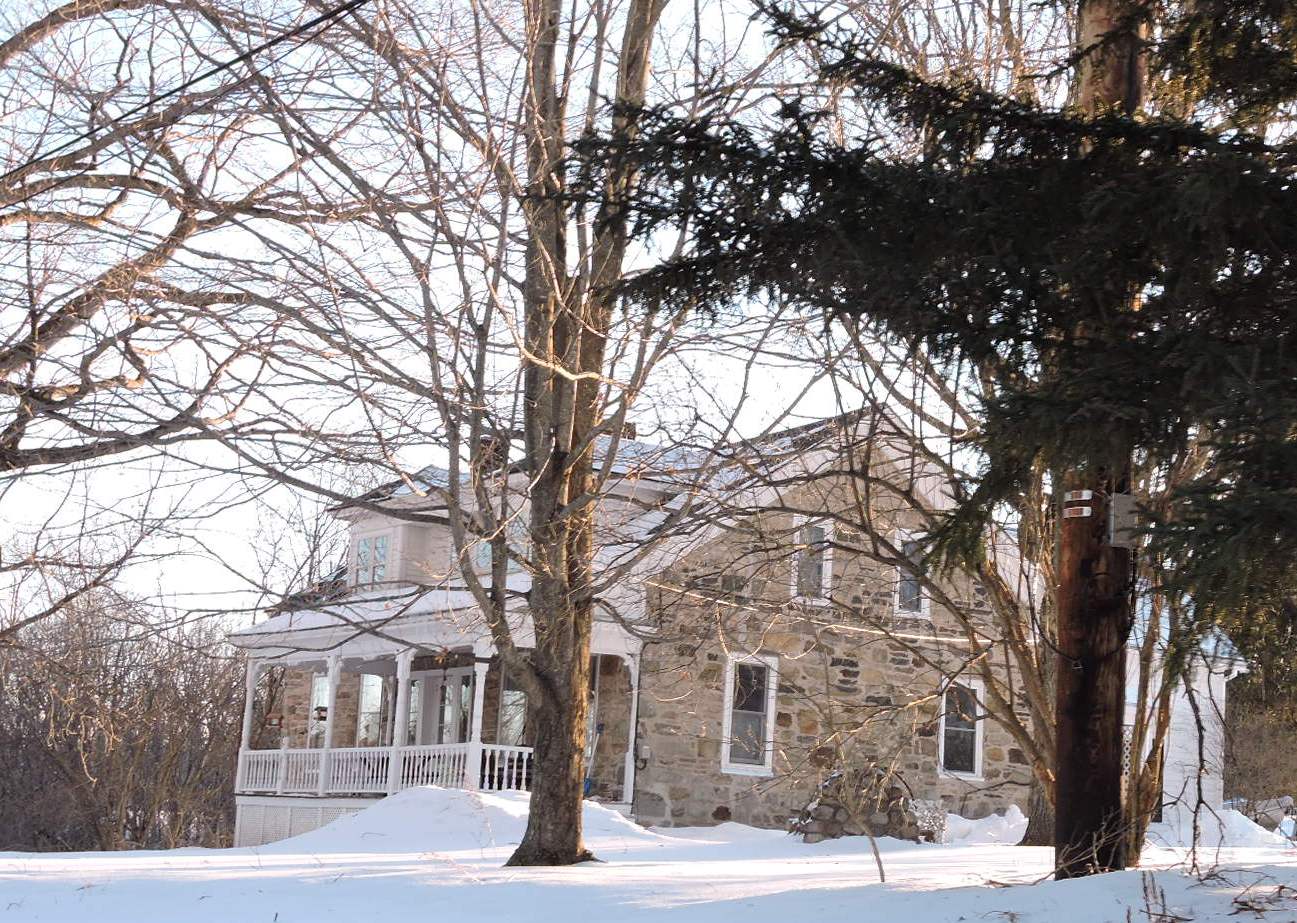
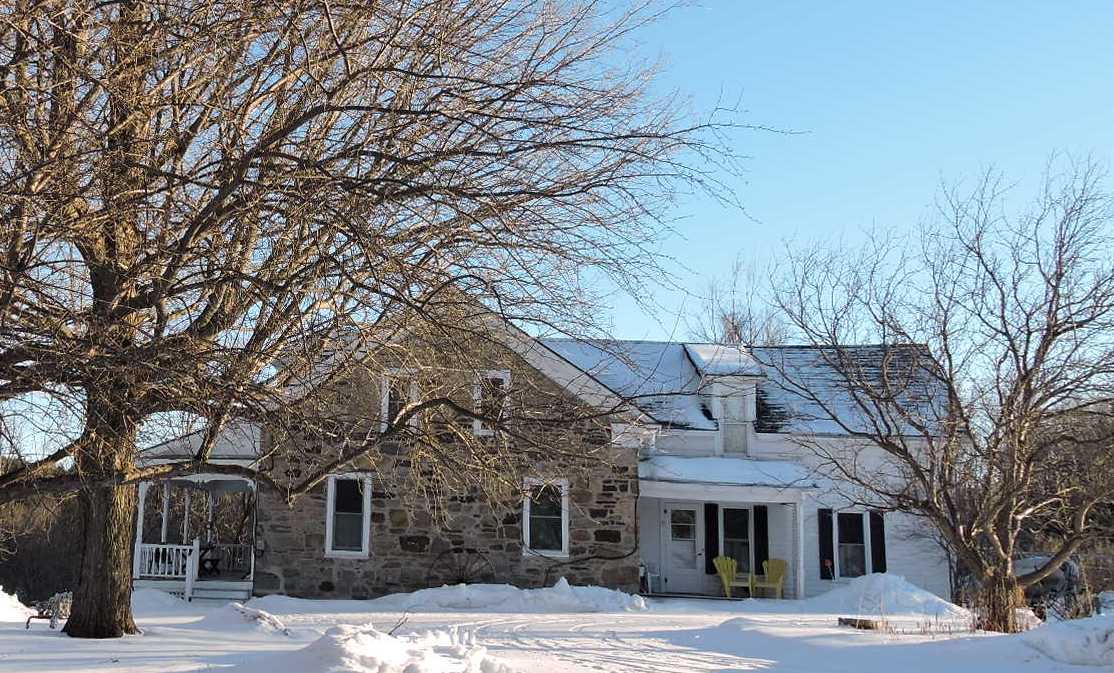
Some time after Alvin White had purchased 101 acres of land on the Canton-Russell road in the town of Canton about five miles south of Canton from Stephen VanRensselaer March 15 1817 he built this house of native stone.
It sits upon an embankment high above the road and is unique in that it was purposely built in such a position that one could, in a general way, tell the time of day from the way the sun shone into the house. "It was a beautiful little home at one time," says Reverend Charles Cotter, Montreal, who spent his early years in that area. Alvin White came into that section by ox-team from Vermont in 1805 and was one of the pioneers of the town. Thirteen years after he acquired the site of this house he sold it to Chauncey Clark on December 28 1830. The house had been constructed by White some years before that.
Clark was among the many Clark families that located not far from each other in the adjoining towns of Canton and Russell. Among them were Hubbard, Walter and Zadock Clark who were chosen highway overseers at the first election of Canton town officers at the meeting held at Stillman Foote's house March 4 1806. At the first Russell town meeting March 27 1807 Azel and Joel Clark were elected highway overseesr of that town. They had settled there in 1805 and 1806 as also did Samuel and Philetus Clark.
Chauncey Clark died intestate and unmarried October 9 1843. His mother, the former Miss Hepzibah Jones, was the widow of Samuel Clark, and with her other children, Edmond, John, Linus, Rhoda A and Hepzibah Jr, inherited this estate. On March 27 1846 Misses Hepzibah and Rhoda acquired the interest of all of the others except the mother, who later conveyed her interest to them also. For a quarter of a century after that these two spinster sisters resided on and operated the farm with the help of some of their brothers. Then on December 2 1870 they sold it to James C Matthews for $6,000. Incidentally, it should be said that when a postoffice was established in North Russell in February, 1848 Linus Clark, a brother of these two sisters, became the first postmaster.
James C Matthews died in 1873 leaving Celestine M Butterfield, Elmer J, Clara E and Albertus F Matthews, his children. By referee's deed this property was conveyed from the Matthews estate to Frank P Shean on March 19 1881. Next on April 2 1884 Shean sold to Orson Wallace, who contracted to dispose of it to Christopher Riley. Mr Riley and family occupied the farm for a number of years but did not consummate a purchase and on October 14 1889 Orson Wallace sold the house, buildings and 101 acres plus other lands to Edwin Wallace for $18,000.
Edwin Wallace was the grandfather of Mrs L Byron Stevenson of this city and died May 23 1902 when this farm went to his three sons, Charles, Alvin and Henry. On December 31 1902 Alvin and Henry Wallace sold their interests to their brother Charles, who was Mrs Stevenson's father. He kept the place until January 6 1911 managing it meantime, and then disposed of it to Sherman W Brown. Mr Brown replaced the original small-paned windows with modern ones, built a verandah and kong dormer across the front besides executing a considerable amount of other modernization. For 33 years after that he and his family resided there and on November 14 1944 sold it to Chester W Risnett, a garage proprietor now residing at DeKalb.
The Clark family ownership of this house and farm was the most extensive of any, covering a period of 40 years, but it is of interest that Mrs Forrest N Poole, now residing on the Canton-Russell road, is a great-granddaughter of Alvin White, the original owner and builder of the house. Charles Wallace, who became owner of the property more than 50 years ago, was a grandson of Matthew and Martha Wallace who came from Vermont to settle near Parishville in 1807 later transferring in 1821 to the Brick Chapel section of the town of Canton, where Charles and his two brothers, Alvin and Henry, were born. They were sons of Edwin Wallace and the birth of Charles Wallace took place on March 29 1845. He was married to Miss Elizabeth Williams, native of Potsdam, oh March 19 1873.
Mr and Mrs Wallace resided in the Brick Chapel locale until 1905 when they retired from farming and moved into Canton village. Mr Wallace, whose father was a cousin of General Lew Wallace, Civil war hero and author of the celebrated novel "Ben Hur" and other works, served some years as an assessor of the village of Canton.
Charles Wallace died in this city February 12 1921 at the age of 76. His widow, Mrs Elizabeth Williams Wallace died in Hermon June 7 1938 aged 93.
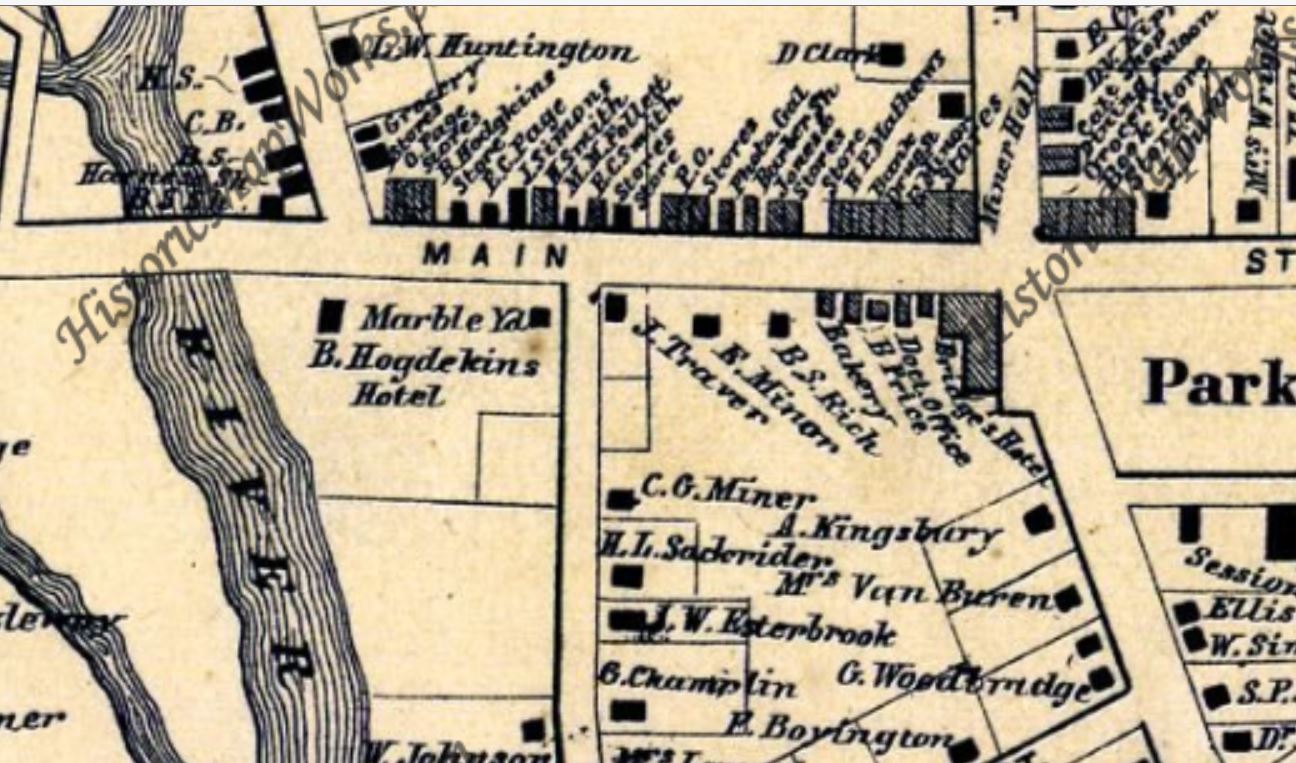
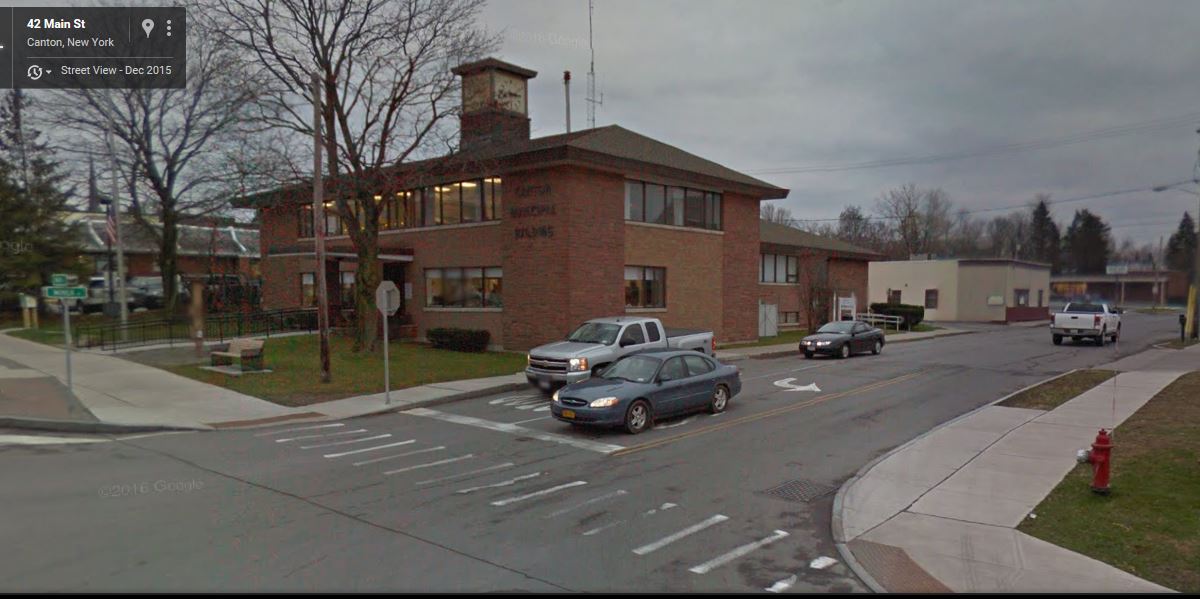
While some Canton historians say this fine old century, or more, frame house just off Main Street and just back of the town hall was the former Jeremiah Traver house and removed by Traver from the town hall site on Main Street to Miner Street when the town hall was built in 1878 there are others who scout this idea and declare that the house was probably built where it now is by Miner a few years after he came in 1828 to Canton.
Ebenezer Miner, born at Cornwall, Vermont, November 23 1794 son of a farmer, was one of Canton's most prominent early settlers and promoters. Taken ill early in the 19th century while en route from Vermont to Canada to secure work, he became a clerk in Bacon & Averill's store in Ogdensburg. There he remained until 1828 when he removed to Canton, where he had been in 1825 to set up a branch store for Bacon & Averill. After 1825 he and E N Fairchid established themselves in business in Ogdensburg, operating it until he transferred to Canton.
In 1829 he married Miss Eliza G Campbell, daughter of Dr Daniel Campbell, who came to Canton in 1807 as the village's second physician, and when Dr Campbell died Mr Miner who had built an ashery, engaged in the lumber and potash business, bought the interests of the other Campbell heirs. He built many buildings in Canton including the brick Mmer block on Main Street and the big brick residence, also on Main Street, which he occupied next to the town hall until his death September 16 1871.
He was a founder of the St. Lawrence Agricultural society in 1851 was
village president in 1859 1865-6-7 was a director and promoter of the
Watertown & Potsdam railroad and largely responsible for the bringing
of it through Canton. He built the first section of plank road in that
area and also built the first Canton sidewalk. He also superintended the
building of the academy at Canton and retired from active business in
1855. He died, leaving a widow and the following children: Mrs D D (Elizabeth)
Wead, Sheldon, Vermont; Mrs Frank (Catherine) Banksmith, Memphis, Tennessee,
and Mrs Richard B (Mary L) Ellsworth, Canton, which lineage is interesting
in showing that the ownership of this house remained in the family until
the present owners. Clarence T and
Celia O Murphy, bought it May 10 1944.
The house now designated 11 Miner Street, occupies a part of the 2.47
acres lying on both sides of Miner Street which Stephen VanRensselaer
sold May 13 1819 to Samuel Hutchinson and Sartwell Prentice, the latter
builder of the old American house in 1824. Prentice shortly conveyed his
interest in the 2.47 acres to his heirs and Miner bought out the Hutchinson
interest in 1853.
As for the town hall lot, on February 7 1817 VanRensselaer sold .75 of
an acre to Ephraim Bridge and Jeduthan Farwell. Bridge sold his interest
to Farwell July 7 1820 and November 28 1821 Farwell sold all to Truman
Hopkins for $1,000. For the same price Elias C Page bought it from Hopkins
January 3 1828 and on September 18 1840 Ebenezer Miner purchased it from
Page. If the house were built on the town hall lot it is likely that Miner
constructed it about that time for on September 26 1859 he sold it plus
162 feet of his lands on the south for $2,500 to Jeremiah Traver, who
operated a large tannery. This deed mentions a dwelling house upon the
lot. Traver went bankrupt and his trustee sold the town hall site and
house plus other lands to Lucius Moody for
$3,725 on October 2 1874. Moody sold the south 50 feet to Thomas Field
November 19 1877 for $1,000 and Field conveyed it to Mrs Eliza G Miner,
after whose death a quarter interest each went to Mrs Mary L Ellsworth,
Mrs Elizabeth Wead, Mrs Catherine Banksmith and James F Pierce who sold
it with other lands to Richard B Ellsworth, Canton clothing merchant,
husband of Mary L Miner Ellsworth and son-in-law of Ebenezer Miner. Back
of the town hall lot VanRensselaer sold 2.17 acres to Joseph York December
31 1816 and by October 18 1827 one acre of this had come into the possession
of George Campbell, who sold it with other lands to Ebenezer Miner February
24 1832 for $425 and as this was but three years after Miner located in
Canton it may well be that he built the house there then.
As Ebenezer Miner died intestate this property also went to his widow and children, and with the town hall site was purchased by Richard B Ellsworth December 31 1892 for $24,000. Mr Ellsworth resided there until his death June 18 1894 and through ensuing transactions his widow acquired the interest of the other heirs and occupied the brick house on Main Street. J Stanley Ellsworth, prominent Canton shoe merchant and son of Joseph B Ellsworth, occupied this white house until Mrs Mary Ellsworth died April 5 1916 and then moved into the brick house, he having received from her a use of one third of her estate during the life of Catherine Miner Banksmith, after whose death this third was to go to Mrs Anna Ellsworth Poste and Miss Fannie Elizabeth Wead. Each of the other thirds of Mrs Mary L Ellsworth's estate went outright to Mrs Mary Wead Weeks and Miss Fannie Elizabeth Wead.
After J Stanley Ellsworth moved from this white house to the brick house, Miss Fannie Elizabeth Wead, who was for 25 years librarian of Canton's public library until her death November 16 1939 resided in this white house. Miss Wead willed her interest to Mrs Mary Wead Weeks, who had acquired Mrs Anna E Poste's interest by purchase August 22 1921. Thus on May 10 1944 Mrs Weeks disposed of the property to Mr and Mrs Murphy.
But it will long be remembered as the home of the Ellsworths and of Miss Wead, who was directly descended also from Ebenezer Miner, for her mother Mrs DeForest (Elizabeth Miner) Wead, was one of his daughters, and Richard B Ellsworth's wife was another. Miss Wead herself was born at Sheldon, Vermont, and educated at St. Johnsbury academy in Vermont, coming to Canton after the death of her parents. She was a sister of Mrs Weeks and of Charles M Wead.
